

See teaser video below

A project of

In partnership with

EXHIBITION BRIEF
“Fifty Years of Philippine Design and Beyond” is an exhibitionary gesture by the Design Center of the Philippines on the 50th Anniversary of its foundation in 1973. It commences and anticipates other potential projects—publishing, educational material, traveling exhibitions, public discussions, and so forth—that in due course will clarify Philippine Design as a distinct ethos and aesthetic.In its present first incarnation as an exhibition, the fifty-year retrospective is a gathering of objects and images that represent striking “moments” during which radical or surprising shifts occurred in the ways designers design in the Philippines.Each selected object or image was created by change-makers; each, the arrival or refinement of ideas of how to dress homes and selves, express personality, assert identity, and give detail to reality. Through the 50 years spanning the turn of the millennium, these consist of the pivotal objects that Filipinos created and successfully introduced to daily lives locally and overseas.The objects and images are organized chronologically. They constitute a timeline that is curatorially pitched to say that the changes built one over the other, and that such cumulative change in design shaped definitions of what constitutes quality of life across sectors and classes in the Philippines and elsewhere.
The exhibition is also curatorially conceptualized to encourage viewers to look with a historian’s eye at the objects they live with. Certain ways of living life began at certain points in history, with ideas embodied in designed objects and pictures that reimagine the world. The objects are ideas, and each contains a historical moment.Over the last 50 years, the ideas embodied by objects and images designed by Filipinos show increasing precision understanding of global commerce these accoutrements of life. This precision understanding notably involved drawing deep from Philippine traditions, which were never abandoned in the embrace of globalized trade.Design Center of the Philippines conducted Focus Group Discussions to collectively articulate Philippine Design, and convened a jury of peers to select the featured designers for “Fifty Years…” The exhibition’s Curator therefore built on the insights of designers themselves.Curator
Marian Pastor Roces
Exhibition Designer
Architect Royal Pineda
ABOUT ART x DESIGN
EXHIBITION LAUNCH
In commemoration of the National Arts Month, the 50 Years of Philippine Design and Beyond Exhibition will unveil the expansion of the previously launched exhibition to include the section of Arturo and his peers featuring National Artists during the time of Arturo R. Luz, the inaugural Executive Director of Design Center as a National Artist for Visual Arts.A key highlight of the ART X DESIGN program is the special reception on the 23rd of February that will be a launch of the expanded exhibition with the new objects added to the exhibition as well as a formal launch of the educational programs and various activations in celebration of the 50 years of Philippine Design and Beyond Exhibition.The reception aims to invite His Excellency, President Ferdinand R. Marcos, Jr., and First Lady Louise Araneta Marcos, including members of the Cabinet, Senate, House of Representatives, the Diplomatic Corps, and key stakeholders of the Philippine Creative Industries.
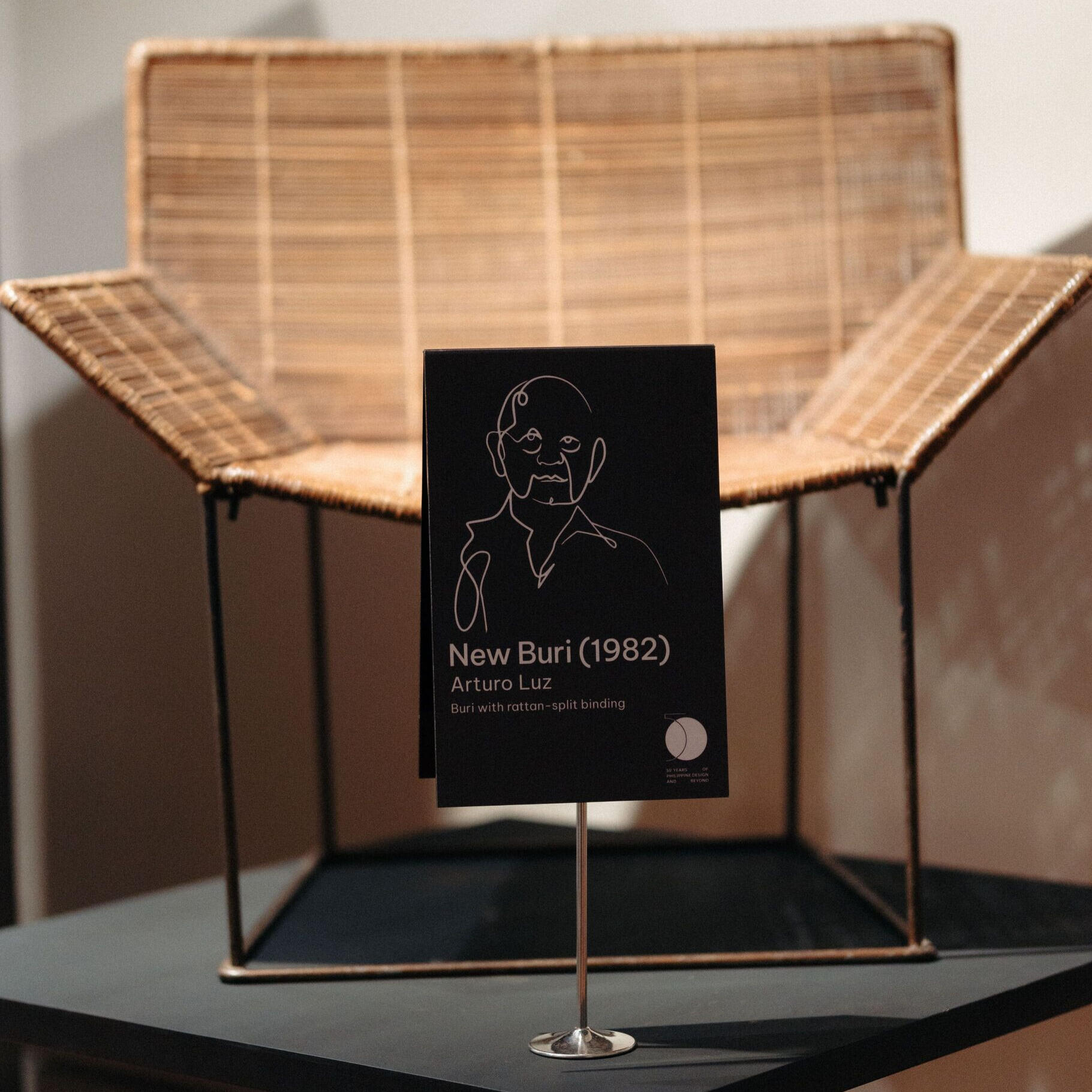
ABOUT DESIGN CENTER OF THE PHILIPPINES
Since its creation in 1973 through Presidential Decree No. 279, Design Center of the Philippines has been at the forefront of pushing a national design agenda directed at driving global competitiveness and uplifting the quality of life.Propelled by the Filipino value of malasakit, Design Center’s efforts go beyond promoting the value of good design and onto inspiring industries to create innovative human-centered solutions to address and anticipate challenges, shifts, and disruptions of the fast-changing and currently uncertain times. The agency also serves as a nucleus of the creative and design communities in the Philippines, fostering synergy and collaboration among them, the academe, the government, and innovation partners.Design Center stands on a foundational history of design excellence and five decades after its establishment, the Center is moving forward to inspiring the next fifty years of Filipino ingenuity and creativity.
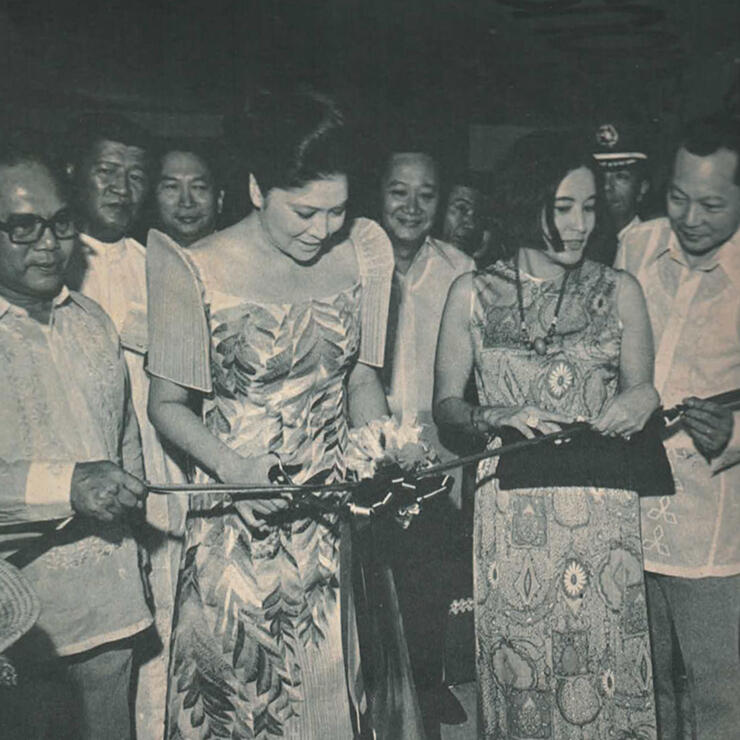
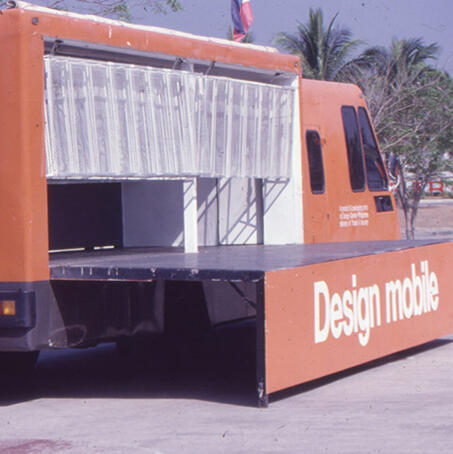
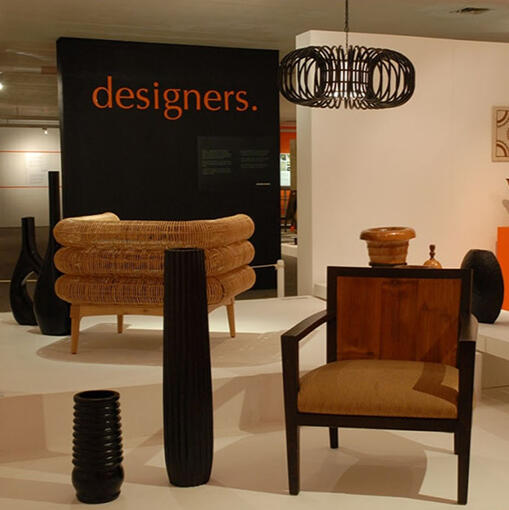
FROM DESIGN INTERVENTION TO DESIGN SOLUTION
The value of good design lies in the breadth of opportunities it creates for the designers as well for the life-improving benefits to its end users. Throughout the history of Design Center, the agency championed design’s role as a creative, strategic, and innovative tool for positive development that make an impact in the Philippines and in the world.The pioneering years of Design Center paved the way for innovative design in the development of Philippine products and handicrafts, forged new mindsets with an intensive design education program, and reenergized the country’s cottage industries centered on Philippine craftsmanship. This design-led economic movement in the quality and global competitiveness of Philippine non-traditional export products put the Philippines in the design map, supported by the country’s prolific furniture designs that masterfully blended indigenous materials with local craft skills.The Design Center carried an energized design appreciation from local and global markets onto stimulating the growth of more MSMEs, particularly those in the countryside, through intensified design intervention appropriate to the capabilities of the manufacturers, with the emphasis on good design as good for business. This signaled the birth of design-driven sectors in Philippine businesses and manufacturing industries.The passage of the Philippine Design Competitiveness Act in 2013 strengthened Design Center’s role in cultivating the country’s creative capital and design culture, and in integrating design to accelerate businesses and sustainable national progress. To this end, Design Center broadens the strokes by which design is used to create new value, new markets, and new user experiences that enable inclusive and sustainable economic growth.Such progress on the course of Philippine design circles back to the words of the agency’s inaugural executive director (1973 – 1987) and National Artist for Visual Arts Arturo R. Luz in a speech on the objective of design: “products must be efficient, original, and competitive. It must be well made, safe, and durable. It should be simple to make and use. It should be easy to look at, touch and feel. It should also provide benefits to the maker, seller and user. And it should lead to other systems and solutions.”
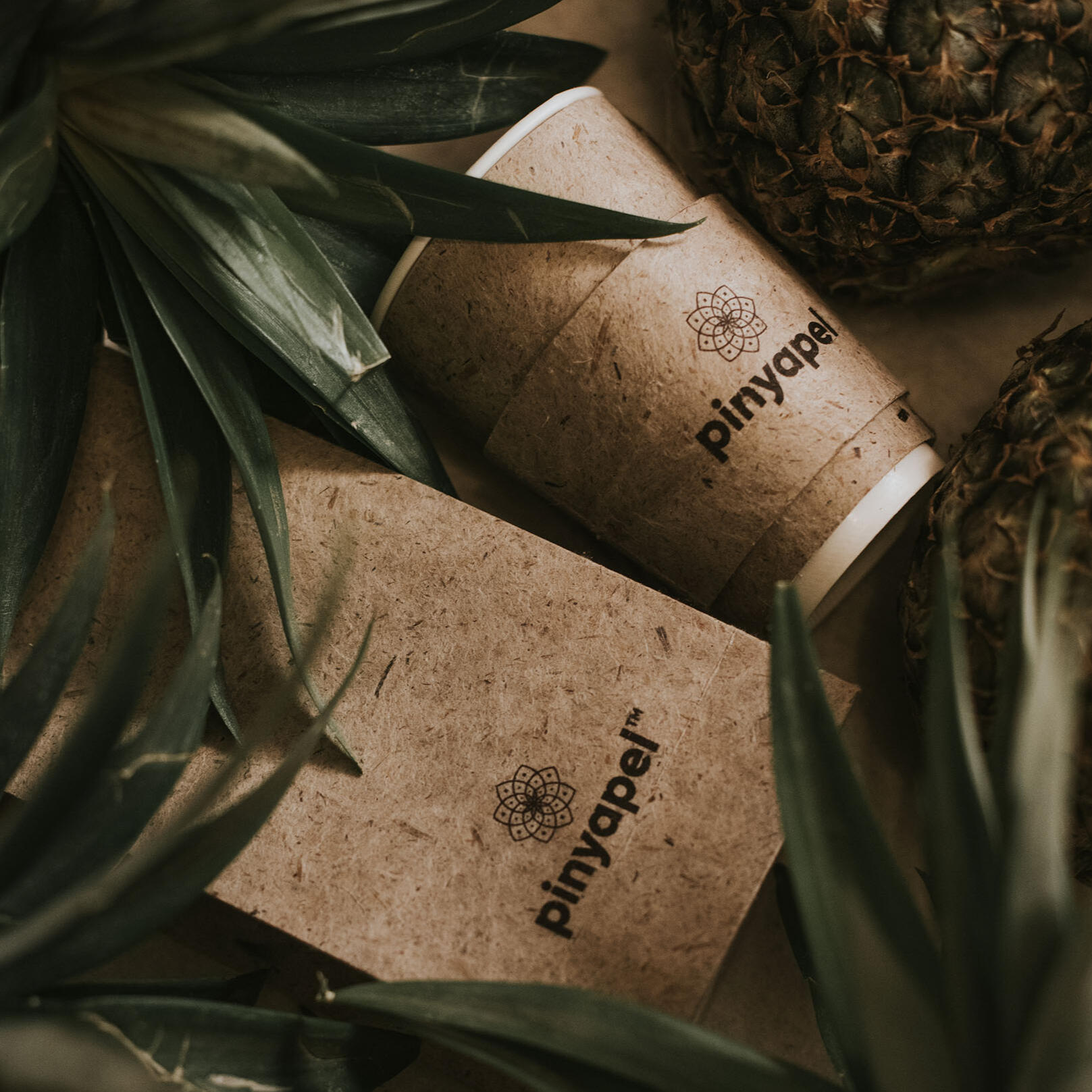
DESIGN FOR COMPETITIVENESS AND INNOVATION
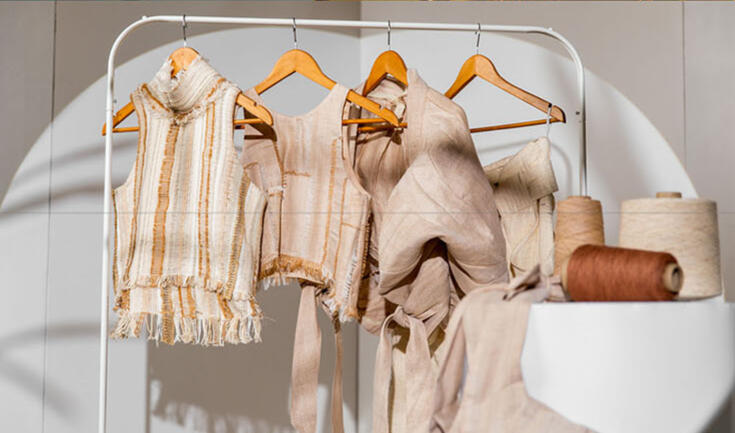
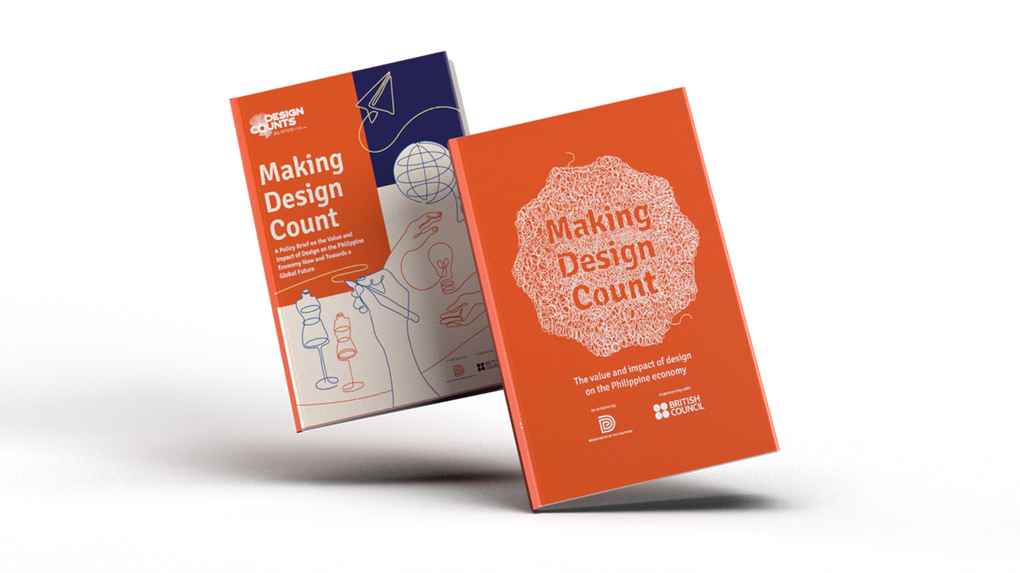
From design interventions to boost livelihood and enhance craftsmanship, design is now seen as an integral element for strategic transformation, providing an array of opportunities for value creation to boost national competitiveness and innovation, including addressing bigger systemic social and global problems.As Design Center’s present Executive Director Rhea O. Matute says: “Design is an essential human skill for the 21st century - driving the creation of responsible and intelligent products, services and systems of the future. Therefore, we have the immense responsibility to use our design skills and expertise not simply for aesthetics or to make things beautiful but to create a just society and sustainable economy for all.”With the magnitude of such goal in mind, the Design Center bolsters the promotion of a more intentional and critical use of design, anchoring its programs and projects on a quadruple bottom-line approach involving people, planet, prosperity and purpose. Moreover, the Design Center integrates the Philippine value of ‘malasakit’ (loosely translated in English as compassion) at the core of Philippine design.The Design Center reinforces its Design Innovation thrust to elevate the country’s resources towards innovative solutions, advancing its design agenda through forward-looking research and development that combines creativity and strategy to bring together design and business to improve the quality of life.Design Center also works toward making Design Thinking a national competency to increase the Philippine design industry’s economic and employment contribution. The Center is committed to building the next generation of globally competitive Filipino designers, equipping them with the mindset and skillset needed to drive innovation.Further, Design Center leads the way in raising awareness on the value of design and creativity through its design events that inspire good design and innovation for nation-building. Design Center hopes to connect Filipinos to good design and Philippine design to the world by serving as a hub for creative minds to exchange ideas, share experiences, and explore solutions to create systemic and strategic changes.Underpinning the value of design in the country’s economic, social and cultural dimensions, Design Centers is optimistic that design will be made more accessible and responsive to the diverse needs and aspiration of the Filipino people of today and future generations.
DESIGN FOR ALL
For the years ahead, Design Center envisions a nation built on a strong foundation of design culture, equipping and inspiring every Filipino with the right tools to create freely, to design purposefully, and to innovate boldly.The agency also looks forward to a nation navigating through inevitable movements and requirements in the future, where design is an embedded and necessary driving force in the constant improvement of the quality of life
for all.
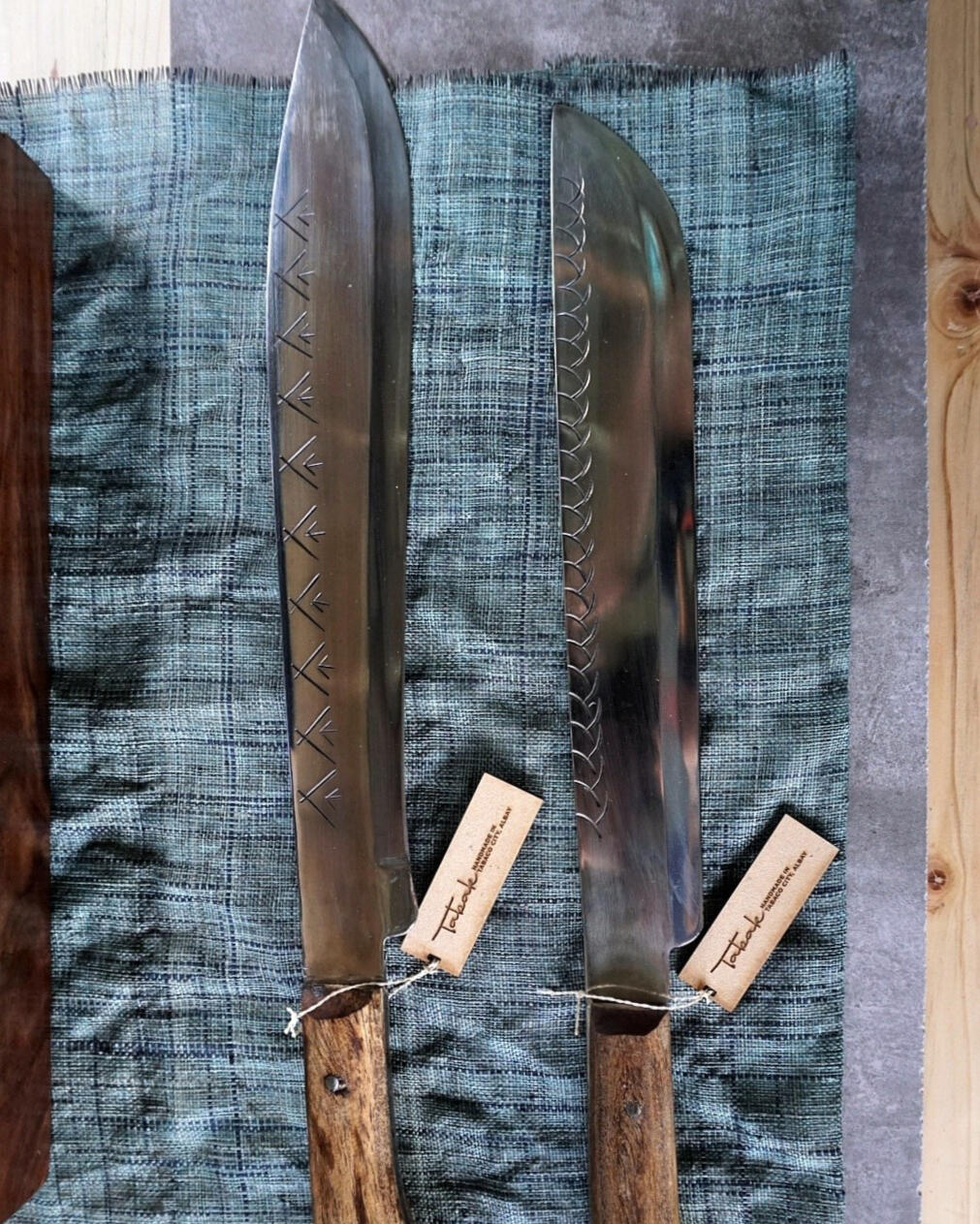
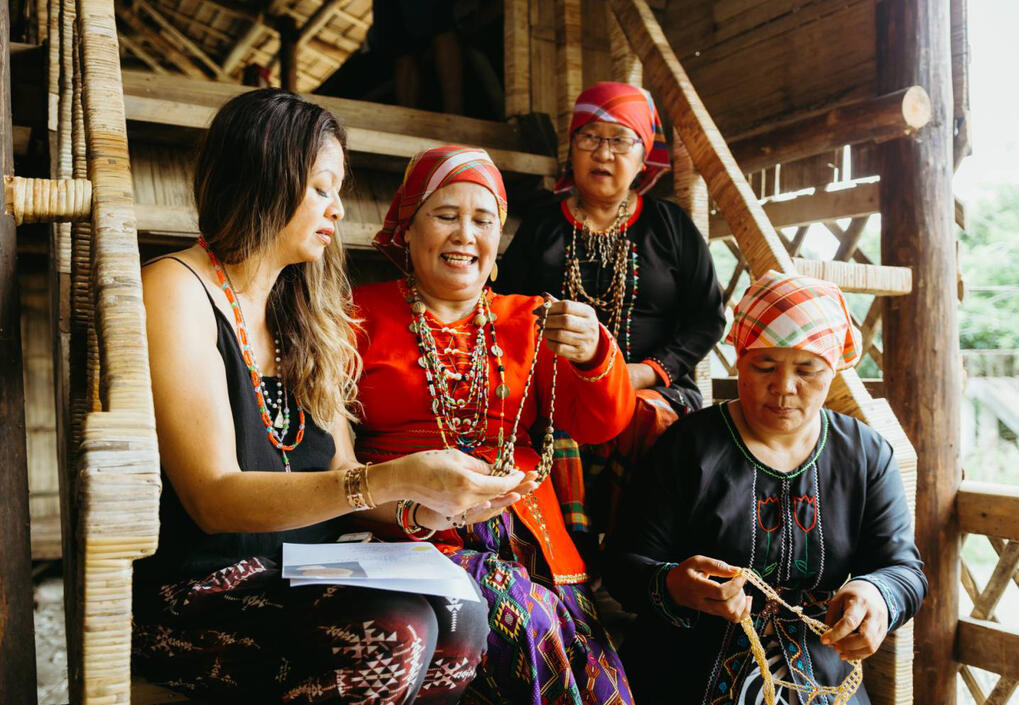
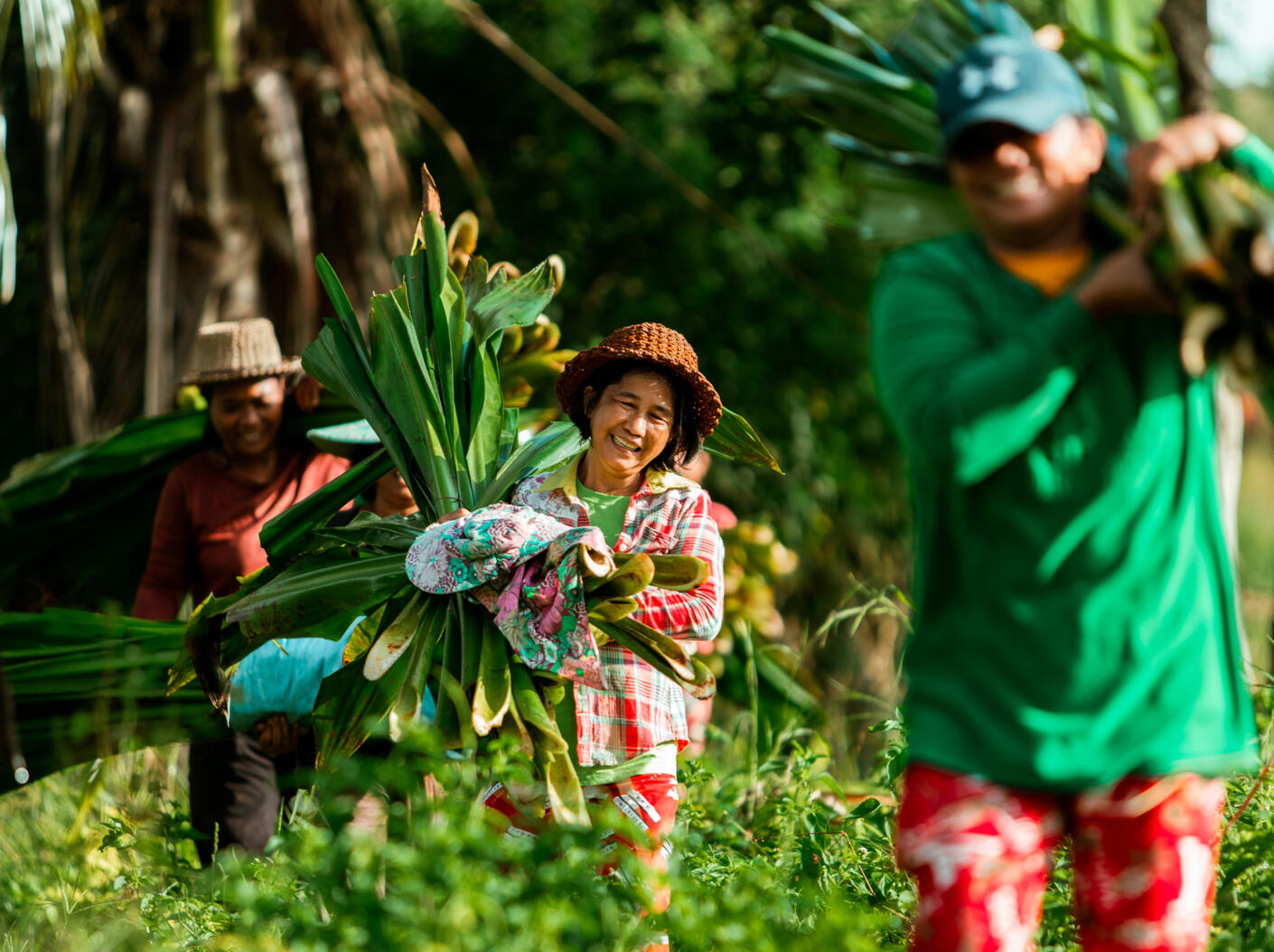
A project of

In partnership with

1973 - 2000
The field of design picked up momentum towards becoming an integrated set of practices straddling artistry, commerce and trade, technology, and traditional art research in the 1970s. That Design Center of the Philippines was also established in this pivotal historical moment suggests an interconnected dynamics. As massive cultural change broke out globally—transitioning Modernity into its denouement—the Design Center and the designer/manufacturer communities took the period instabilities as opportunities for pioneering work.Staged to coincide with the 50th anniversary of the Design Center, this exhibition nevertheless encompasses the greater context in which designers worked in the Philippines—whether in relation to stimuli from the Design Center or entirely independent from this agency’s initiatives. It is through this macro view that preliminary syntheses are possible, with regard to a matter that has come to be of substantial concern: is there a normative approach to materiality, a sensibility, or a way of thinking that can be described as constituting Philippine Design? The answer unfolded slowly, and would not be strikingly clear until the arrival of the next century.
Philippine Design began to be construed as such as Filipino designers defined their field as self-aware of its difference from art; as Filipinos wholly took up the idea deploying creative effort for specific markets, during the period between the 1970s and the turn of the millennium in the year 2000. The word design found wide application, encompassing graphics, furniture, gifts and houseware, interior, film and theater production, architecture, fashion, comics, advertising and image-making, photography—with multiple overlaps with the world designated as art. It was clear, however, that the divergence of design from art involves the former’s embeddedness in markets, and the latter’s sustained critique of systems, including markets.
A project of

In partnership with

1973 - 2000
Mezzanine Level
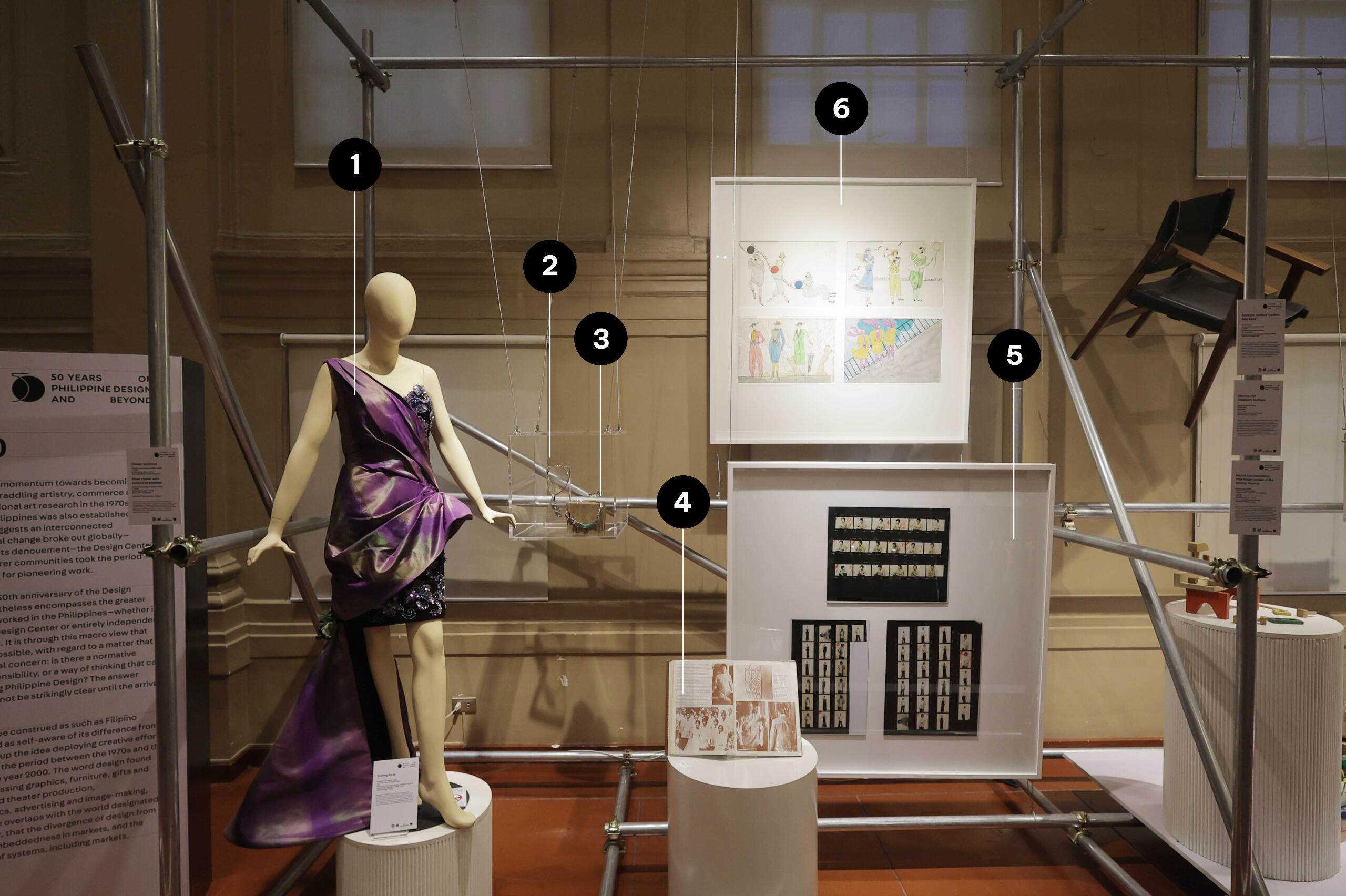
1
Evening Dress
Salvacion Lim Higgins, design
Laureate, Order of National Artist
1990
Cloth pouf construction, draping, tailoring, beadwork
Fabric (Italian silk taffeta, velvet), beads
Collection: Mark HigginsSalvacion Lim Higgins was already the unusual woman couturier of note in the Philippine postwar years, and came to the 1970s an iconic fashion figure. She dressed and co-created the collective character of the Filipina who had become part of the work force; who needed no-fuss but striking clothes; and who needed to project individual power. Higgins did not dress this woman as much as she co-produced the required persona.
2
Choker necklace
Eduardo de los Santos Castrillo, design
c. 1970s
Metalworking, gem-cutting
Gold-plated silver, handcrafted jade
Collection: Marie Jeannie E. Javelosa
Eduardo Castrillo, well known for massive Expressionist sculptures in public spaces—often with historical themes—also created jewelry. His pieces exhibit formal, geometric themes shared with his large-scale work. Hence typically described as sculptural, the pieces appealed to Filipinas cultivating a Modernist taste in a Philippine cultural milieu undergoing intensified globalization.
3
Silver choker with
sculptured pendant
Eduardo de los Santos Castrillo, design
c. 1980s
Metalworking, gem-cutting
Silver, gold-plated silver
Collection: Marie Jeannie E. JavelosaEduardo Castrillo, well known for massive Expressionist sculptures in public spaces—often with historical themes—also created jewelry. His pieces exhibit formal, geometric themes shared with his large-scale work. Hence typically described as sculptural, the pieces appealed to Filipinas cultivating a Modernist taste in a Philippine cultural milieu undergoing intensified globalization.
4
Period Documentation
The Barong Tagalog: The Philippine National Wear
Visitacion R. De la Torre, author
1986
Offset printing, bookbinding
31 cm
Paper
From the Design Center of the Philippines Library
5
Period Documentation
Piña blazer version of the barong Tagalog
Helena Carratalà, design
1983
Illustration
117 × 117 cm
Colored pens, watercolor on paper
Collection: Katya GuerreroHelena Carratalá, Catalán fashion designer, founded the design boutique Azabache in the 1970s, with its atelier in Malate, Manila. She had relocated to the Philippines from her birthplace in Barcelona, Spain. Azabache became 1970’s Manila’s center of gravity of contemporary chic, drawing a coterie of models, other fashion designers, stylists, and trend-setters whose tastes contrasted strikingly with the Filipiniana emphasis of the Filipino male couturiers. Carratalá’s esprit also had a contrasting democratizing bent. She pioneered ready-to-wear, working with the SM Group.
6
Sketches for Azabache, boutique
Helena Carratalà, design
1983
Illustration
117 × 117 cm
Colored pens, watercolor on paper
Collection: Katya GuerreroHelena Carratalá, Catalán fashion designer, founded the design boutique Azabache in the 1970s, with its atelier in Malate, Manila. She had relocated to the Philippines from her birthplace in Barcelona, Spain. Azabache became 1970’s Manila’s center of gravity of contemporary chic, drawing a coterie of models, other fashion designers, stylists, and trend-setters whose tastes contrasted strikingly with the Filipiniana emphasis of the Filipino male couturiers. Carratalá’s esprit also had a contrasting democratizing bent. She pioneered ready-to-wear, working with the SM Group.
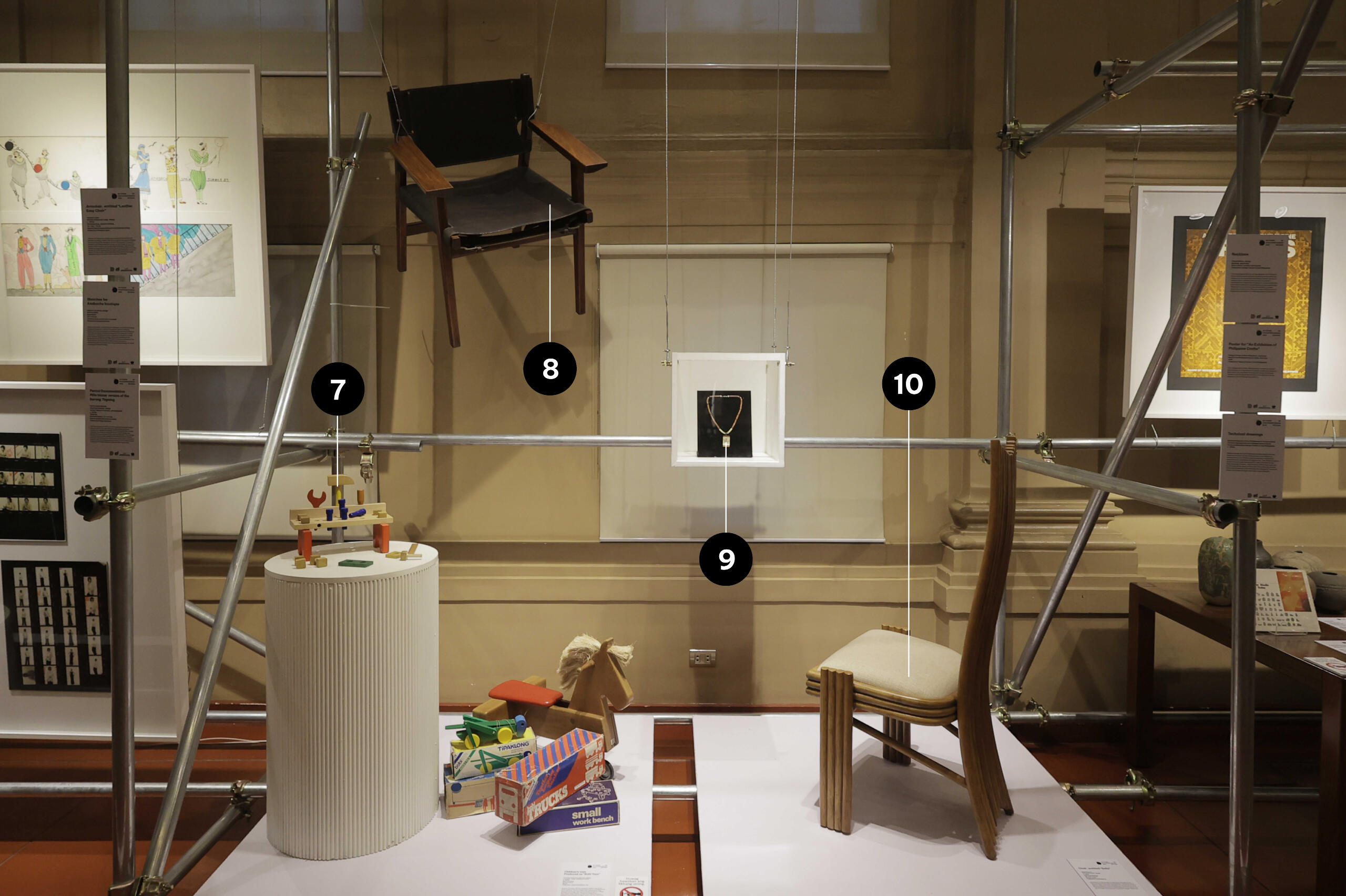
7
Children’s toys
Produced as “Bobi Toys”
Architect Francisco Mañosa, design
Laureate, Order of National Artist
c. 1970s
Woodworking
Various sizes
Wood
Collection: Tukod Foundation, Inc.Architect Francisco Mañosa designed children’s toys in the 1970s, based on his own material rearticulation of Philippine life and imagination. The toys collectively maintained its lively dialogue with foreign-sourced toys widely bought for children since the postwar decade. These were designed as alternatives, which furthermore allowed children to have a feeling for wood instead of plastic, and modularity instead of molded materials.
8
Armchair, entitled “Leather Easy Chair”
Alfonso Nakpil de Lange, design
c. 1970s
Woodworking, leather crafting
70 × 54 × 79 cm
Narra (Pterocarpus indicus) and Carabao leather
Collection: Designs LignaAlfonso “Al” Nakpil De Lange was among the small circle of pioneers working closely with Arturo Luz at the nascent Design Center in the 1970s. Recipient of the first license in Industrial Design in the Philippines, De Lange concentrated on furniture design; distinctively, the unadorned, emphatic lines of wood “drawing diagonal verticals and structural horizontals in space.” His use of noble hardwoods like narra (the Philippines’ national tree) in furniture that cites International Style cued younger designers about virtuoso cross-cultural combines.
9
Necklace
Chiye Oshima, design
Beading, engraving
Bone, wood, ceramic tube beads
Collection: Design Center of the PhilippinesThe Japanese American writer, jeweler, and designer Chiye Oshima was a close friend and collaborator of Arturo Luz. As consultant the Design Center during its earliest days, Oshima took the lead in product development in the areas of personal accessories and gifts and houseware—herself prototyping a seemingly endless array of boxes, costume jewellery, paper products, and so forth. She was a keen afficionado of indigenous patterns from different parts of the world.
10
Chair, entitled “Bella”
Arthur Edwards, design
Mehitabel Inc., manufacturer
c. 1984
Rattan lamination
55 x 55 x 118 cm
Rattan poles
Collection: Mehitabel Inc.Mehitabel Inc has through the decades reimagined the chair as both Filipino and cosmopolitan. The use of rattan poles in “Bella” was a new direction for its time. Prior to the general realization that the previously ubiquitous rattan is a diminishing resource for the Philippines, innovations in its use for export furniture were important design milestones.
Page 1 of 9
A project of

In partnership with

1973 - 2000
Mezzanine Level
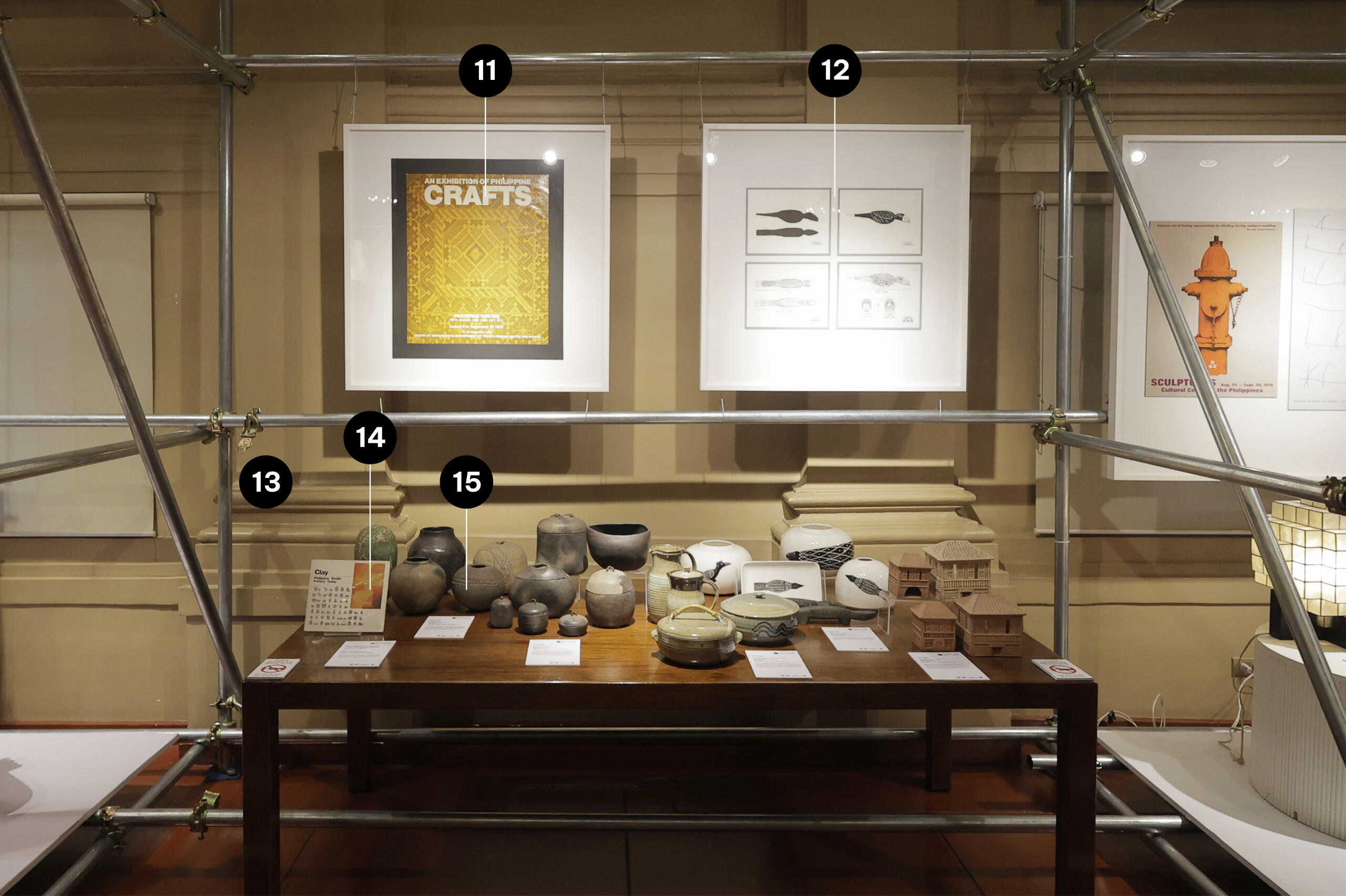
11
Poster for “An Exhibition of Philippine Crafts”
Design Center of the Philippines, organizer
Held at the Philippine Center, New York City
1976
Collection: Design Center of the PhilippinesThe Tausug head cloth, the tapestry-woven pis siyabit emblazoned on the poster of a major exhibition, staged in New York City, signaled the importance to the Design Center of the Philippines of its turn to traditional art as source of its contemporizing efforts.
12
Technical drawings
National Museum of the Philippines in-house artists
Content development for a design source book
To be published by Design Center of the Philippines
c. 1980sDesign Center of the Philippines collaborated with the National Museum of the Philippines in the 1980s in a continuation of a 1970s project to extract motifs and patterns from traditional Philippine art. The 1980s National Museum team was headed by Dr. Jesus Peralta of the Anthropology Division. The previous 1970s team was led by photographer Neal Oshima, involving new graduates from the University of the Philippines College of Fine Arts: Susan de la Rosa Aragon and Judy Freya Sibayan.
13
Period documentation
“Philippine Ethnic Patterns: A Design Sourcebook”
Dr. Jesus Peralta, author
Neal M. Oshima, original visual anthropology research
2006
Duotone offset printing, book binding
22 × 28 cm
Paper, printers’ ink
Collection: Design Center of the PhilippinesAnthropologist Jesus Peralta, Ph.D. of the National Museum of the Philippines authored the volume in 2006. The material was collected in 1974 by photographer Neal Oshima, with assistant researcher Marian Pastor Roces, and drawings by Conceptual Artists Susan de la Rosa Aragon and Judy Freya Sibayan. The idea of a design sourcebook was popular in the 1970s in the Western World when Oshima commenced the project until the period in which Dr. Peralta completed it.
14
Period Documentation
“Clay: Philippine Studio Pottery Today”
By Marian Pastor Roces
1985
Design Center of the Philippines and the Crafts Council of the Philippines
Collection: Design Center of the PhilippinesDocumentation of the studio potters of the 1970s began with this monograph. Profiled are the eight early practitioners who defined the field with their intensified activities during this period. They are Jon Pettyjohn, Tessy Pettyjohn, Nelfa Querubin, Anne and Jaime de Guzman, Kay de Lange, Leonardo Villaroman, and Julie Lluch Dalena.
15
Vessels
Kay de Lange
c. 1970s to 1980s
Stoneware-firing, glazing
Various dimensions
Clay, glaze
Collection: Design Center of the Philippines and
the family of Alfonso and Kay De LangeKay de Lange experimented with both rough and polished surfaces (and often, in combination) of vessels she shaped to evoke traditional Philippine earthenware form. Working closely with her husband, Alfonso de Lange, the American studio potter was a constant presence at the nascent Design Center. She and the other studio potters gravitated around founding Director Arturo Luz, who encouraged experimentation and facilitated raised public attention to their work.
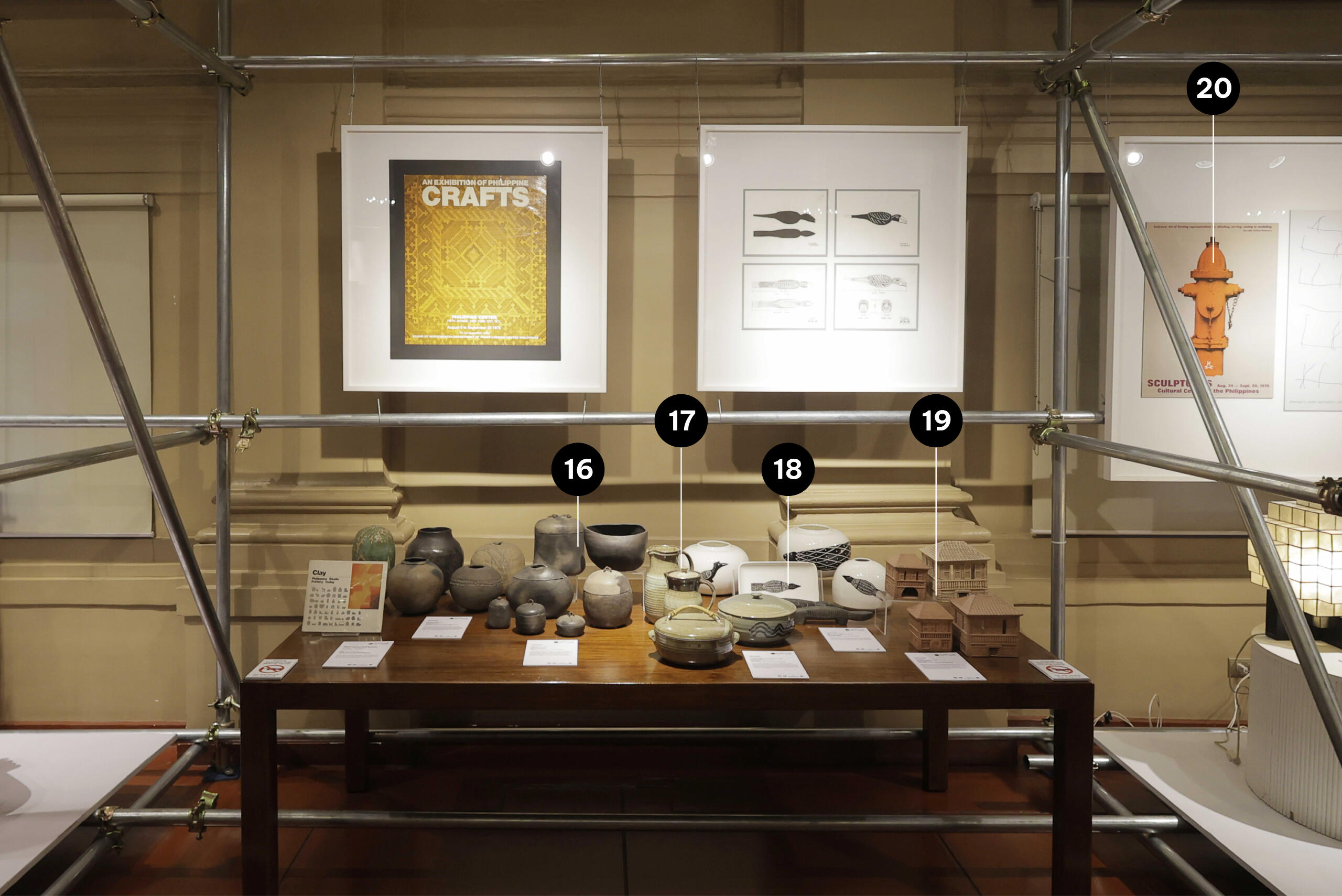
16
Vessels
Nelfa Querubin
c. 1970s
Stoneware-kiln firing
Various dimensions
Clay
Collection: Design Center of the PhilippinesThe daughter of a fisherman from Concepcion, Iloilo, Nelfa Querubin began working with clay in the 1970s. Creating vessels with a distinctive free form quality with a dark hue palette and textured, matte surfaces, Querubin’s work drew connoisseur attention quickly. Within less than a decade of work, she received the Cultural Center of the Philippines’ Thirteen Artists Award. An immigrant to the United States in 1985, she has nevertheless continued to exhibit her work in the Philippines.
17
Vessels
Jon Pettyjohn and Tessy Pettyjohn
c. 1970s to 1980s
Stoneware kiln-firing, glazing
Various sizes
Clay, glaze
Collection: Design Center of the PhilippinesJon and Tessy Pettyjohn commenced their joint careers as studio potters in the 1970s. Jon had studied ceramics in Barcelona, Spain; Tessy, New York City. They maintain different but related aesthetics in work that they have sustained through to the present, based since 1983 in a studio at the foot of Mount Makiling, Laguna. The studio doubles as a teaching facility. The Pettyjohns are regarded as forefront figures in the field of studio pottery in the Philippines.
18
Vessels
Ronald Maceda, design
1992
Slip casting, silk screening, glazing
Various dimensions
Bone china, glaze
Collection: Design Center of the PhilippinesDesign Center set about collecting traditional Philippine art to be a reference collection for its design explorations. In the case of these vessels, a selection of carved wood abstractions of animals, traditional to the Tagbanua people of Palawan, were the departure point for the white vessels in bone china by Ronald Maceda.
19
Vessels
Xari-Sari
Lorenzo Sarmiento, design
Glazed stoneware
Various dimensions
Clay, glaze
Collection: Design Center of the PhilippinesAmong the 1970s studio potters, the urge to work out of Philippine themes produced different formal trajectories. This set of traditional clay houses made to perform as lamp shades appeals to the thematic of the folksy. It is among the period set pieces that overlap studio pottery with larger market production. From the beginning of the new careers in studio pottery that gravitated around Design Center, the personal directions took individualized styles.
20
Poster for the exhibition “Sculptures” at the Cultural Center of the Philippines
Raymundo Albano, design
1970
Duotone offset printing
61 × 45.5 cm
Paper and printers’ inkDuring most of the 1970s and until he passed away in 1985, Raymundo “Ray” R. Albano, Acting Director of the Cultural Center of the Philippines’ Art Museum, designed the posters for all departmental programming of the institution. Albano is more importantly known as one of the two earliest figures in Conceptual Art and the 1970s avante-garde (with Roberto Chabet, the older figure) of the Philippines. Albano’s posters involved more than conceptualization, as he himself printed many of the designs in the offset facility of Vera Reyes, Inc.
Page 2 of 9
A project of

In partnership with

1973 - 2000
Mezzanine Level
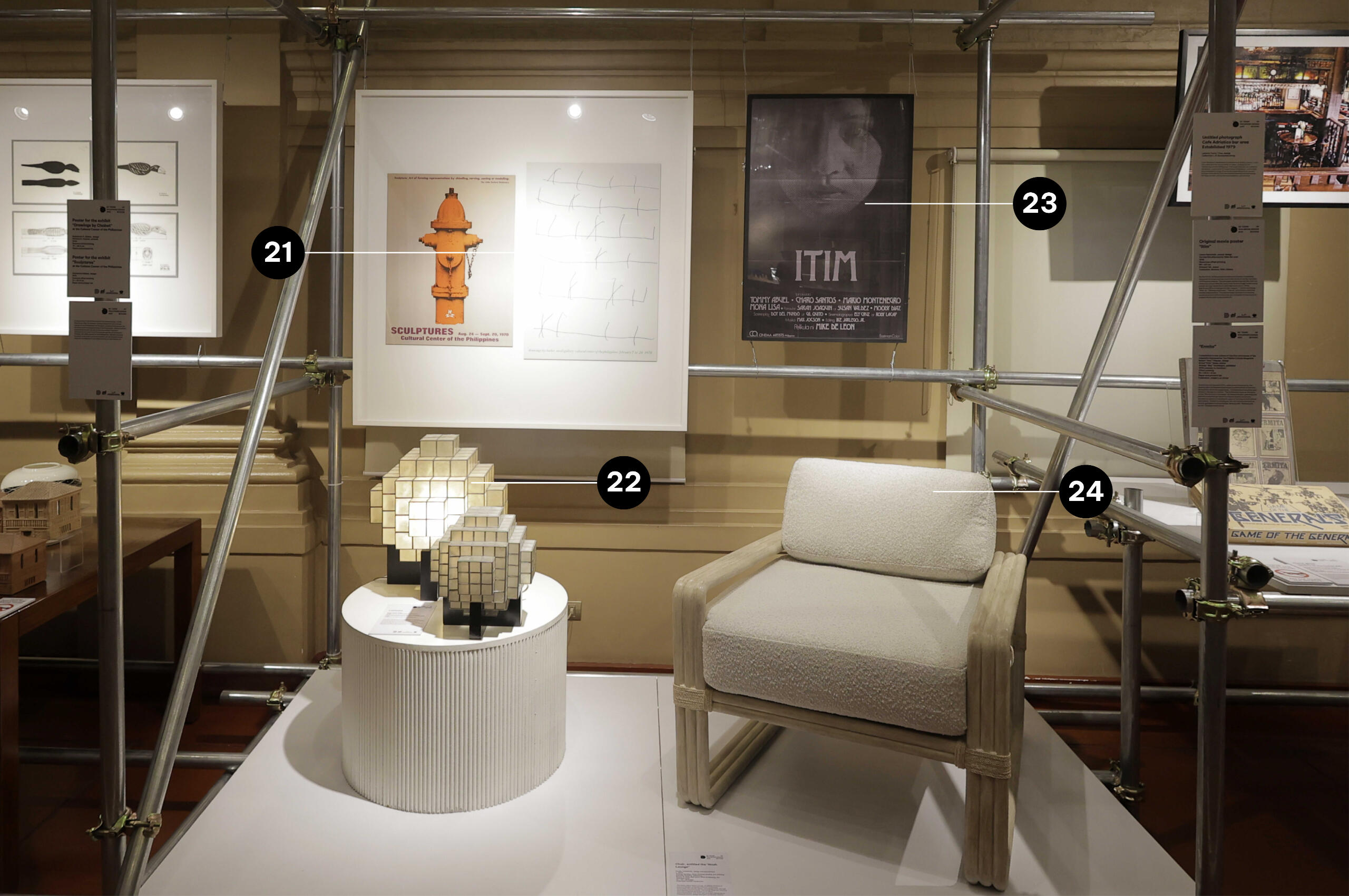
21
Poster for the exhibit “Drawings by Chabet”
at the Cultural Center of the Philippines
Raymundo R. Albano, design
Roberto R. Chabet, artwork
1978
Duotone offset printing
70 × 45.5 cm
Paper and printers’ inkDuring most of the 1970s and until he passed away in 1985, Raymundo “Ray” R. Albano, Acting Director of the Cultural Center of the Philippines’ Art Museum, designed the posters for all departmental programming of the institution. Albano is more importantly known as one of the two earliest figures in Conceptual Art and the 1970s avante-garde (with Roberto Chabet, the older figure) of the Philippines. Albano’s posters involved more than conceptualization, as he himself printed many of the designs in the offset facility of Vera Reyes, Inc.
22
Lamp
Steve Daplas, design
Design Center of the Philippines prototype
1970s
Capiz shell and metal framing, electrification
Capiz (windowpane oyster, Placuna placenta), brass, wood
Collection: Design Center of the PhilippinesThe capiz shell lamp took a substantial turn from its previous incarnations in curvilinear forms in this geometric direction design by Steve Daplas for the Design Center of the Philippines (DCP) in its early years. It succinctly represents the efforts at the DCP to contemporize the styling of Philippine export products. The lamp also signals towards changes in the visualization of what the Philippines is in the eyes of the world.
23
Original movie poster
“Itim”
Cesar Hernando, poster design
For the film directed by Mike De Leon
1976
Monotone offset printing
88 × 60 cm
Printers’ ink, paper
Collection: Archivo 1984 GalleryBy the 1970s, offset printed posters had almost completely replaced the large painted movie billboards of earlier decades of Philippine cinema. This example, promoting the film “Itim” by cinematic auteur Mike de Leon, was the first larger scale movie poster among the period’s relatively small norm. Other significant films of the period, like “Jaguar,” “Tahan na Empoy,” “Aliw-iw,” “Bilanggong Birhen,” “Karnal,” and others, used smaller sized posters. The size is larger, printed in monotone (black and silver with production text and stills at the back) on a sheet which folds to be a press kit.
24
Chair, entitled the “Noah Lounge”
Pacific Traders Inc., design and manufacture
c. 1990s
Cutting, bending, rattan framing, binding, pre-staining, weaving, finishing, upholstery
Rattan, 5-6mm rope abaca fiber on weaving, fire retardant foam
32 x 34 x 32 inches
Collection: Pacific Traders Inc.The rattan piece, Noah Lounge, simplified the lines of previous designs using this material—in the past elaborated into floriate detail—producing a look and feel quoting International Style. The design does not, however, yield the Philippine dimension to its will to cosmopolitanism. The chair also conveys references to Philippine interior design elements of the mid-20th C.
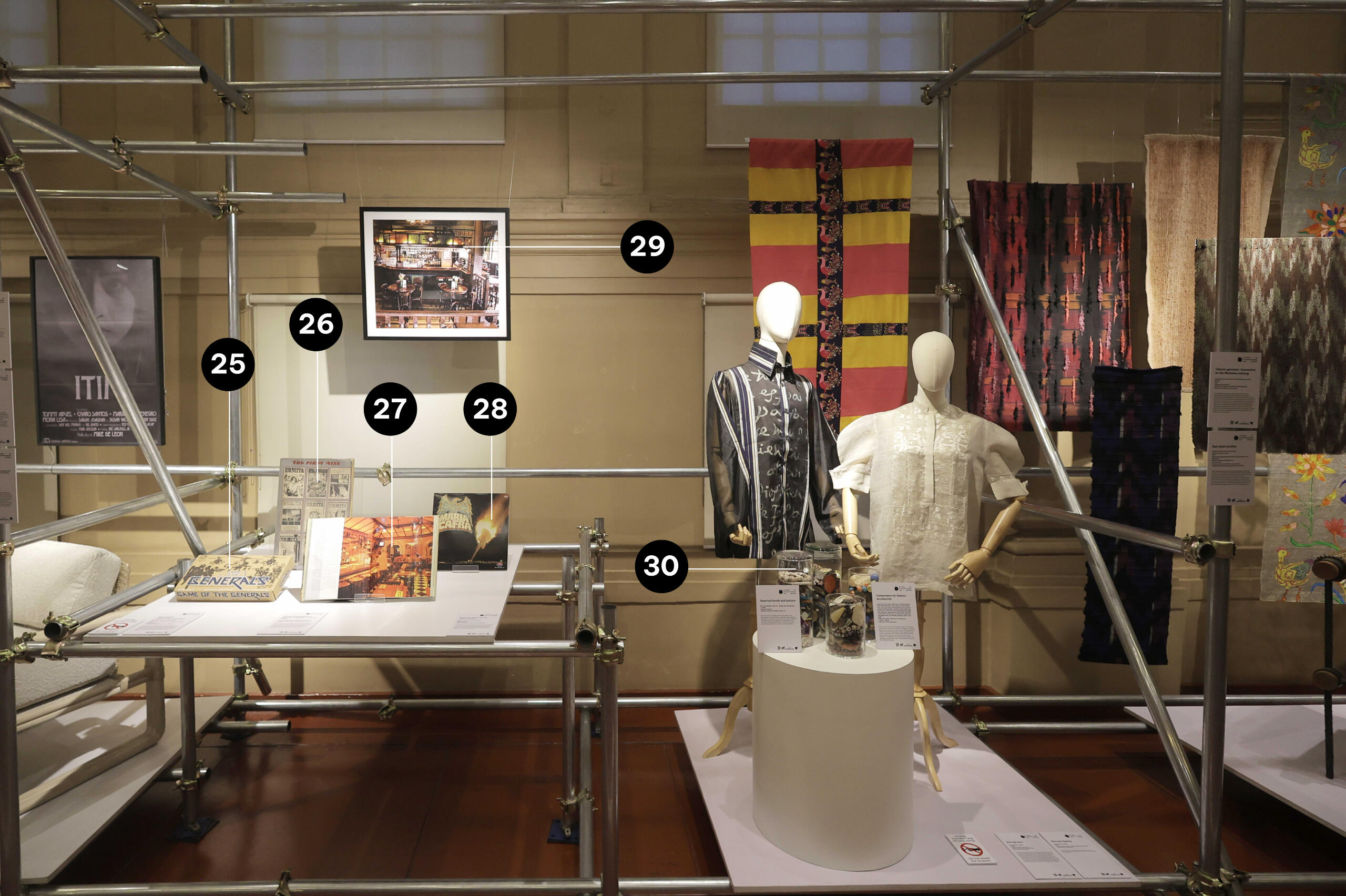
25
Board game
“Salpakan” (Game of the Generals)
Sofronio H. Pasola, Jr., game design
MindMasters, Incorporated, producer
1972
Duotone offset printing on cut wood and packaging board
Multiple sizes
Plastic, paper, wood
Collection: Design Center of the PhilippinesGame development in the second half of the 20th C commenced with substantial popular reception at the invention of “Salpakan, Game of the Generals” by Sofronio “Ronnie” Pasola. It tests military-like skills with cumulative moves. Its popularity was to decline with the ascendance of digital games at present—however there still exist clubs whose members meet to play. “Game of the Generals” is the singular transition from board competition traditions like chess, of the earlier part of the 20th C, to today’s dramatically visualized digital war contests.
26
Compilation in one volume of the first nine issues of
the magazine bannered as The Filipino Culture Magazine
“Ermita”
Robert “Boy” Yñiguez, design
Alfred “Krip” Yuson, editor
Alfonso “Boy” Yuchengco, publisher
1976 (January to October)
Offset printing
30 × 44.5 × 4 cm
Paper and printers’ ink
Collection: Joseph Lee Alviar“Ermita” ran ten issues in 1976, collectively produced by the leading lights of Manila’s intellectual counterculture. It became, as its editor wrote retrospectively, “an inspiration to editors and artists in the years to come.” The publication took up the spirit of the “Whole Earth Catalogue” by Stewart Brand, gathering the period’s breakthrough ideas in projects (mainly American) expressing nascent ecosystemic ways of looking at both nature and culture. “Ermita“ is catalogue-like, but focused instead on artistic gestures in various media, sharing with “Whole Earth…” an anti-Establishment ethos.
27
Period documentation
“Malate: A Matter of Taste”
2001Cafe Adriatico, established by Malate bon vivant Lorenzo “Larry” Cruz, became the nerve center of taste-making for the metropolis and the Philippines. This taste involved, as a distinct dimension, a penchant for resurrected “Filipiniana,” a term that encompassed a range of symbolic materials such as carved architectural details from demolished Spanish colonial homes, heritage recipes, old textiles and jewellery, and so forth.
28
Cover for vinyl record
“Maria Cafra”
Music by the rock band Maria Cafra
1978
Offset printing
31.5 × 31.5 cm
Paper (board)
Collection: Design Center of the PhilippinesThe 1970s rock bands—notably, Juan de la Cruz Band with lead Joey “Pepe” Smith, and Maria Cafra—contributed substantially to the visual culture of the period. Other than their impact on Filipino music, the rock bands published their music in vinyl albums that inevitably featured compelling graphic design on the covers. The iconography on Maria Cafra and the other bands’ covers distilled the preoccupations of the principal figures of this early period of Pinoy Rock: the fiery nature of the music of the amplified electric guitar.
29
Documentation
Cafe Adriatico bar area
Established 1979Lorenzo “Larry” Cruz’ Cafe Adriatico gave impetus to a taste for the creative reuse of architectural detail from demolished Spanish colonial houses, among the upwardly mobile and aristocratic Metro Manila residents. The Remedios Circle Cafe has sustained its taste-setting presence to the present. In the 1980s, it anchored the Malate district’s reputation as the space for the artistic and intellectual cutting edge.
30
Assorted beads and buttons
Bon-Ace Fashion Tools, Inc., design and manufacture
c. 1980s
Various materials
Collection: Bon-Ace Fashion Tools, Inc.Bon Ace took up a leading role in the creation of an extraordinary array of buttons and beads, each design a miniature composition of wood, shell, and other materials. The Philippines was represented in these pieces in the intricacy of the designs, the skill of making, the sense of innovative surprise, and the will to contemporaneity.
Page 3 of 9
A project of

In partnership with

1973 - 2000
Mezzanine Level
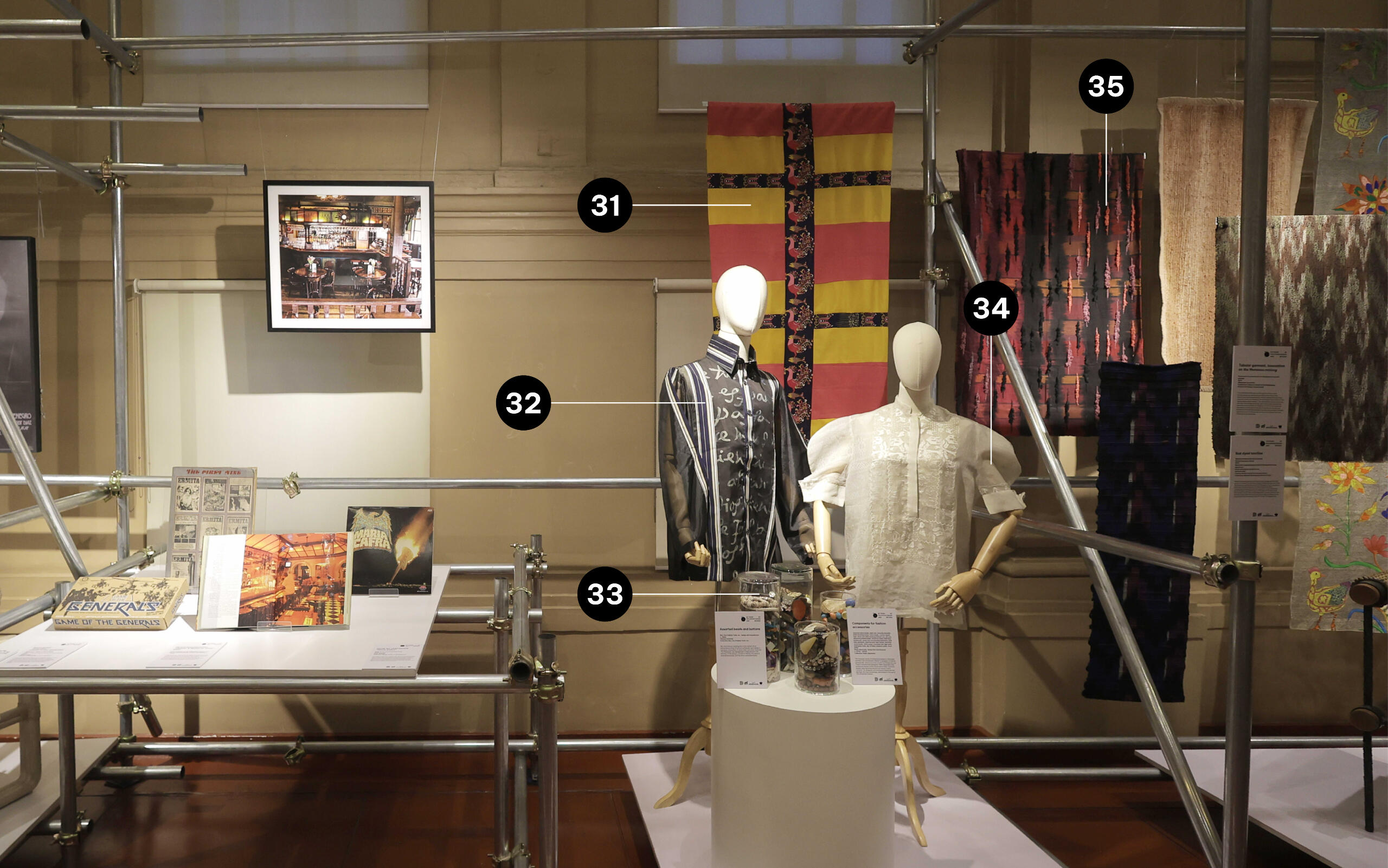
31
Tubular garment, innovation on the Maranao malong
Produced as costume for the Kasaysayan ng Lahi parade
1974
Silkscreen on cotton
Collection: Cultural Center of the Philippines, Production Design DepartmentThe traditional Maranao malong formulation was reinterpreted by introducing a figurative, logo-like sarimanok figure repetitively along the bands that in the originals were the tapestry woven langkit and tobiran. The figures were silkscreened. The sarimanok, also a Maranao icon like this landap malong, was the chosen symbol for the Miss Universe Beauty Pageant of 1974—the event at the newly constructed Folk Arts Theater for which the enormous parade Kasaysayan ng Lahi was staged. Making spectacle out of indigeneity became a cultural form for Filipinos at this juncture.
32
Barong Tagalog
Barge Ramos, design
2023
Tailoring, silkscreened painting on bodice panels
Collection: Barge RamosAnother example of a Barge Ramos silkscreened barong Tagalog shows a handwritten prayer: Santa Teresa de Avila’s Nada de Turbe.
33
Components for fashion accessories
Assorted stone beads, shell cuts, brownlip/blacklip shells blocking beads, twine beads, crochet beads, tiger, black and white lumbang (kukui) nuts, pili nuts, assorted polished shells, American Indian shell inlay buckle part, wood and coco buckles/pendants, shell inlay pendants, assorted poly resin beads, assorted wood beads, white nassa, moonshell and tiger puka, mahogany ovals, sig-id tubes, bamboo tubes, troca shells
Pedro Sepulveda, design and manufacturer
c. 1970s – 2000s
Collection: Pedro SepulvedaThe immense variety of materials sculpted or otherwise worked to be components offered to designers of fashion accessories, was to be a mark of both the Philippines and Filipino manufacturer/designers. Pedro Supulveda was among the leaders of this robust export field. The basic shapes were fashioned around the nature of each material. The designers who composed necklaces and earrings, and decorated bags, elaborated on the eye of the component makers.
34
Barong tunic
Barge Ramos, design
c. 1980
Tailoring, photo-silkscreen
Fabric of piña (Bromelia ananas)
Collection: Lulu Tan GanBarge Ramos shifted the idea of the barong Tagalog from the intricately embroidered garment for formal wear to an often hand-dyed, silkscreened version—often using pineapple cloth, equally intricately-executed and equally apropos wear in formal settings. These shifts that he commenced in the 1970s were entirely built on Ramos’ graphic design virtuosity and understanding of cloth. The patterning was always composed according to the garment surfaces (mostly as a frontispiece to the upper body), interconnecting elements from traditional Philippine highland art and from the “Filipiniana” imaginary.
35
Ikat dyed textiles
Narda’s Handwoven Arts & Crafts
Narda Capuyan, design
1972
Warp ikat, supplementary weft (with leather in one specimen)
Hand weaving on upright loom
Various sizes
Cotton, leather strips (in one specimen)
Collection: Narda’s Handwoven Arts & CraftsNarda Capuyan began ikat dyeing woven textiles at her small operation around the time that Design Center introduced to her the American textile artist Ellen Schattsneider. The consultancy produced the enduring line of cotton textiles woven in increasingly enlarging production capacity. Under the brand name “Narda’s” and with Narda at the helm of the enterprise that would in due course include exports to global markets, the typically heavy spun and textured cotton fabrics woven on the Ilocano floor loom became a kind of “brand” for Baguio City.
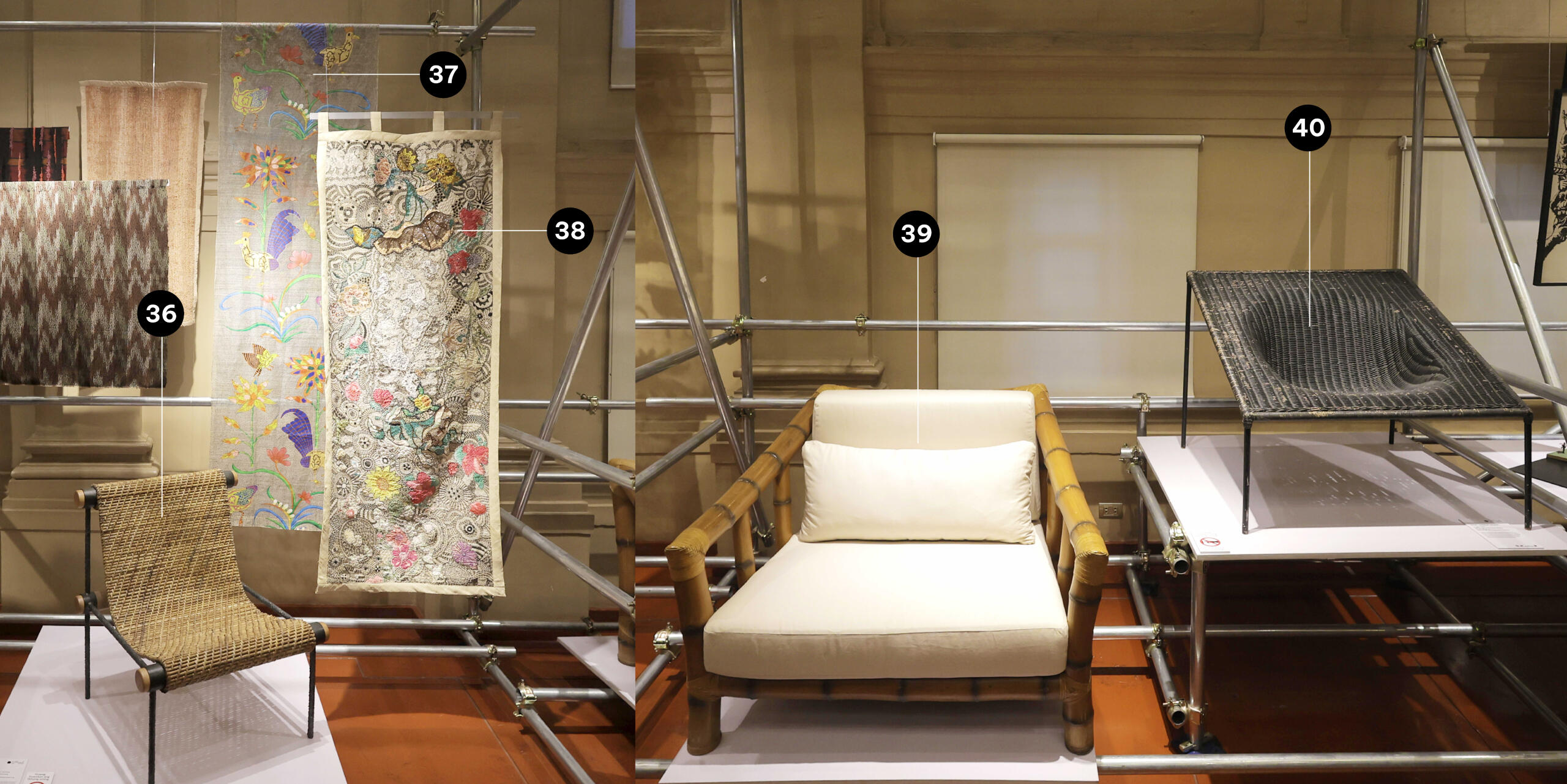
36
Chair
Herben International
Val Padilla, design
Calfurn Manufacturing Inc., refurbishing
c. 1980s
Weaving, woodworking, metalworking
55.5 × 53 × 87 cm
Wood, metal, arurog, rattan
Collection: Susan Abrera and Design Center of the PhilippinesThe chairs by Val Padilla for Herben International continued and elaborated on the modernist lines made desirable in the 1970s by Al de Lange. By 1989, Padilla was given the Roscoe Award by the American Society of Interior Designers for this accent chair. It notably made minimal use of carabao leathers strips around a solid wood log in its metal frame, around which woven rattan was coiled. Padilla’s use in an International Style chair of an organic material—ubiquitous in the Philippines until this period—sustained a widely shared Filipinization urge appropriating modernity.
37
Untitled surface decorated cloth panel
Beatriz “Patis” Tesoro, design
2022
Painting, weaving and hand sewing
76.5 × 366 cm
Piña seda, paint, thread
Collection: Patis Tesoro BoutiqueBeatriz “Patis” Tesoro has been for decades the Philippines’ inimitable, exuberant surface designer of translucent fabrics—principally piña and its blends—an artistic trajectory blended with her career as couturier. This recent example brings together decades of experience with assemblage, using all manner of fabrics, stitches, beads, and other embellishment materials. Tesoro’s energetic compositions often shift from the field of fashion to assemblage itself.
38
Untitled surface decorated cloth
Beatriz “Patis” Tesoro, design
2022
Multiply appliquéd cloth
76.5 × 184 cm
Collection: Patis Tesoro BoutiqueBeatriz “Patis” Tesoro has been for decades the Philippines’ inimitable, exuberant surface designer of translucent fabrics—principally piña and its blends—an artistic trajectory blended with her career as couturier. This recent example brings together decades of experience with assemblage, using all manner of fabrics, stitches, beads, and other embellishment materials. Tesoro’s energetic compositions often shift from the field of fashion to assemblage itself.
39
Armchair
Antonio “Budji” Layug, designer
c. 1980s
Bamboo bending, upholstery
91.5 × 127 × 85 cm
Bamboo, rattan, fabric, synthetic foam
Collection: Design Center of the PhilippinesBudji Layug emerged as a high-end furniture designer from an earlier career as the noted hairstylist Budjiwara, schooled at London’s Vidal Sassoon boutique. He deployed a singular insight: outriggers created by Batangas boat builders by bending whole bamboo. Hence, the Budji furniture line of large bamboo and expert rattan twining for joineries. His leading status as a pioneer in contemporary furniture design in time activated his extended career as designer of entire environments for homes and public buildings.
40
Chair, entitled “Duyan”
Lor Calma, design
c. 1980s
Weaving, metalworking, dyeing, varnishing
94 × 91.5 cm
Rattan, wrought iron
Collection: Senator Anna Dominique M. L. CosetengArchitect Lor Calma enjoyed a decades-long career as a leading furniture and interior designer, starting from the same 1970s decade as his peers and friends Arturo Luz and Leandro Locsin. His métier in furniture was International Style renderings of the traditional rattan—in this example exhibiting virtuosity of cane weaving. The name duyan references bamboo infant cradles, typically executed with an elongated cup-like form. Calma’s duyan version keeps the severe geometry of his aesthetic, incorporating the cupping seamlessly.
Page 4 of 9
A project of

In partnership with

1973 - 2000
Mezzanine Level
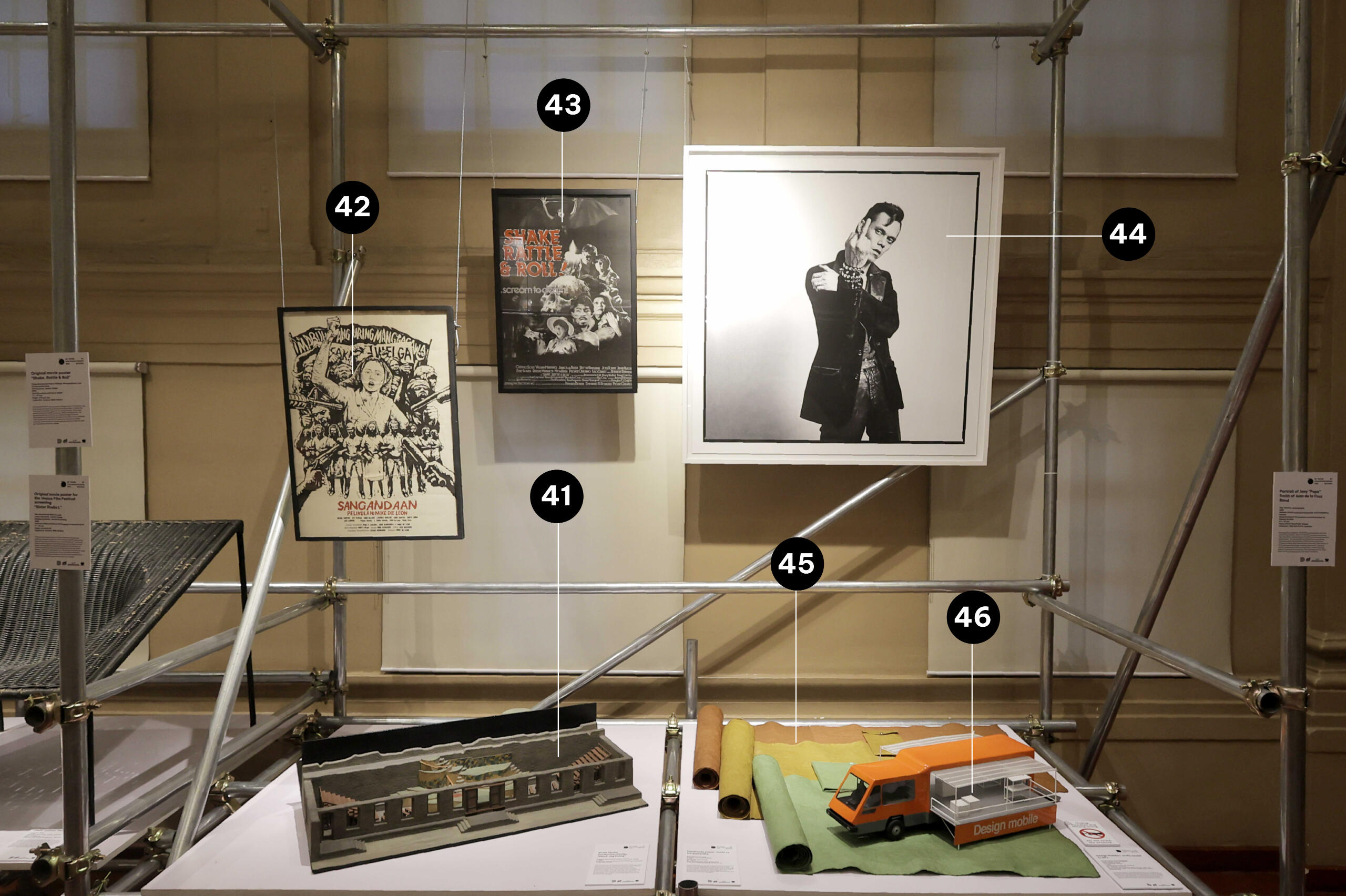
41
Maquette for production design
The play on assassinated Kalinga leader Macli-ing Dulag
Philippine Educational Theater Association, design
c. 1988
Collection: Cultural Center of the Philippines Production Design DepartmentThe assassination of Mac-liing Dulag was a historical moment of substantial impact on the Philippine body politic; a moment that the renowned PETA (Philippine Education Theater Association) took up, narrated in theater form, and provided with arresting production design. PETA had evolved, from its beginnings as an activist theater group, a distinct scenographic design approach in relation to its stagings at the ruins of Fort Santiago, the Spanish colonial fort destroyed during the Second World War.
42
Original movie poster for the Venice Film Festival screening
“Sister Stella L”
Film directed by Mike De Leon
Cesar Hernando, poster design
Antipas Delotavo, woodcut printing
1984
Duotone offset printing of photograph of woodcut print
71 × 51 cm
Paper, printers’ ink
Collection: Archivo 1984 GalleryNoted Social Realist artist Antipas Delotavo created the original woodcut poster for a film of deep significance during the ending years of Martial Law in the Philippines. The film by Mike de Leon signaled the mainstreaming of protest art in all fields. “Sangandaan” was the title used for the Venice Film Festival screening of the movie otherwise known as “Sister Stella L,” about a radicalized nun. The woodcut technique, used globally by anti-authoritarian fronts, blending resistance histories with a print process, was in this case rendered in an offset photographic print of the hand-cut original.
43
Original movie poster
“Shake, Rattle & Roll”
Film directed by Peque Gallaga, Ishmael Bernal, and Emmanuel Borlaza
Vic Delotavo, poster design
1984
Duotone offset printing on paper
77 × 57 cm
Paper, printers’ ink
Collection: Archivo 1984 GalleryOf the hundreds of movie posters designed by Vic Delotavo, this is the piece he regards as his peak achievement. It is also the “holy grail” of poster collections, owing to rarity. Only a few were printed by a small company, Athena Productions. The graphic aesthetic turns on the central collage of faces, intensified by the “shaking” red font of the title. It is an aesthetic that transports a “komiks” sensibility to the field of offset printing, conveying thus a mass appeal look to a medium used by the middle and elite classes.
44
Portrait of Joey “Pepe” Smith of Juan de la Cruz Band
Wig Tysmans, photography
1984
Medium-format analog photography with Hasselblad camera
Inkjet printing of 120 positive on archival paper by Pioneer Studios
117 × 117 cm
Paper (Photo Rag Bright White)
Collection: Wig and Carole TysmansPhotography changed in the 1970s in parallel lines with the advertising industry, which at this time turned to extremely high-resolution analog images for billboard size and television applications. The new platforms allowed photographers working expertly with medium (120) format and 25 mm cameras, notably Wig Tysmans and only a very few others, to articulate personal image-making trajectories. Tysmans quickly mastered portrait photography, vividly capturing subject character, for instance, the rock legend Joey “Pepe” Smith of the counterculture Juan de la Cruz Band.
45
Handmade paper, made to be leatherlike
Reynaldo and Loreta Rafisura, design
Salay Handmade Paper
c. 1987
Papermaking
111 × 24 cm
Plant fibers (abaka)
Collection: Salay Handmade Products, Inc.Handmade papermaking was an important focus of work in the earliest days of Design Center, owing to Arturo Luz’s deep interest in locally available materials. Involving were a big range of fibrous plants. The Rafisura couple began with extensive use of cogon grass. (They say that they almost used up the cogon grass in their own and nearby towns). Abaká is in more extensive use today for their durability, high recovery rate, and sustainable commercial availability.
46
DESIGN MOBILE I, scale model (1:20)
Mark Mallari, design
Lino Santiago, design
Ducks Industrial Design Works, scale model
c. 1983
Sculpting (diorama), 3D-printing
60 × 14.5 cm × 17.5 cm
3D-printed resin (chassis frame, wheels, seat and stirring wheel),
laser-cut plastic panels and acrylic sheet (body)
Collection: Design Center of the PhilippinesThe Design Center in the 1980s responded to an intensifying spirit upholding grassroots empowerment with a push to deliver design services beyond Metropolitan Manila. Its “Design Mobile” (presented in this exhibition as a 3D printed model) traveled to the countryside with staff, to assist small scale industries with advice to strengthen experimental approaches, update graphics and packaging, and sustain production capacity.
Page 5 of 9
A project of

In partnership with

1973 - 2000
Mezzanine Level
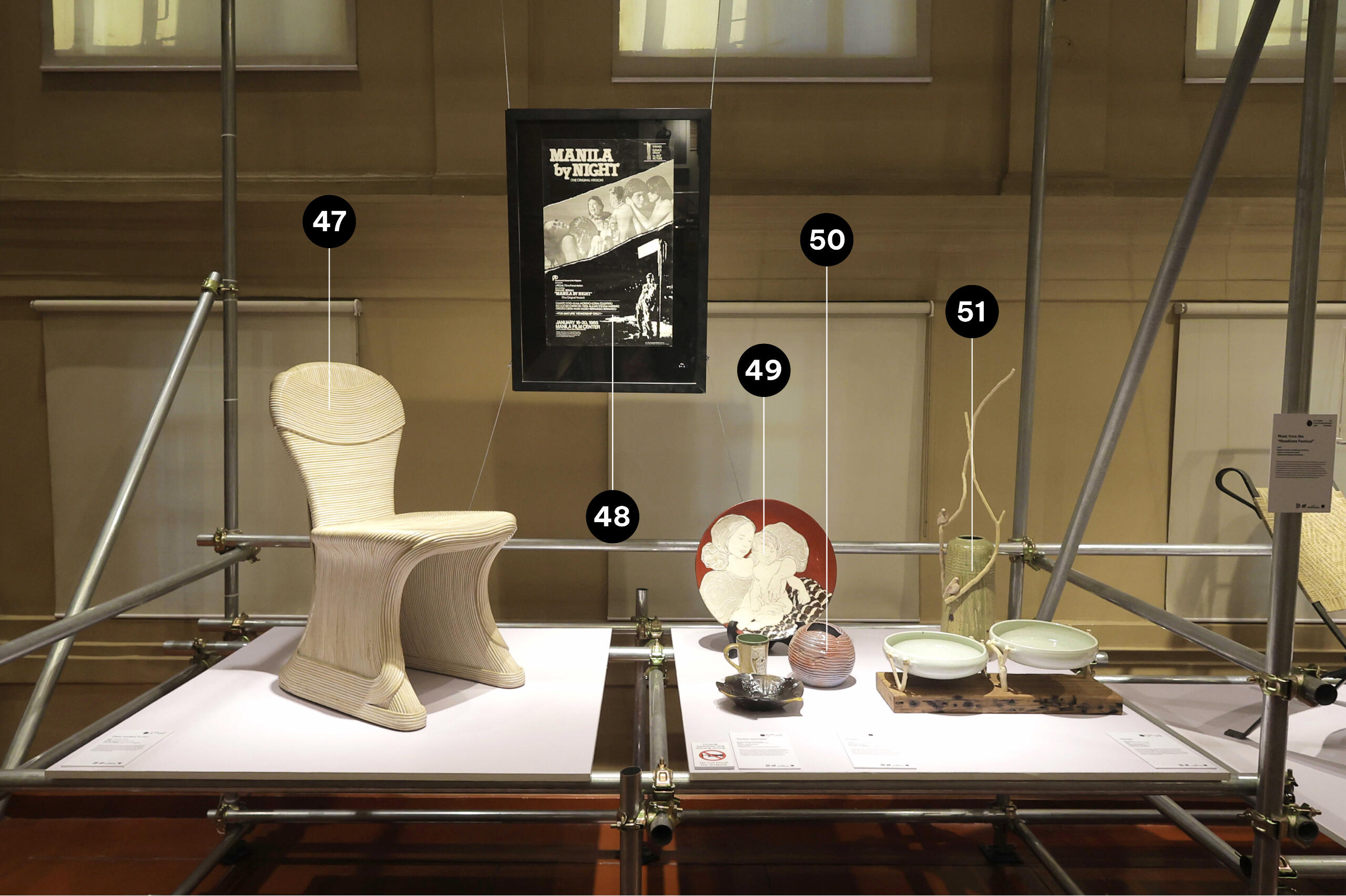
47
Chair, entitled “Lotus”
Betty Cobonpue, design
1984
Rattan lamination on wood frame
92 × 48 × 66 cm
Collection: Design Center of the PhilippinesRattan-working into innovative furniture form reached a peak with this Lotus Chair by furniture designer and manufacturer Betty Cobonpue. The Cebu-based designer distilled decades of experience with rattan chair manufacture into this sinuous accent chair in which the bent rattan laminated into an invisible understructure was held in place by the lamination itself. The chair was designed to stay in form with no nails. Cobonpue refreshed rattan possibilities.
48
Original commemorative screening poster for “Manila by Night”
Film by Ishmael Bernal
Laureate, Order of National Artist
Experimental Cinema of the Philippines, producer
1985
Duotone offset printing on paper
83 × 60 cm
Paper, printers’ ink
Collection: Archivo 1984 GalleryThis 1985 poster for a commemorative screening of the “Manila by Night” was in lieu of none for the 1980 premier. (A newspaper advertisement was however released when it was first shown). The film was directed by the inimitable auteur Ishmael Bernal and involved many of the Manila intelligentsia in its making. The 1985 poster affected a rough cut-out strip from paper collage experimentations of the period immediately before the People Power Revolution of 1986. Film, poster, director, and actors shared a critical sensibility.
49
“Mother and Child” by Jose Joya, on ceramic plate
Anaware, design and manufacturing
1988
Ceramic firing, painting
46 cm, diameter
Ceramic clay
Collection: Anaware Ceramics International Inc.The Bacolod City based Anaware, a ceramics manufacturing enterprise, innovated on the idea of mass production by inviting some of the Philippines’ leading Modernist painters to allow reproduction of a select one of their works for application on a ceramics plate. “Mother and Child” was the painter Jose Joya’s contribution to this art and design collaboration. This collaboration transpired as the Negros sugar industry was struggling to cope with global collapse of sugar prices.
50
Stoneware Pottery
Lanelle Abueva
c. 1980s
Collection: Lanelle AbuevaLanelle Abueva is the quickly recognizable name among the second-generation studio potters of the Philippines. Her retreat-like restaurant and studio in Antipolo, Rizal is a destination for afficionados of the handmade and of a back-to-nature aesthetic. Sustained by early training in Japan, Abueva has maintained curiosity over materials (for example, working with Mt. Pinatubo eruption ash) and form (for example, working stoneware toward contemporary vessel shapes).
51
Vessels
Ugu Pottery
Augusto "Ugu" Bigyan, design
2023
Stoneware firing with glaze
Various dimensions
Stoneware clay, glaze
Collection: Ugu PotteryThe Tiaong, Quezon born Ugu Bigyan shifted from office work in Makati to full time application to ceramics in his hometown. These 2023 vessels belong to a decades long studio pottery line that began in 1985, first by supplying artisan stores in Manila and international clients. He shifted once more in 1995, presenting his work in solo exhibitions. The Tiaong studio is also his home, where the ceramics are distinguished by a romantic, back-to-nature sensibility.
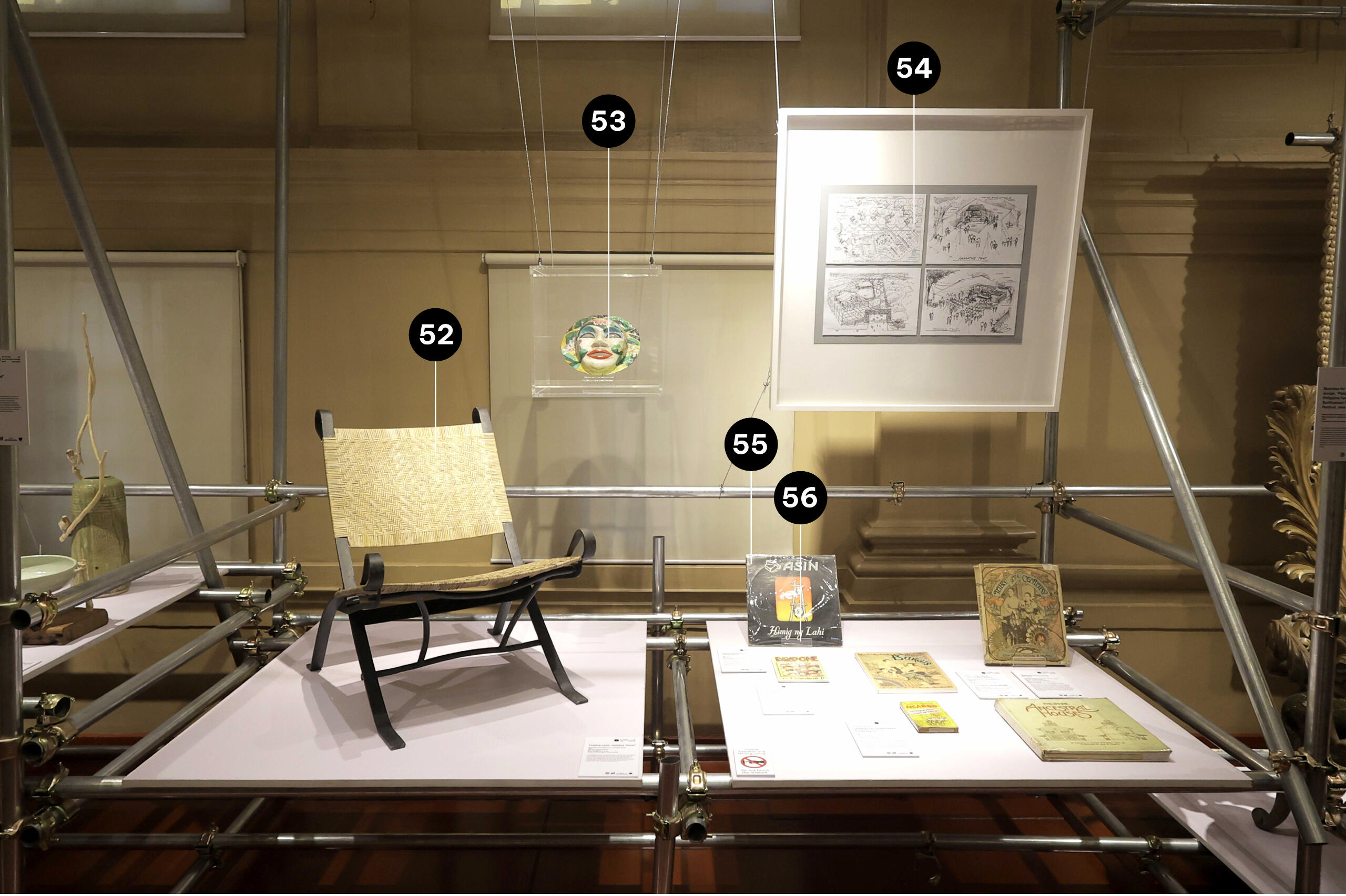
52
Folding chair, entitled “Petal”
Mercedes “Ched” Berenguer-Topacio, design
1987
Weaving, metalworking
85 × 72 × 82 cm
Hand-forged iron, rattan
Collection: Berenguer Topacio NOWThe designer’s name, Ched Berenguer-Topacio, was and remains memorable to interior design enthusiasts though the decades since the 1970s. This 1987 creation sustains the International Style to be recognized in the future for International Style pioneers in the Philippines, however with the incorporation of features from earlier than the 1970s: the use of wrought iron (the preferred Spanish colonial technique) and woven cane (ascendant in the American colonial time).
53
Mask from the “MassKara Festival”
1997
Papiér mache, sculpting, painting
Paper, cornstarch, paint
Collection: Raymond AlunanBacolod City’s MassKara Festival was invented by a group of artists and leaders as a response to the near collapse of the sugar industry in the late 1980s. The province of Negros Occidental was, in economics and in the Philippine cultural imagination, the sugar land of vast, monocropped haciendas. MassKara insisted on hope and encouraged design exuberance in the carnivalesque spirit. This papiér mache mask, made 10 years after the festival beginning, maintains the spirit.
54
Sketches for the production design
Pahiyas sa Mundo: Philippine Festival
Smithsonian Folklife Festival, June – July 1998
National Mall, Washington, DC, United States
Paulo Alcazaren, production design
1998
Collection: Paulo AlcazarenThe Philippine Festival was staged by the Cultural Center of the Philippines and the Smithsonian Institution, with a commissioned curatorial team of private sector Philippine Studies experts, at the National Mall of Washington, D.C. Landscape architect Paulo Alcazaren was engaged to respond to the project brief for production design: to abstract the Philippines, with an economy of means and a modernist sensibility. The focal part of the design was a basketball court, deemed by the curatorial team as the Philippines’ cultural center.
55
Cover of vinyl record
“Himig ng Lahi”
“Himig ng Lahi”
Asin, music
1984
Full color offset printing on board
31.5 × 31.5 cm
Paper (board), printers’ ink
Collection: Joseph Lee AlviarThe aesthetic embodied by this vinyl record cover works with multiple citations unified by the collective persona of the folk-rock band, Asin, as a protest group connected with the grassroots in Mindanao. The central figure, a drawing, is a frame for the suspended gong—citing a variety of gong music played by Mindanao katutubo cultures. Red links with protest aesthetics. Black, too, refers to dark times. The record cover visually summarizes a rejection of sleek advertising imagery and capitalism itself.
56
Comic book
“Pugad Baboy One”
First compilation of Pugad Baboy comic strips
Cartoons and narrative, Apolonio “Pol” Medina, Jr.
1997
Illustration, writing (cartooning)
15 × 0.3 × 20 cm
Paper, printers’ ink
Collection: Design Center of the PhilippinesPugad Baboy by Pol Medina, Jr. caught the Filipino popular imagination for its simultaneously droll, critical, and affectionate view of Filipino life at urban poor precincts. Featuring a large cast of characters familiar in television sitcoms “located” in the same socio-economic demography, Medina’s cartooning and writing virtuosity created a comics mirror to a life almost universally recognized in the Philippines. This mirror shows human density, smiling faces, and two-dot eyes close together: images of a slightly deranged, easy-going population.
Page 6 of 9
A project of

In partnership with

1973 - 2000
Mezzanine Level
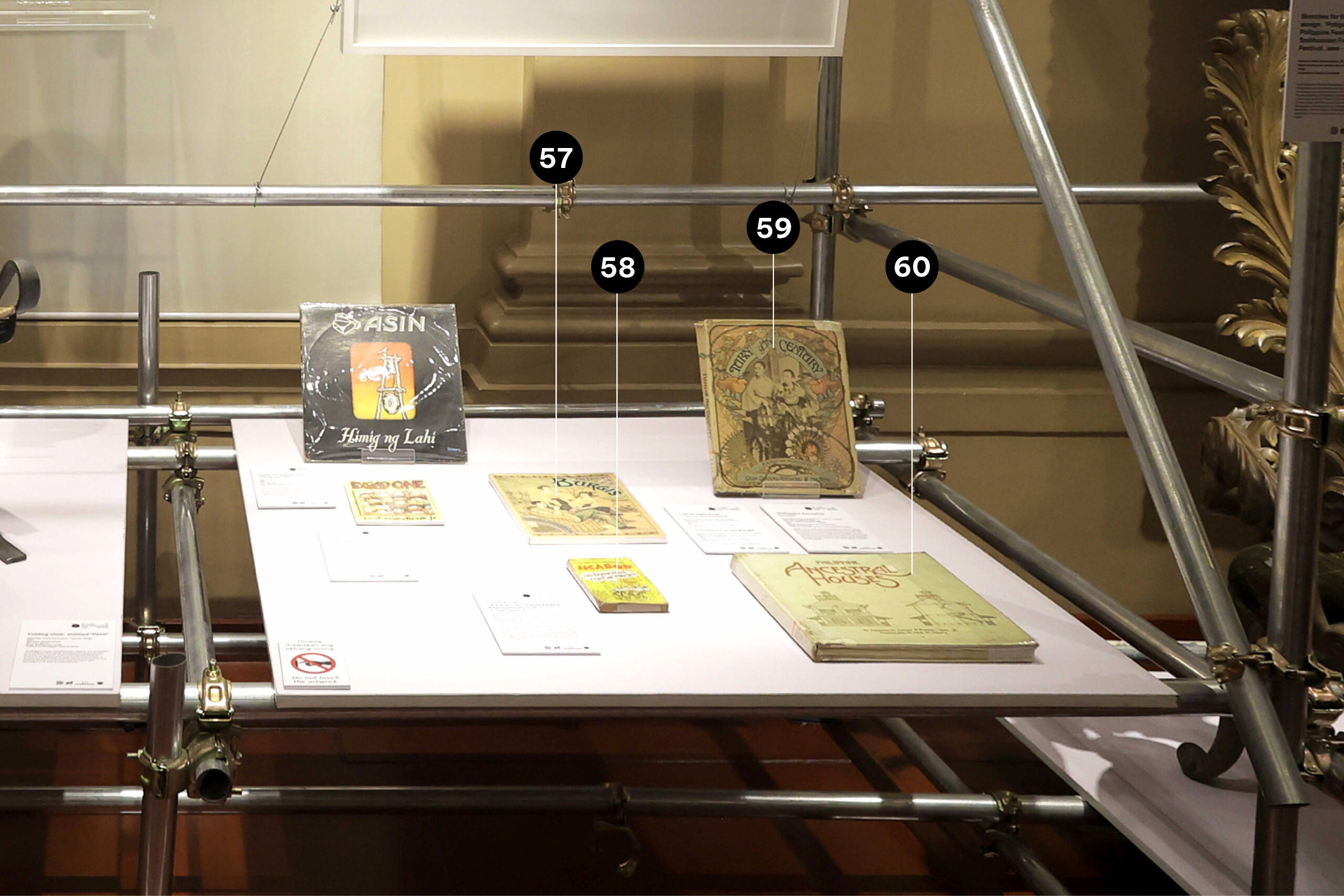
57
“The History of the Burgis”
Mariel N. Francisco and Fer Maria C. Carriola, authors
Nik Ricio, art direction
Gilda Cordero Fernando, publisher (first edition)
Nik Ricio, art direction
1987
Full color, offset printing, bookbinding
30.5 × 23 cm
Paper, printers’ ink
Collection: Design Center of the PhilippinesThe term “coffee table book” in the Philippines was first used to describe the books made by the publishing and writing ground led by eminent writer Gilda Cordero Fernando. Among the first of these large-format volumes are “Turn of the Century” and others such as “Ancestral Houses of the Philippines” and later, “Cuaresma.” The books changed the local publishing landscape by introducing handsomely printed, hardbound, full color books with content of considerable substance. Paintings, drawings, schemas, and other artworks were specifically commissioned for these volumes, as were the academic papers written for popular reading.
58
Comic book
“IKABOD: LET’S MAKEBAKA”
Representative of a vast ouevre
Severino “Nonoy” Marcelo, illustrator and author
1987
Illustration, writing (cartooning)
Offset printing
Paper, printers’ ink
Collection: Beda Requejo“Nonoy” Marcelo, cartoonist, was among the Philippines’ most effective social critics in the 1960s to the 1980s. His characters left an indelible mark in the national imagination; principally, the rat Ikabod Bubwit, and the cool but downtrodden Tisoy, a half-American street punk who was foil to his mother, Aling Otik. They inhabited the ruins of Intramuros, Manila. Marcelo’s cool broadsides at Philippine leadership and commentary on the Filipino’s foibles were sustained by a distinctive drawing iconography that was quickly recognizable to the Philippines’ reading population.
59
Coffee table book
“Turn of the Century”
Nik Ricio, design, planning and production
Gilda Cordero Fernando, planning, production, publishing
Pepito Frianeza, painting
1978
Full color offset printing, book binding
31 × 26 cm
Paper, printers’ ink
Collection: Design Center of the PhilippinesThe term “coffee table book” in the Philippines was first used to describe the books made by the publishing and writing ground led by eminent writer Gilda Cordero Fernando. Among the first of these large-format volumes are “Turn of the Century” and others such as “Ancestral Houses of the Philippines” and later, “Cuaresma.” The books changed the local publishing landscape by introducing handsomely printed, hardbound, full color books with content of considerable substance. Paintings, drawings, schemas, and other artworks were specifically commissioned for these volumes, as were the academic papers written for popular reading.
60
“Philippine Ancestral Houses”
Fernando N. Zialcita and Martin I. Tinio, Jr., authors
Neal Oshima, photography
Manuel D. Baldemor, drawings
Gilda Cordero Fernando, publisher
1980
Offset printing, illustration, bookbinding
Paper, printers’ ink
Collection: Design Center of the PhilippinesThe term “coffee table book” in the Philippines was first used to describe the books made by the publishing and writing ground led by eminent writer Gilda Cordero Fernando. Among the first of these large-format volumes are “Turn of the Century” and others such as “Ancestral Houses of the Philippines” and later, “Cuaresma.” The books changed the local publishing landscape by introducing handsomely printed, hardbound, full color books with content of considerable substance. Paintings, drawings, schemas, and other artworks were specifically commissioned for these volumes, as were the academic papers written for popular reading.
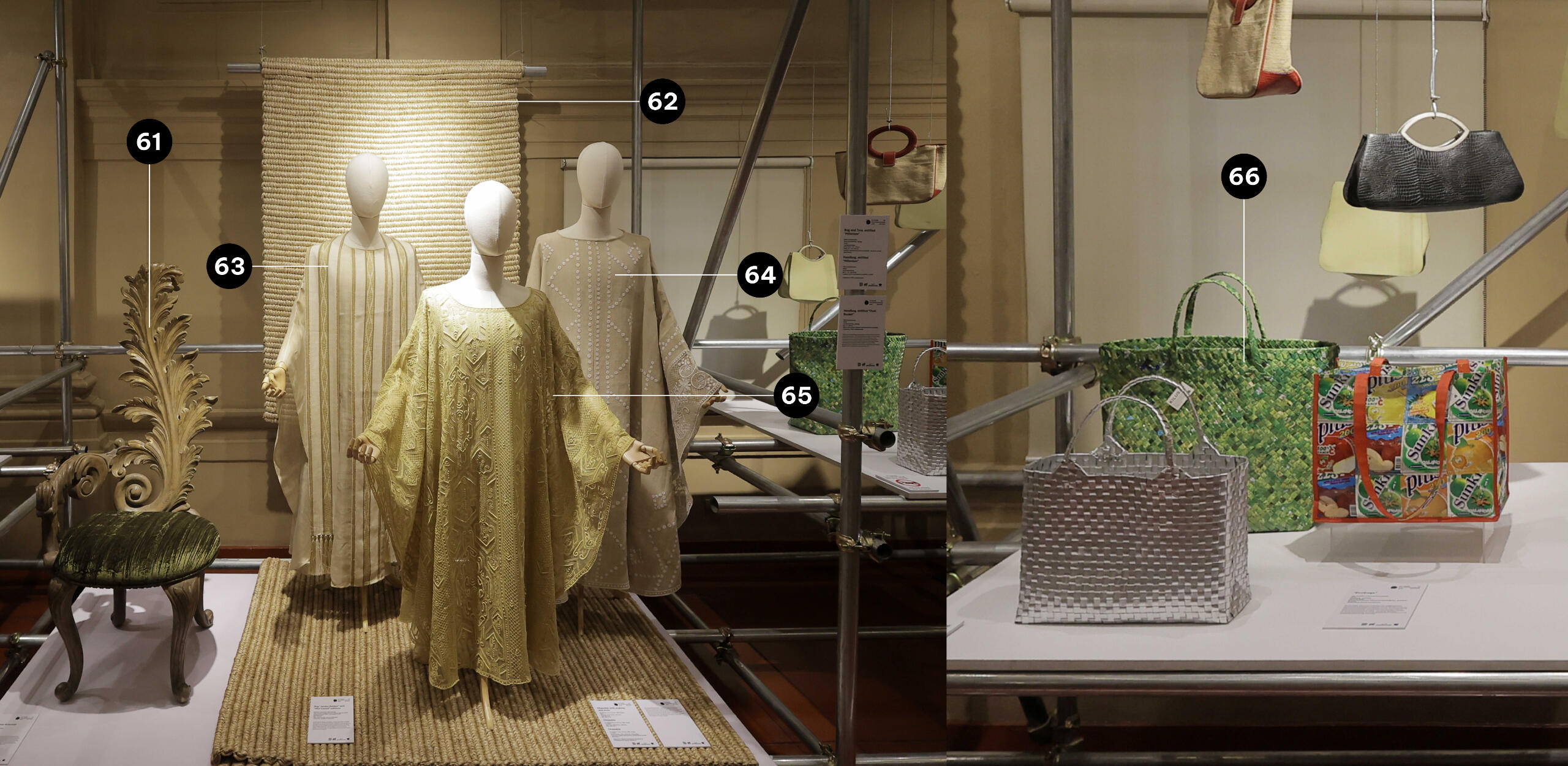
61
Acanthus Armchair
JB Woodcraft, design
2006
Carving, gilding
22 x 25 x 57 inches
WoodJB Woodcraft, a furniture manufacturer that maintained its rooted link with Pampanga woodworking, created this fantasy piece in 1988, when the Philippines was experiencing aesthetic and political renewal. The past resurrected in fantastical form was an unusual response to a time when the past seems to have been laid to rest—especially in light of the full emergence of International Style in furniture. However, this chair successfully maintained the modernity of this design track.
62
Rug
“Jumbo Golden” and “Mini Camel” editions
SouMak Collections (with license)
Yola Johnson, design (product patent and copyright)
1990s (patented 1992, copyrighted 2007)
Binding weave
183 × 121 cm
Abaká (Musa textilis Neé)
Collection: SouMak CollectionsIn the SouMak design vocabulary, “Jumbo” and “Mini” are literal references to the relative thickness of the fiber used to create and define a product. Yola Johnson, designer, and proprietress of SouMak, led the redesign of abaká products that by the 1960s were already exhausted and consigned to low end outlets. The design of SouMak’s rugs, among others of its product lines, altered the look and feel of both material and outcome to signal plushness and elegance.
63
Chasuble with orphrey and stole
Dom Martin Hizon Gomez, OSB, design
1997
Weaving, embroidery, tailoring
Various sizes
Silk, piña cloth
Collection: Filipino Vestments Collection of Transfiguration Abbey, BukidnonThe three priestly garments—chasubles—were designed by Dom Martin Gomez of the Order of St. Benedict, to feature Filipiniana patterning in restrained ways. The pure silk stole, and chasuble incorporates Ifugao patterning. (Prior to the 1997 creation of this garment, the Ifugao people wove only in cotton, linen, and bark; never silk.) Tboli rhombus and Bagobo patterning show up in the other garment; and the Visayan made garment is of a piña and silk blend pioneered in Aklan and embroidered in Lumban, Quezon.
64
Chasuble
Dom Martin Hizon Gomez, OSB, design
c. 1990s
Weaving, embroidery, tailoring
Piña silk fabric
Collection: Filipino Vestments Collection of Transfiguration Abbey, BukidnonThe three priestly garments—chasubles—were designed by Dom Martin Gomez of the Order of St. Benedict, to feature Filipiniana patterning in restrained ways. The pure silk stole, and chasuble incorporates Ifugao patterning. (Prior to the 1997 creation of this garment, the Ifugao people wove only in cotton, linen, and bark; never silk.) Tboli rhombus and Bagobo patterning show up in the other garment; and the Visayan made garment is of a piña and silk blend pioneered in Aklan and embroidered in Lumban, Quezon.
65
Chasuble
Dom Martin Hizon Gomez, OSB, design
c. 1990s
Papermaking, shifu, weaving, embroidery
Handmade paper threads from abaká (Musa textilis Neé) fibers
Collection: Filipino Vestments Collection of Transfiguration Abbey, BukidnonThe three priestly garments—chasubles—were designed by Dom Martin Gomez of the Order of St. Benedict, to feature Filipiniana patterning in restrained ways. The pure silk stole, and chasuble incorporates Ifugao patterning. (Prior to the 1997 creation of this garment, the Ifugao people wove only in cotton, linen, and bark; never silk.) Tboli rhombus and Bagobo patterning show up in the other garment; and the Visayan made garment is of a piña and silk blend pioneered in Aklan and embroidered in Lumban, Quezon.
66
Ecobags
The women of KILUS Foundation
1997
Appliqué, weaving
Various sizes
Discarded flexible foil pouch (DOYPACK), synthetic textiles
Collection: KILUS FoundationBy the 1990’s, the world of design in the Philippines was suffused with the people empowerment ethos that found phenomenal expression in political process. KILUS Foundation, which has long worked with women of urban poor populations in Metropolitan Manila, commenced making bags of woven strips of discarded foil pouches. The market quickly emerged for the kind of community-driven enterprise that KILUS Foundation prototyped, with the added shift of interest towards environmentally friendly practices.
Page 7 of 9
A project of

In partnership with

1973 - 2000
Mezzanine Level
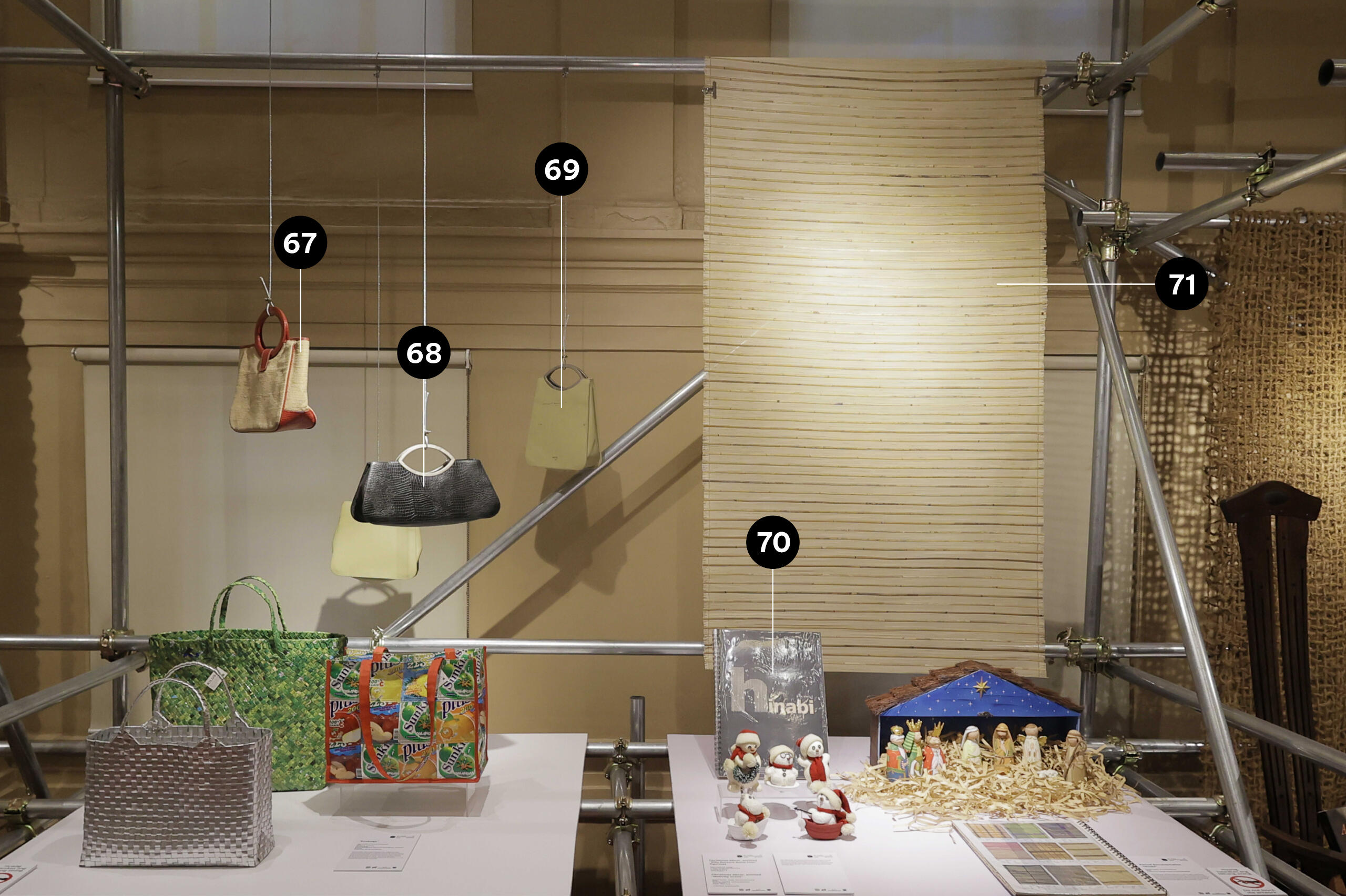
67
Handbag, entitled “Oval Bucket”
FINO Leatherware
2008
Leatherworking, sewing
33 × 9 × 32 cm
Fabric (raw linen), leather (embossed red cowhide)
Collection: FINO LeatherwareFINO Leatherware began production in 1992 with products for medical school use. The first lines were for men: envelop folios, briefcases, jotters. Early assistance by the Design Center connected the company to Italian consultants, shifting it to women’s precision-made, undecorated leather bags whose main appeal was leathercrafting itself. The brand FINO emerged fully in the 2000s as a women’s bag brand defined by elegant color, fine leather, and stunning form.
68
Handbag, entitled “Millenium”
FINO Leatherware
2000
Leatherworking
35.5 × 10 × 20.5 cm
Leather (croc-embossed cowhide), metal
Collection: FINO LeatherwareFINO Leatherware began production in 1992 with products for medical school use. The first lines were for men: envelop folios, briefcases, jotters. Early assistance by the Design Center connected the company to Italian consultants, shifting it to women’s precision-made, undecorated leather bags whose main appeal was leathercrafting itself. The brand FINO emerged fully in the 2000s as a women’s bag brand defined by elegant color, fine leather, and stunning form.
69
Bag and Tote, entitled “Millenium”
FINO Leatherware
Michael Salientes, design
2000
Leatherworking
Bag: 24.5 × 10 × 28 cm
Tote: 23 × 10 × 33 cm
Leather (perforated white cowhide), metal (in matte satin finish)
Collection: FINO LeatherwareFINO Leatherware began production in 1992 with products for medical school use. The first lines were for men: envelop folios, briefcases, jotters. Early assistance by the Design Center connected the company to Italian consultants, shifting it to women’s precision-made, undecorated leather bags whose main appeal was leathercrafting itself. The brand FINO emerged fully in the 2000s as a women’s bag brand defined by elegant color, fine leather, and stunning form.
70
Period documentation
“Hinabi”
Design Center of the Philippines
2001
Collection: Design Center of the PhilippinesAmong Design Center’s major policy and program directions from the start of its institutional career, was experimentation with weaving processes and materials. The experiments were wide-ranging and involved both traditional and new sources of fiber and supplementary inserts; and new ways of deploying traditional techniques. Many of the outcomes were codified and published for possible uptake by manufacturers.
71
Weaving
Elisa Reyes, design
c. 1990s
Weaving, sewing
188 × 106 cm
Bamboo (Bambusa vulgaris), burî (Corypha elata), organic fibers
Collection: SouMak CollectionsExperimentation with hand-weaving on a floor loom was among the concentrated activities of the Design Center during its early decades. The various directions involved insertions of surprising supplements to the fiber warp, including twigs and other wood sticks, bamboo slivers, thick yarn (e.g. wool and so forth), filaments (e.g. metal strands), and paper. Elisa “Ely” Reyes was the doyenne of this field of innovation.
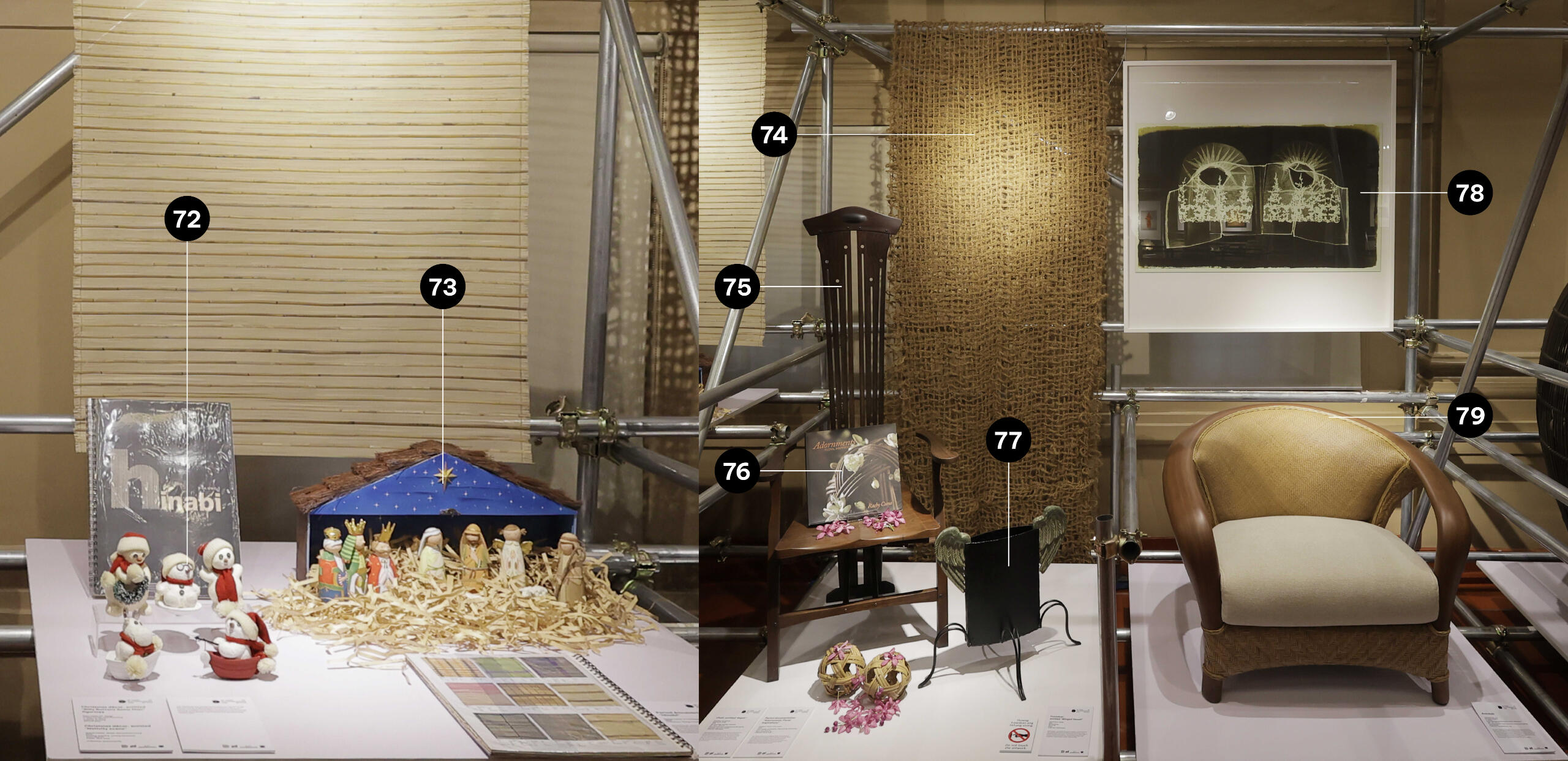
72
Christmas décor, entitled “Billy Buttons Snow Man”
Aranaz Family, manufacturing
Department 56, design
c. 1980s to 1990s
Casting, knitting, handpainting
Various sizes
Paper pulp, resin
Collection: Aranaz FamilyThe Philippines was, during the decades from the 80s to the 90s, the world’s largest exporter of Christmas décor. From nativity creches to the reindeer from American popular culture to European bells, Filipino enterprises met the market. The Aranaz family was among the leading manufacturers in this field, specializing in well-crafted and heartwarmingly designed sets.
73
Christmas décor, entitled “Nativity scene”
Aranaz Family, design
c. 2000s to 2010
Casting, painting, cutting (diorama)
Various sizes
Resin
Collection: Aranaz familyThe Philippines was, during the decades from the 80s to the 90s, the world’s largest exporter of Christmas décor. From nativity creches to the reindeer from American popular culture to European bells, Filipino enterprises met the market. The Aranaz family was among the leading manufacturers in this field, specializing in well-crafted and heartwarmingly designed sets.
74
Coir geotextile
Coco Technologies Corporation
Justino Arboleda, Ph.D, invention
1999
Large-scale weaving
100 × 500 cm (section of much larger piece)
Coconut fiber (Cocos nucifera L. Arecaceae)
Collection: Juboken Enterprises Inc.Dr. Arboleda picked up an open commons technique of weaving coconut coir into kilometers-long nets (originated in South Asia for free use anywhere, principally to benefit the poor), and deployed its production in his Bicol homeland, by the underprivileged, for their benefit. Decades later, other manufacturing enterprises have picked up geotextile making, for use in geotechnical engineering to control soil erosion with a completely biodegradable material.
75
Chair, entitled “Rajah”
Benji Reyes Woodworks
Benji Reyes, design
1998
Woodworking, doweling, carpentry
66 × 53.5 × 157.5 cm
Recycled hardwood, multiple species (kamagong, saplungan, ipil, yakal, molave)
Collection: Benji ReyesBenji Reyes sculpts rather than fabricates nor manufactures chairs, bed frames, armoires, and tables. Each is singular. Reproduction is impossible: he uses hardwood pieces taken from such sources as ruined old houses. This high back chair used five different indigenous species, randomly acquired through the wood recycling networks. As he exhibits in this chair, Reyes enjoys a virtuoso ability to respond to the forms that come to him.
76
Period documentation
“Adornments: Floral Inspirations”
Gualberto “Rachy” Cuna, author
2007
Floral design, photography, offset printing, bookbinding
31.5 × 2.5 × 31.5 cm
Paper and printers’ ink
Collection: Gualberto “Rachy” CunaThe “floral architecture” of designer Rachy Cuna cannot be displayed beyond the freshness of his organic material, hence the exhibit of documentation of his work. He is the most accomplished and articulate of Filipino decorators of celebratory spaces, bringing the practice of the florist to its leveled-up incarnation as artist of temporary spatial transformation. Cuna invented the form.
77
Container, entitled “Winged Vessel”
Joel Enriquez, design
1992
Metalworking, wood carving
40 cm tall
Metal, wood
Collection: Joel EnriquezJoel Enriquez—who began his career in design as a studio potter after already having accomplished full apprenticeship with a Japanese master ceramicist—continued to work a wide range of product development projects. The container with sculptural whimsy by Enriquez exhibits his paradoxical approach: free imagination disciplined by market understanding.
78
Photogram, entitled “04 Untitled”
From the Baro’t Saya series
Neal Oshima, photography
c. 1998 to 1999
Photogram with light sensitive emulsion applied to paper
61 × 122 cm
Etching paper coated with light sensitive emulsion
Collection: Neal OshimaThe photogram example “04 Untitled” is only one of a substantial number of similar expert explorations at direct contact image-making (no camera), in several series. For Neal Oshima, these photograms took him into a productive detour from his enduring practice as one of the Philippines’ virtuoso photographers—catching the ending decades of 120 medium format and 35 mm analog photography to the current high resolution 35 mm digital photography.
79
Armchair
Yrezábal & Co., Inc.
Eduardo Yrezábal
c. 2000s
Proprietary woodworking processes, upholstery
100 × 90 × 74 cm
Permacane (multi-layer laminated rattan and cladding; proprietary)
Collection: Yrezábal & Co., Inc.Eduardo Yrezábal reimagined rattan and wood furniture by taking up the ordinariness of the materials and transforming this ubiquity into rarity. The transformation turned entirely on the highly developed skills of rattan weavers and woodworkers, married to a spirit of technical innovation. Yrezábal invented the Permacane technology for cladding elements of furniture (as in the arms of this example) and parts of architecture—assuring the use of 97% of the rattan.
Page 8 of 9
A project of

In partnership with

1973 - 2000
Mezzanine Level
Movement 8
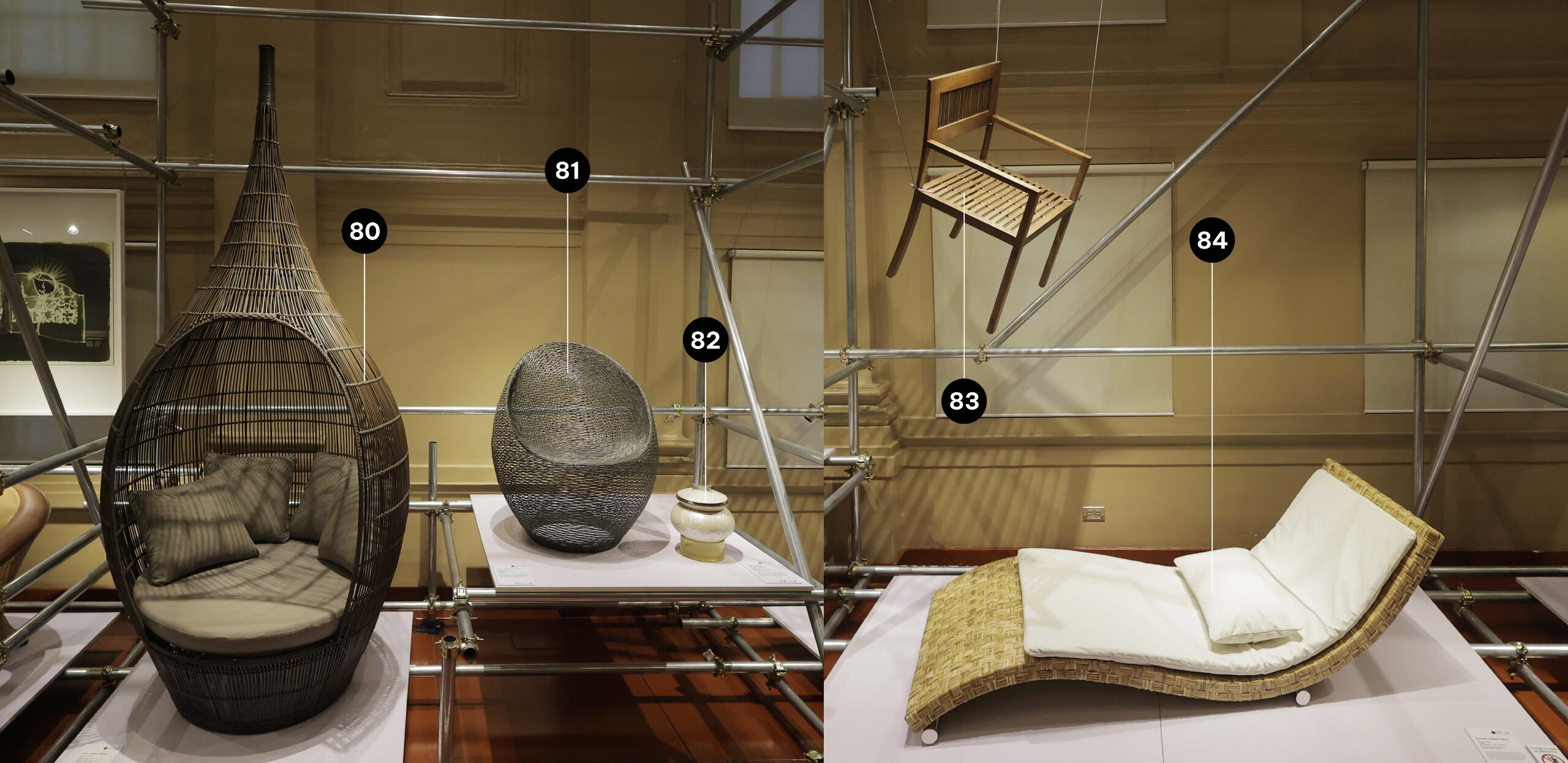
80
Chair, entitled “Genie”
Tony Gonzales, design
2000
Weaving, metalworking
120 × 120 × 275 cm
Plastic (polyvinyl chloride), metal
(Originally in organic cane)
Collection: Locsin InternationalBy 1999, Filipino designers were enjoying considerable success in global markets through savvy individual and corporate efforts. Government reinforcement and stimuli was afforded, among other initiatives, by the creation of Movement 8. Designer Tony Gonzales—whose “Genie” chair exhibits the group’s shared aesthetic of surprising form and high technical control—was part of this group that included designers Kenneth Cobonpue, Carlo Cordaro, Milo Naval, Ann Pamintuan, Tes Pasola, and Luisa Robinson, with Budji Layug taking up curatorial tasks.
81
Chair, entitled “Cocoon”
Ann T. Pamintuan, design
c. 2000s
Metalworking
81.5 cm, diameter; 92 cm tall
Wrought iron
Collection: Gilded ExpressionsMovement 8’s Ann Pamintuan, the Davao City based designer, created an early signature look in her “cocoon” manipulations of wrought iron. Together with Tony Gonzales, Budji Layug, Carlo Cordaro, Milo Naval, Tes Pasola, Luisa Robinson, and Kenneth Cobonpue, Pamintuan demonstrated the readiness of the Philippines to break out with individual name designers.
82
Covered vessel, entitled “Palayok”
Luisa Robinson, design
2012
Shell craft, sculpting, metalworking
20.5 × 28 × 28 cm
Shell, wood (laminated veneer interior), acrylic (base),
metal (aluminum handle)
Collection: Luisa RobinsonMovement 8 notably included gifts and houseware designer Luisa Robinson, whose vessels took on sculptural form gesturing to Philippine themes. This proclivity towards giving contemporary form to idiomatic Filipiniana is shared by the rest of the group that included Kenneth Cobonpue, Carlo Cordaro, Milo Naval, Tes Pasola, Tony Gonzales, Budji Layug, and Ann Pamintuan. Robinson’s material echo of the earthenware palayók “nails” the savoir faire of the period.
83
Chair, entitled “Tropea”
Carlo Cordaro, design
1999
Bamboo processing, stitching, and carpentry
50 × 48 × 84 cm
Bamboo (Bambusa vulgaris), leather stitching
Collection: Atelier AItalian finance expert turned designer and long-term Cebu City resident, Carlo Cordaro, recreated the bamboo chair as exquisite. “Tropea” shows leather-stitched bamboo slats of unusual linearity and evenness, to come together as austere form. With Movement 8— Budji Layug, Tony Gonzalez, Luisa Robinson, Ann Pamintuan, Milo Naval, Tes Pasola, and Kenneth Cobonpue—Cordaro became an avatar of extraordinary Filipino craftsmanship.
84
Day bed, entitled “Wave”
Milo Naval, design
c. 2000s
Cane weaving on a frame, upholstery
170 × 75 × 7 cm
Wood, rattan, synthetic foam, fiber
Collection: OMO FurnitureThe sinuous line of “Wave” is among designer Milo Naval’s large-scale furniture that maintains faith in traditional cane weaving and Philippine evocations. Together with Budji Layug, Tony Gonzalez, Carlo Cordaro, Luisa Robinson, Ann Pamintuan, Tes Pasola, and Kenneth Cobonpue, he comprised Movement 8 which, at turn to the 21st century, commenced the Filipino designer-auteur presence in global high-end markets.
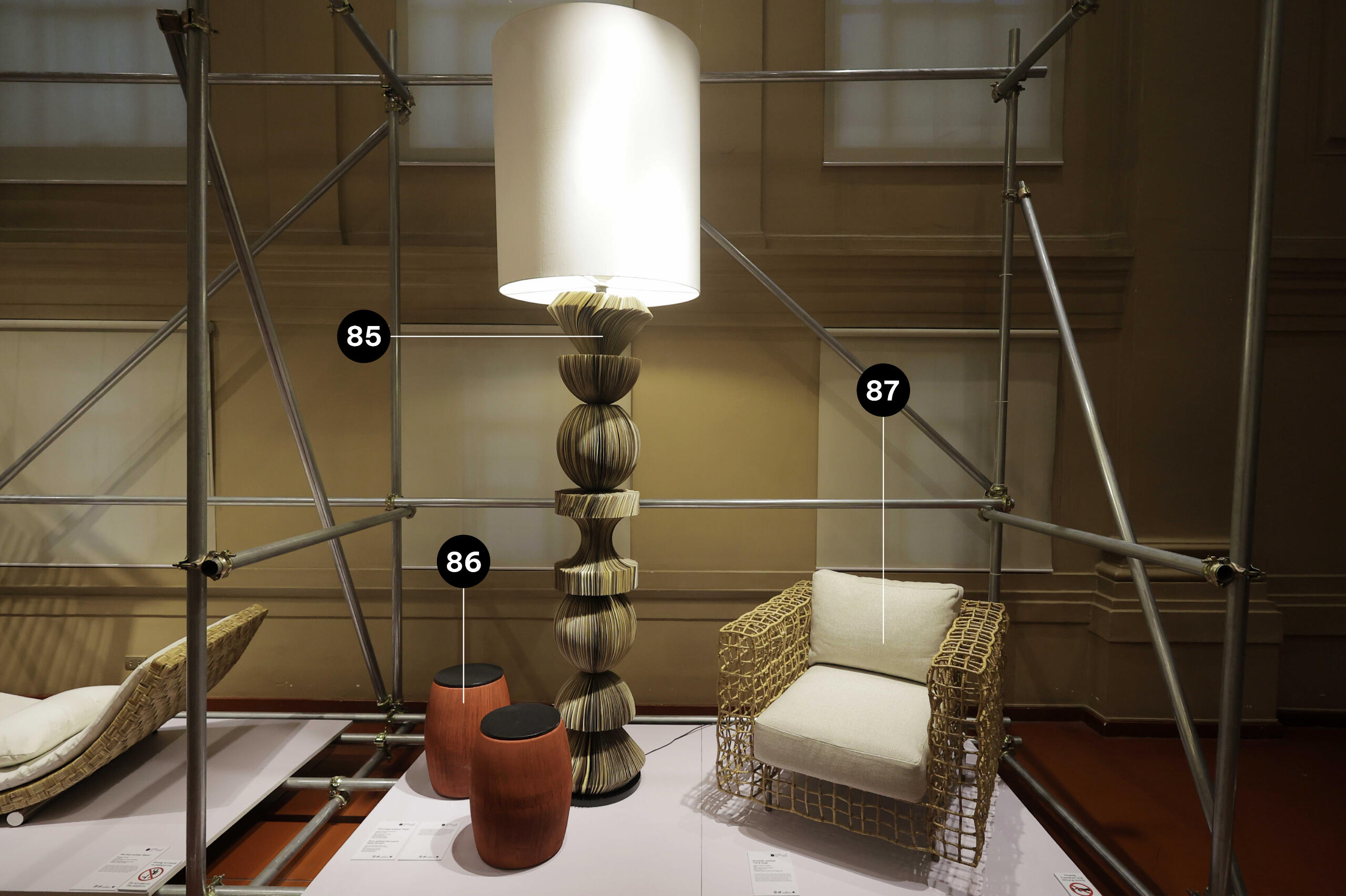
85
Floor lamp, entitled “Tabla”
From the James Bound Collection
Tes Pasola, design
2017
Die-cutting, paper-binding
Base: 37 × 189 cm
Lampshade: 75 × 85 cm
Paper, binding material
Collection: Tony GonzalesMovement 8’s Tes Pasola concentrated her design work on the surprising possibilities of handmade paper. This oversized floor lamp from the cheekily named James Bound Collection brought to fore the idea of paper’s yet unknown possibility, not only as raw material for use with frames and armatures, but as its own structure. Like Kenneth Cobonpue, Carlo Cordaro, Milo Naval, Tony Gonzalez, Budji Layug, Luisa Robinson, and Ann Pamintuan, Pasola cultivated a witty elegance.
86
Pouf, entitled “Gervasoni News 08 Pouf”
From the James Bound Collection
Tes Pasola and Paola Navone, design
2010
Die-cutting, paper-binding
39 cm, diameter; 45 cm tall
Wood, handmade paper
Collection: GervasoniMovement 8’s Tes Pasola concentrated her design work on the surprising possibilities of handmade paper. This oversized floor lamp from the cheekily named James Bound Collection brought to fore the idea of paper’s yet unknown possibility, not only as raw material for use with frames and armatures, but as its own structure. Like Kenneth Cobonpue, Carlo Cordaro, Milo Naval, Tony Gonzalez, Budji Layug, Luisa Robinson, and Ann Pamintuan, Pasola cultivated a witty elegance.
87
Armchair, entited “Yin & Yang”
Kenneth Cobonpue, design
1998
Cane weaving, metalworking
90.5 × 91.5 × 71 cm
Rattan, steel
Collection: Interior Crafts of the Islands, Inc.Kenneth Cobonpue, son of Cebu City’s Betty Cobonpue, took the family’s innovative proclivities into an entirely new direction with “Yin & Yang.” The armchair worked the difference between transparency and solidity, chair and sculpture. As has been the design ethos shared with Movement 8—Budji Layug, Tony Gonzalez, Carlo Cordaro, Luisa Robinson, Ann Pamintuan, Tes Pasola, and Kenneth—this breakout design by the younger Cobonpue references a Philippine spirit without overstatement.
Page 9 of 9
A project of

In partnership with

2001 - 2023
While it is not possible to assume any hard demarcation line between 20th and 21st century design in the Philippines or elsewhere, there is value in marking a turn to systems thinking as the present millennium began to unfold. Filipino designers explored, expanded, and indeed celebrated the myriad types of communities-of-making that realized their concepts for acceptance by global markets. Many continued to work with ateliers inherited from previous generations, thus infusing new products with qualities owing to enduring skills. Others worked by semi-scientifically analyzing market segments. There were also those that began to study the relationships of creative energy and environmentalism.The first quarter of the 21st century for Filipino designers was the historical juncture when their work had to begin comprehending sustainability, limited raw materials and dangerous processes, and “Filipino” or “Philippine” meant seeking greater understanding of social problems and geopolitical dynamics. Hard lessons had to be learned quickly, as, for example, the emergence of China as an economic behemoth, foreclosed a huge part of the markets for low price range commodities. Since these were markets important to Filipino designers and manufacturers, the keenness to global fluctuations became a necessary attitude; and a key to survival.
As technological change in the direction of digital media fed into the design process, Filipino designers maintained a parallel effort for greater understanding of indigenous traditions and plant life. Market challenges were met with refreshed incorporation of local knowledge and systems into both contemporary design and systems design—including grassroots forms of artisanal production that survived the impact of change.Through these developments, the Design Center pushed design as economic driver for the country, through continuous innovation of forms, processes, and materials.
A project of

In partnership with

2001 - 2023
Gallery 26
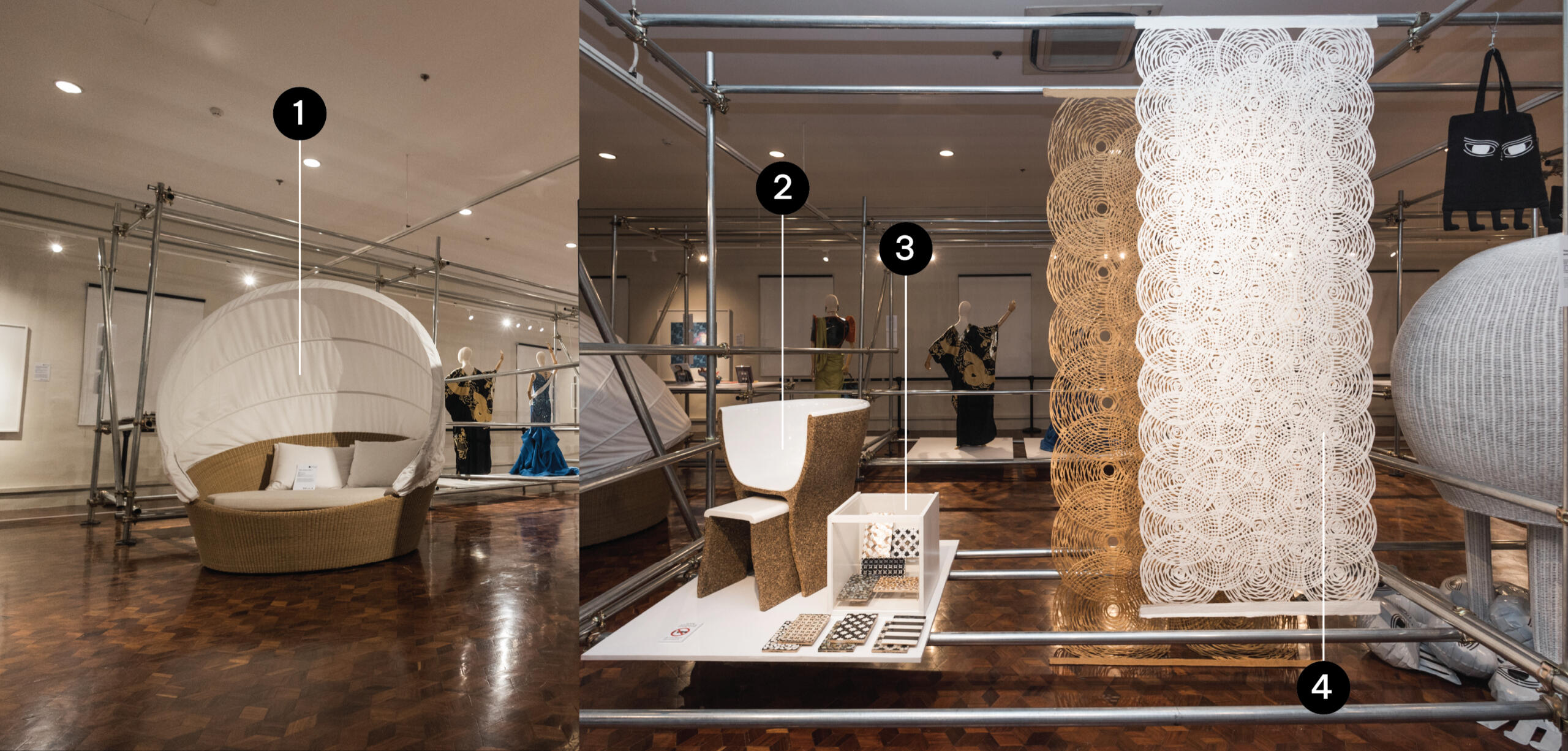
1
Chair, entitled “Orbit””
DEDON
Richard Frinier, design
2003
Weaving, metalworking
216 × 211 × 211 cm
Synthetic fiber, metal (aluminum), synthetic linen (polyester)
Collection: DEDON Manufacturing, IncorporatedDesigner Richard Frinier’s collaboration with the outdoor furniture industry leader DEDON impacted the global market. The features of “Orbit” were then unprecedented: the precision-opening canopy, the 3600 rotational capacity, and the oversize but nevertheless human scale. Outdoor furniture from the Philippines had subsequently moved into the more rarefied markets of luxury resorts and private estates.
2
Chair and Stool, entitled “Club”
Nature’s Legacy
Pedro Delantar, Jr., design
2007
Woodworking, molding, casting
68.5 × 61 × 81 cm
Agro-forest debris (dried leaves, dead twigs), wood-based discarded scraps, stone, water-based binder (proprietary)
NATURESCAST®
MARMORCAST®
Collection: Nature’s LegacyPedro Delantar, verily the spirit of experimentation and innovation at his furniture manufacturing enterprise, brings his projects to fruition in such pieces as “Club Chair and Stool.” This specimen shows the elegance of line and will to deep change, that characterizes Delantar’s furniture in general. The chair is partially made of otherwise disposable wood chips. Its iconic look owes to a grasp of the cultural moment.
3
Material Swatches
TN Philippines
Al Caronan, design
2000s
Shell inlay
Various dimensions
Shells and polyresin
Collection: TN PhilippinesAl Caronan distinguished himself with the constancy and sheer tenacity of his experiments with amalgamated and repurposed techniques. The exercises on exhibit show symmetrical tiling with different geologic materials. Caronan has long demonstrated the vast possibility in materials manipulation and tiling.
4
Handmade paper panels, entitled “Orbit”
MASAECO
Wataru Sakuma, design
2006
Pulping, sieving, drying of fibrous material
120 × 300 cm,
100 × 250 cm
Mulberry fiber
Collection: MASAECOTwo panels in gold and white finish by Wataru Sakuma represents a large field of explorations in papermaking for art and multi-use outcomes. Sakuma works with mulberry fiber but incorporates other materials, including old newspapers, in some product lines. Exhibited are two of the “Orbit” line of paneling that have been used for dividers and wall finishes, or as stand-alone beautiful striking presence.
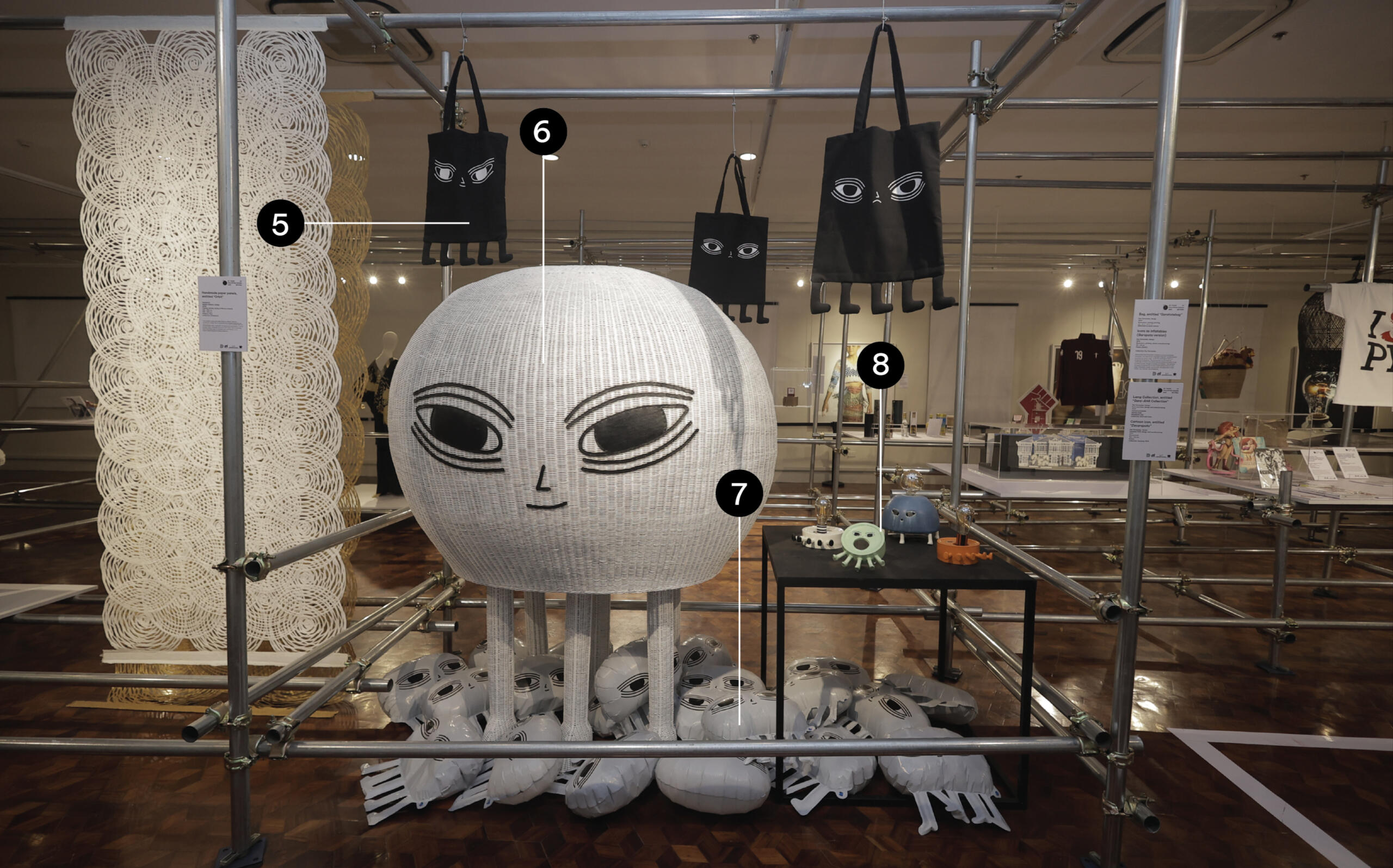
5
Bag, entitled “Garatotebag”
Dex Fernandez, design
2007
Illustration, sewing, printing
26 × 18.5 × 18.5 cm
Silkscreen on sewn canvas
Collection: Dex FernandezVisual artist Dex Fernandez created a cartoon character, Garapata—the fully blood-engorged dog tick—to abundantly populate his dense, large-scale line drawings of life in a benighted Philippines. The bloody tick is innocuous as multitudes of black and white lines but retains its power to be an affectionate critique of society as infested. The cartoon Garapata morphed into an icon materializing hotly on cool bags, inflatables, lamps, and so forth. Its popularity is best called—not viral but—an infestation.
6
Cartoon icon, entitled “Zacarapata”
Dex Fernandez, design
Zacarias 1925, design and manufacturing
2018
Wickerwork
183 × 153 cm
Rattan
Collection: Zacarias 1925Visual artist Dex Fernandez created a cartoon character, Garapata—the fully blood-engorged dog tick—to abundantly populate his dense, large-scale line drawings of life in a benighted Philippines. The bloody tick is innocuous as multitudes of black and white lines but retains its power to be an affectionate critique of society as infested. The cartoon Garapata morphed into an icon materializing hotly on cool bags, inflatables, lamps, and so forth. Its popularity is best called—not viral but—an infestation.
7
Icons as inflatables (Garapata version)
Dex Fernandez, design
2018
Illustration, printing, plastic manufacturing
48 × 48 cm
Plastic (Mylar)
Collection: Dex FernandezVisual artist Dex Fernandez created a cartoon character, Garapata—the fully blood-engorged dog tick—to abundantly populate his dense, large-scale line drawings of life in a benighted Philippines. The bloody tick is innocuous as multitudes of black and white lines but retains its power to be an affectionate critique of society as infested. The cartoon Garapata morphed into an icon materializing hotly on cool bags, inflatables, lamps, and so forth. Its popularity is best called—not viral but—an infestation.
8
Lamp Collection, entitled “Gara-AHA Collection”
Dex Fernandez
Bumi and Ashe, design and manufacturing
2022
Various processes
Various sizes
Stoneware clay
Collection: Bumi and AsheVisual artist Dex Fernandez created a cartoon character, Garapata—the fully blood-engorged dog tick—to abundantly populate his dense, large-scale line drawings of life in a benighted Philippines. The bloody tick is innocuous as multitudes of black and white lines but retains its power to be an affectionate critique of society as infested. The cartoon Garapata morphed into an icon materializing hotly on cool bags, inflatables, lamps, and so forth. Its popularity is best called—not viral but—an infestation.
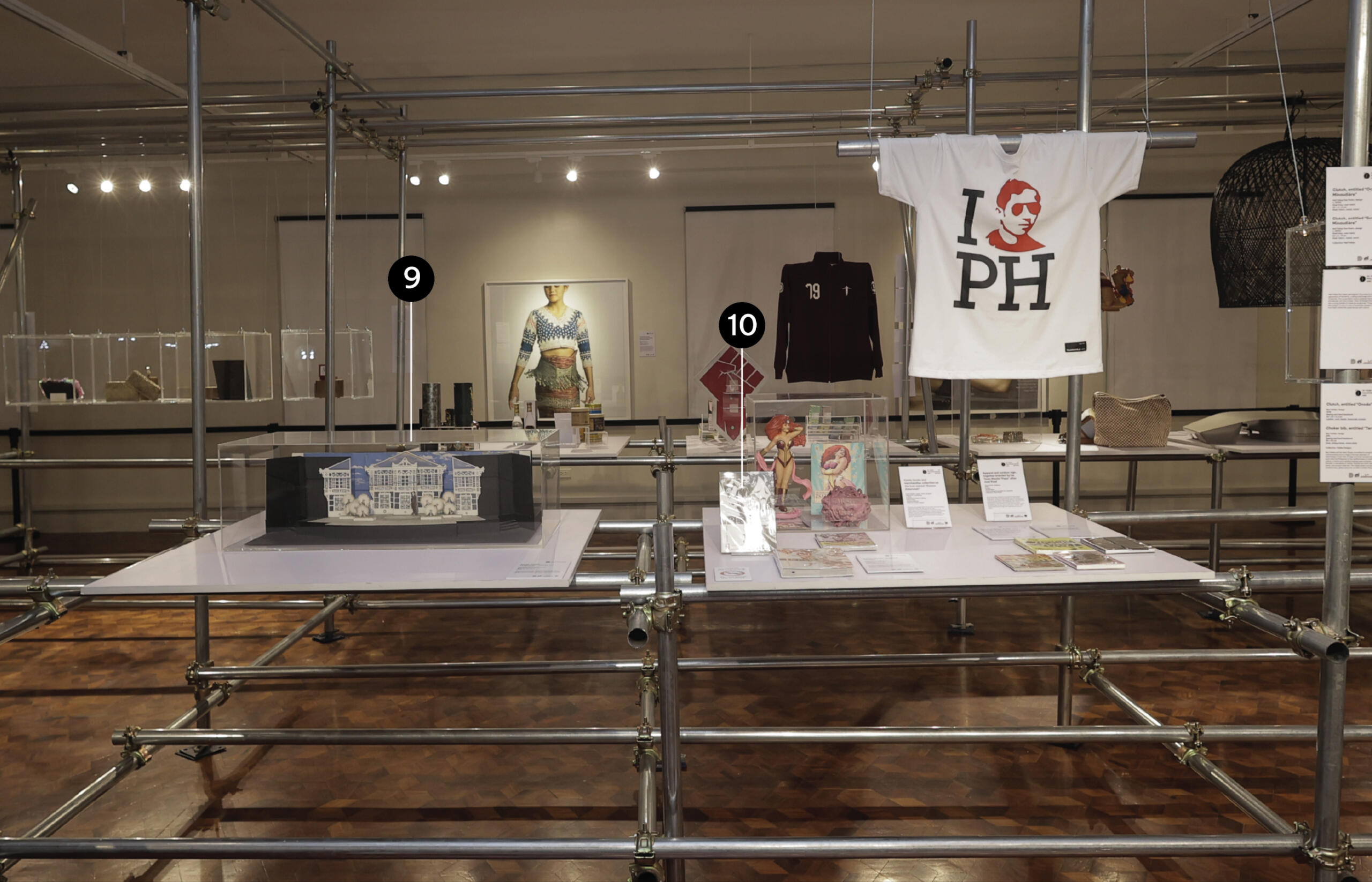
9
Scale model
Production design for Alikabok
Gino Gonzales, set design
Naomi Matsumoto, lighting design
Tony Espejo, director
MUSICAT, theater company
Music Museum, venue
2002
Collection: Gino GonzalesContemporary production design for the Manila social and cultural leadership circles found in Gino Gonzales an avatar of edgy Filipiniana. The set for Alikabok is only one example of a body of work that rethinks what might be the Filipino under the present complex circumstance. The quotation of surrealism in this set is among Gonzales’ techniques for his departures from conservatism.
10
Comic books, entitled “Trese”
Budjette Tan, writing
Kajo Baldisimo, illustration
Visprint Inc., publishing
c. 2000s
Writing, illustration, printing, bookbinding
Various sizes
Paper and printers’ ink
Collection: Kajo Baldisimo and Avenida BooksThe crime-horror comic book series “Trese” by Budjette Tan and Kajo Baldisimo was first of all a phenomenal success on its own, in the traditional print medium, its content, a seamless deployment of Filipino otherworldly creatures in urban grit settings. Its anime aesthetic connected securely with the Japanicized tastes of the young Philippine demographic, upon which was quickly built the smash success of its reincarnation as streamed through Netflix.
Page 1 of 8
A project of

In partnership with

2001 - 2023
Gallery 26
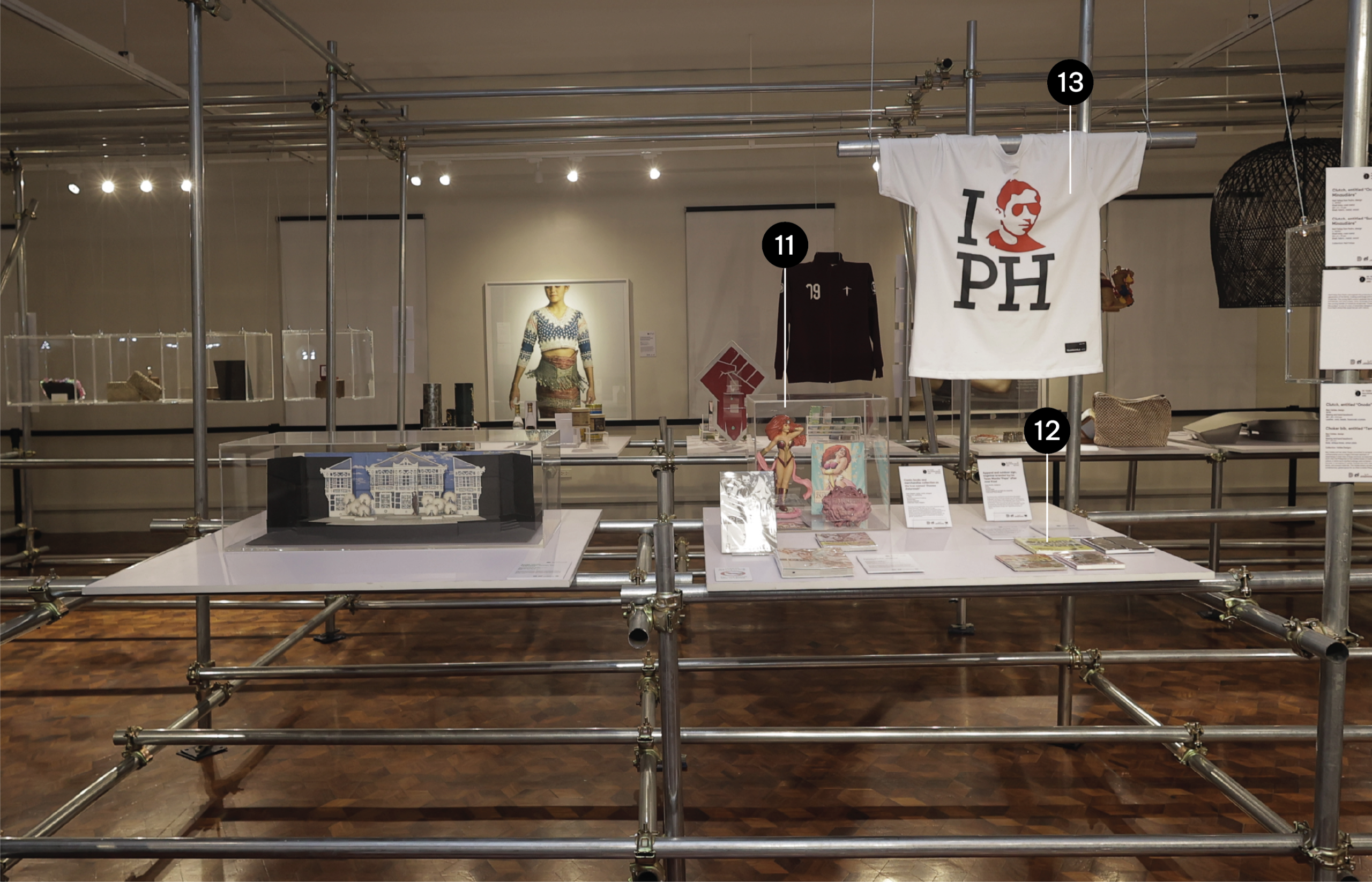
11
Comic books and merchandise collection on the icon named “Zsazsa Zaturnnah”
Carlo Vergara, author, artist, designer
Visprint Inc., publishing
c. 2002
Various processes of making
Various sizes
Various materials
Collection: Carlo VergaraThe busty and exaggeratedly curvy comics character named Zsazsa Zaturnnah—the alter ego Ada is a gay beautician—jumped from Vergara’s comic fiction (“Ang Kagila-gilalas na Pakikipagsapalaran ni Zsazsa Zaturnnah”) to theater to movies in quick progression until its presence became phenomenal in both haute and popular culture. The character has been studied in academia for its impact on gender representation.
12
Books, entitled “Bakit Baliktad Magbasa ng Libro Ang Mga Pilipino?”
(2001), “Ang Paboritong Libro ni Hudas” (2003, and “Ang Alamat ng Gubat”
(2003), “Lumayo Ka Nga Sa Akin”(2011)
Carlo Vergara, author, artist, designer
Visprint Inc., publishing
c. 2002
Various processes of making
Various sizes
Various materials
Collection: Carlo VergaraBob Ong, whoever he is, is the hero of an entire generation, who like their humor dry, their graphic design equally undecorative (or anti-decorative), and their book content, droll. The person behind the pseudonym Bob Ong has a take on life in the Philippines that makes him a funny, un-tragic Pilosopo Tasio, Rizal’ homegrown commentator. More: Ong’s sense of graphic design fully contemporizes his ironic detached-attached grasp of Filipino identity.
13
Apparel and outdoor sign, together branded by/as Team Manila “Pepe” after José Rizal
Team Manila, designers
2005
Printing
Various sizes
Cotton (apparel) and light box assembly
Collection: Team ManilaThe National Hero José Rizal is resurrected by the graphic design studio Team Manila as updated icon, with aviator sunglasses, animated a widely shared taste for cool Filipiniana in the 1st decade 2000s in the Philippines. Team Manila saw the proliferation of the icon in consumer goods for a young demographic. Their panache was met with enthusiasm by their consumer base and the some. Importantly, however, Team Manila fused graphic design with a generational sense of Filipino.
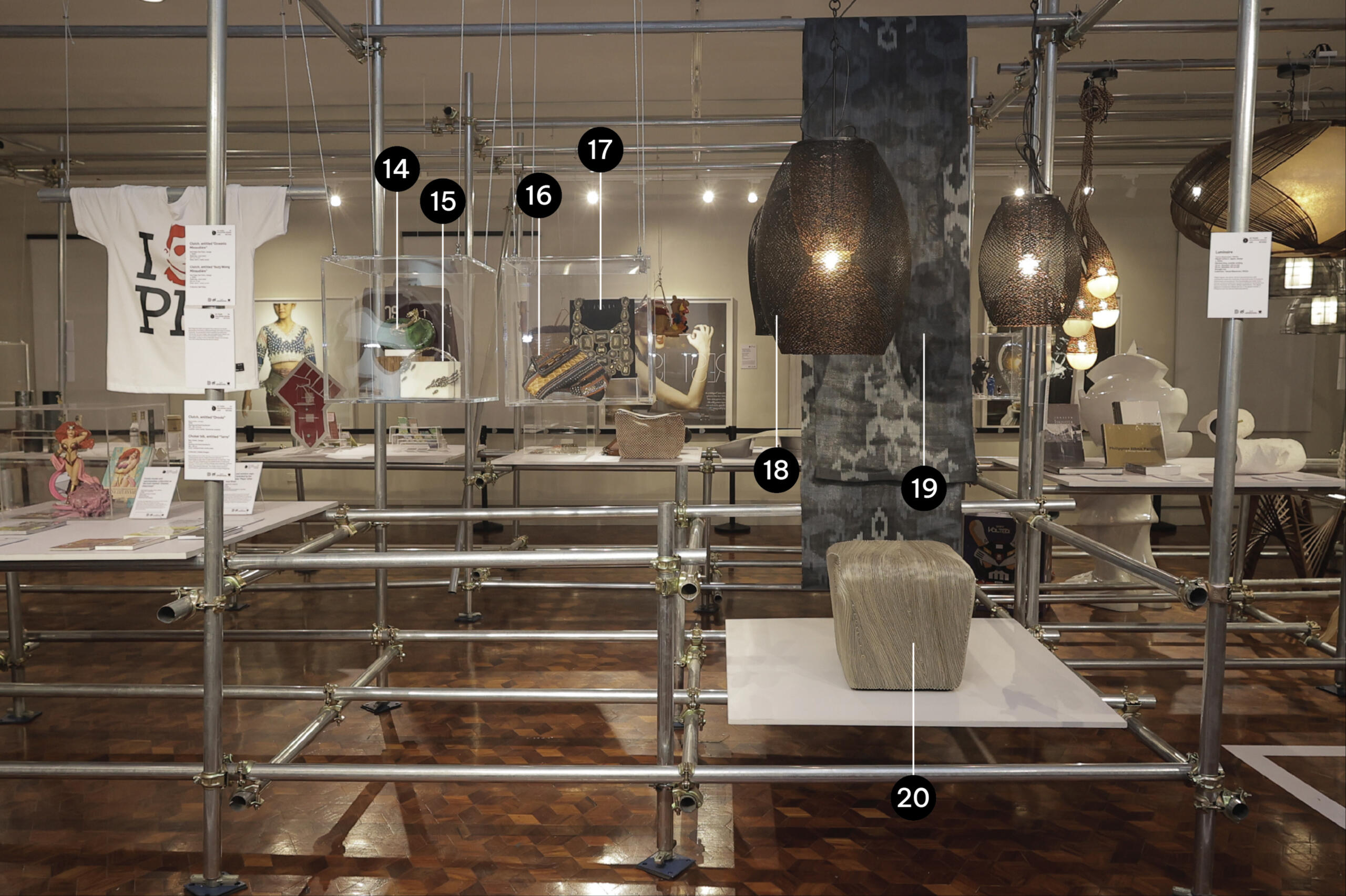
14
Clutch, entitled “Suzy Wong Minaudière”
Neil Felipp San Pedro, design
c. 2010s
Shell inlay, cast metal
22 x 4 × 11 cm
Shell, fabric, metal, wood
Collection: Neil FelippNeil Felipp San Pedro reimagined the products of an earlier generation of his family, making solid bags with inlays of various materials. The young Neil’s output updated the styling and introduced, not only a basic, boxy rectangle (hand-sized), but the curving handle of miniature sculptures. “Oceania Minaudière” is one of a line of dreamlike designs that emerge from Neil’s dreamlike experiences with nature.
15
Clutch, entitled “Oceania Minaudière”
Neil Felipp San Pedro, design
c. 2010s
Shell inlay, cast metal
20 × 4 × 11 cm
Shell, fabric, metal, wood
Collection: Neil FelippNeil Felipp San Pedro reimagined the products of an earlier generation of his family, making solid bags with inlays of various materials. The young Neil’s output updated the styling and introduced, not only a basic, boxy rectangle (hand-sized), but the curving handle of miniature sculptures. “Oceania Minaudière” is one of a line of dreamlike designs that emerge from Neil’s dreamlike experiences with nature.
16
Clutch, entitled “Onoda”
Bea Valdes, design
2018
Sewing and hand beadwork
28 × 20 × 5.5 cm
Leather, cord, beads, Swarovski crystals
Collection: Valdes DesignsBea Valdes and her sister Marga committed to exceptional craftsmanship and to a highly informed aesthetic of assemblage in their lines of bags and body accessories. Their work cites the Philippines at the rarefied levels of traditional culture, in which such rarefied makings were achieved, mostly in the past, in remassing of metals, threads and cloth, beads, stone, and unusual materials. The Valdes sisters carved a contemporary, global space for an often invisible Philippines.
17
Choker bib, entitled “Terra”
Bea Valdes, design
2011
Sewing and hand beadwork
98 × 20 cm
Gold, antique brass, armor plate
Collection: Valdes DesignsBea Valdes and her sister Marga committed to exceptional craftsmanship and to a highly informed aesthetic of assemblage in their lines of bags and body accessories. Their work cites the Philippines at the rarefied levels of traditional culture, in which such rarefied makings were achieved, mostly in the past, in remassing of metals, threads and cloth, beads, stone, and unusual materials. The Valdes sisters carved a contemporary, global space for an often invisible Philippines.
18
Luminaire
Vulcan Resources / MCCA
Miguel Carlos C. Aguas, design
c. 2010s
Metalworking, powder coating
23 cm, diameter; 43 cm tall
35 cm, diameter; 60 cm tall
Wrought iron
Collection: Vulcan Resources / MCCAMiguel Aguas, the name, came to be synonymous with metalworks made into matrices of the small scale of lacework. Matte black and sculptural, the lampshades and other home fixtures contemporized the concept of shade for luminaires and form for furniture, for interior design applications. The Aguas signature metalworks helped secure, in the global market, a Philippine look that leaves folksiness behind.
19
Textile, entitled “Hafak Menaul” in Tboli
Annaliza Angcoy, design and weaving
Maricris Floirenda-Brias, design
Weaving, warp ikat dyeing
500 × 60 cm
Abaká (Musa textilis Neé) fiber, indigo
Collection: TADECO HomeThe Davao City-based Maricris Floirendo Brias, leading the inventive company TADECO, has focused on the fiber plant abaká (Musa textilis Neé) as premiere plant material, hence as symbolic of site specificity. Abaká has been a dominant plantation species in the Davao provinces since the late 19th century. Brias has worked with the Tboli-language speakers of South Cotabato and other groups contemporize applications.
20
Stool, entitled “Bark”
Maricris Floirendo-Brias, design
2008
Weaving, woodworking, upholstery
40 × 40 × 45 cm
Abaká (Musa textilis Neé), wood frame
Collection: TADECO HomeThe Davao City-based Maricris Floirendo Brias, leading the inventive company TADECO, has focused on the fiber plant abaká (Musa textilis Neé) as premiere plant material, hence as symbolic of site specificity. Abaká has been a dominant plantation species in the Davao provinces since the late 19th C. Brias has worked with the Tboli-language speakers of South Cotabato and other groups contemporize applications.
Page 2 of 8
A project of

In partnership with

2001 - 2023
Gallery 26
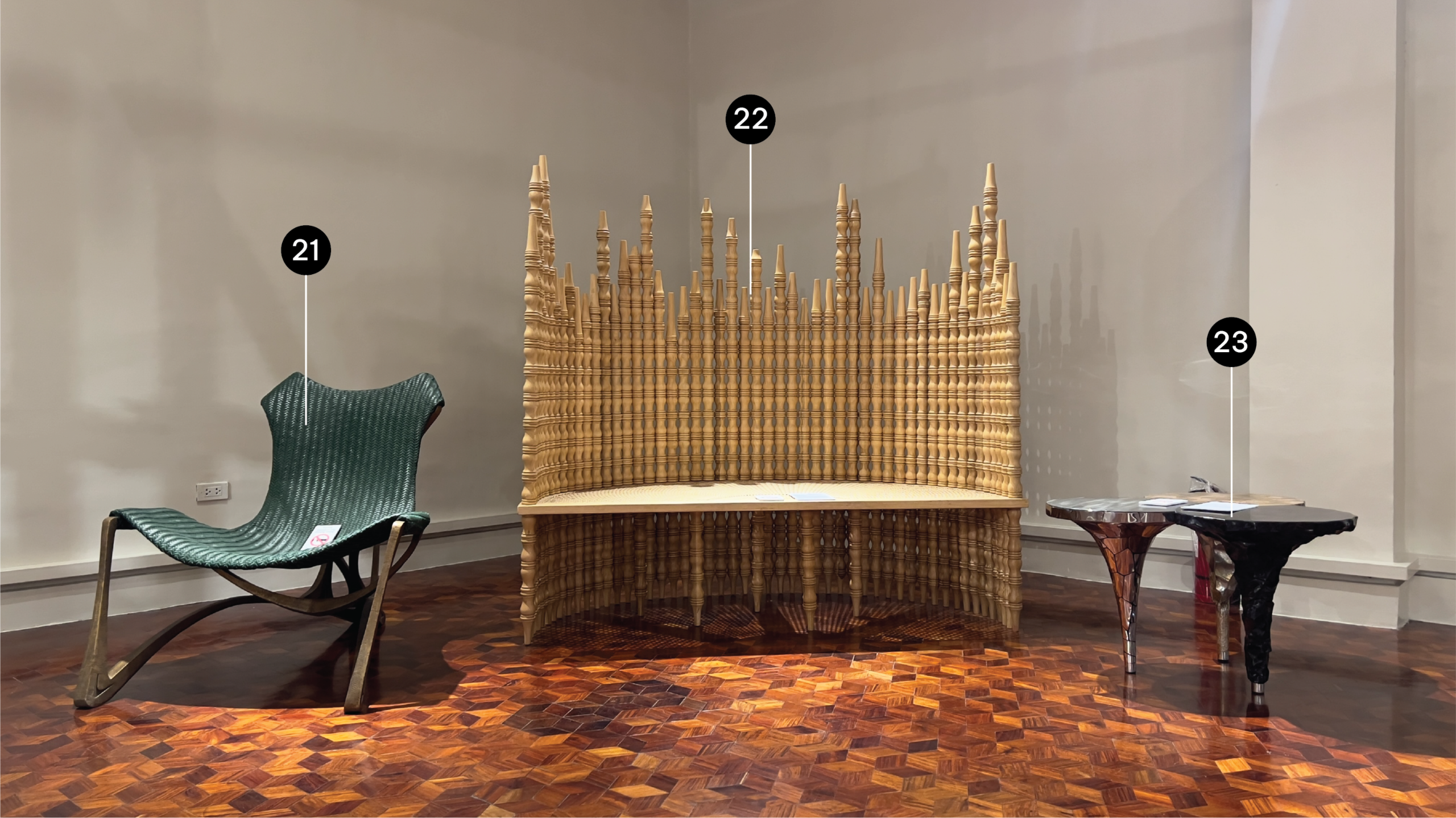
21
Chair, entitled “Loopy”
Jude Tiotuico, Industria Edition, design
2015
Metal working (hammering and bending), weaving
108 cm x 93cm x 92 cm
Cowhide leather, steel
Collection: Jude TiotuicoIndustria Edition, the company, has been highly regarded for more than two decades for metalworking applied to furniture design innovation. “Loopy” is one of myriad successful experiments that blend the sculptural qualities metal facilitates, with materials that open up other dimensions. Tiotuico maintains focus on the handmade qualities of metalworking, and in this sense Filipinizes his work.
22
Chair, reinvented sofa entitled “Gregoria Lounge”
Ito Kish, design
2012
Woodworking, wood turning
180 × 82.5 × 172.7 cm
Wood (Gmelina arborea), bamboo (Bambusa vulgaris) and rattan (unknown variety)
Collection: Ito KishIto Kish set out to rework tired ideas of “Filipino”—deliberately transiting from stereotype to refiguration of iconic form—and succeeded with pieces such as “Gregoria Lounge.” For this kind of outcome, he has drawn from quickly accessible visual cues, in this case, balustrades of Spanish colonial architecture. Kish takes these cues and through his reassembled elements, concocts, simultaneously, furniture and surprise. The surprise turns are as much the mood of the furniture and their “make.”
23
Table, entitled “Trizona”
Bon-Ace Fashion Tools, Inc.
2018
Hand-worked inlay and polishing
90 x 60 cm
Natural colored mother of pearl, shells, stainless steel
Collection: Bon-Ace Fashion Tools, Inc.Bon-Ace explored its range of shell material in furniture forms that continue to evoke its origin in nature. “Trizona,” for example, evokes underwater life, and, with the nacre lustre of the marine material—which is furthermore sustained by the unusual spindly shape—the effect is immediate. Bon-Ace furniture showly masterful comprehension of its sources.
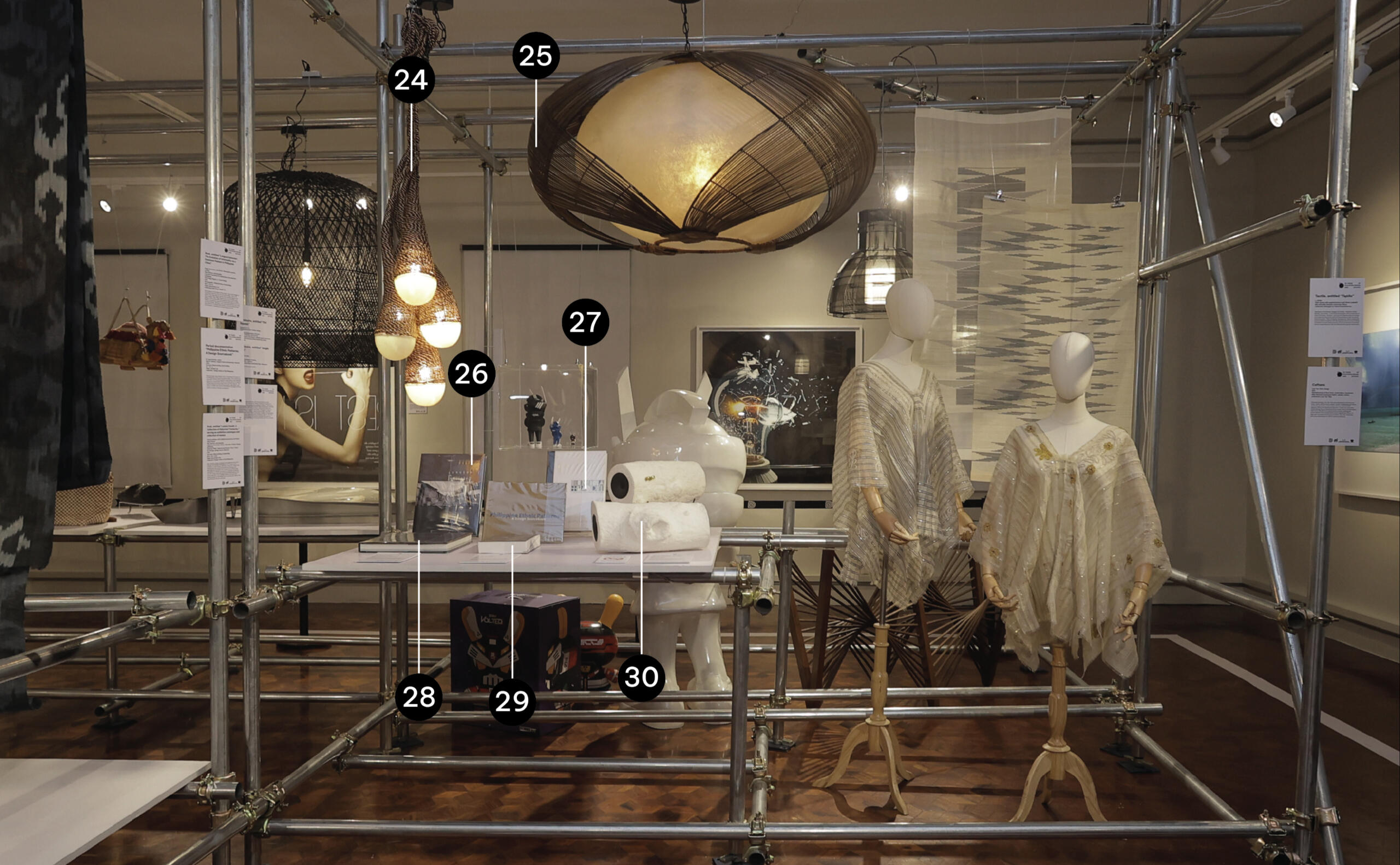
24
Luminaire, entitled “Jungle Vine”
Hacienda Crafts
2016
Various processes of making
35.6 × 30.5 × 101.6 cm
Metal, Abaká (Musa textilis Neé) fiber, fiberglass
Collection: Hacienda CraftsHacienda Crafts Company, led by architecture-trained designer Cristina Borromeo Gaston, reworks a full gamut of organic materials ancestrally available to Filipinos. Aside from the ubiquitous abaká (Musa textilis Neé), the company variously works burî and raffia (respectively, young leaf sheaths and mature leaves of Corypha elata Roxb.), baragubay (twigs of coconut, Cocos nucifera), payâ (coconut shell), capiz shell (windowpane oyster Placuna placenta), sukdáp and kagingkíng (split trunk and twigs of bamboo, Bambusa vulgaris), nito vine (Lygodium circinatum), the leaves of pandán (screwpine or Pandanus amaryllifolius), and arurog (rattan vine from a number of varieties).
25
Luminaire, entitled “Obi Squash”
Hacienda Crafts
Christina Borromeo-Gaston, design
2010
Weaving, metalworking, pultrusion
111.7 cm, diameter; 58.4 cm tall
Burî (Corypha elata Roxb.), bakbák rope (twined from the sheath of banana (Musa sapientum), metal, fiberglass
Collection: Hacienda CraftsHacienda Crafts Company, led by architecture-trained designer Cristina Borromeo Gaston, reworks a full gamut of organic materials ancestrally available to Filipinos. Aside from the ubiquitous abaká (Musa textilis Neé), the company variously works burî and raffia (respectively, young leaf sheaths and mature leaves of Corypha elata Roxb.), baragubay (twigs of coconut, Cocos nucifera), payâ (coconut shell), capiz shell (windowpane oyster Placuna placenta), sukdáp and kagingkíng (split trunk and twigs of bamboo, Bambusa vulgaris), nito vine (Lygodium circinatum), the leaves of pandán (screwpine or Pandanus amaryllifolius), and arurog (rattan vine from a number of varieties).
26
Book, entitled “Lungsod Iskwater: The Evolution of Informality as a Dominant Pattern in Philippine Cities”
Paulo Alcazaren, Luis Ferrer, Bienvenido Icamina, writing
Neal Oshima, photography
Luis Yulo Foundation for Sustainable Development, publishing
Felix Mago Miguel, Jr., book design
2011
Photography, offset printing, bookbinding
30.5 × 23 cm
Paper and printers’ ink
Collection: Felix Mago Miguel, Jr.Book design and the figure of the sought-after book designer / art director had come into its own by the 1990’s. And in the 2000s, Felix Mago Miguel had become a leading figure in the fully emergent field. Mago Miguel took up myriad topics and projects, and worked with such leading collaborators as Neal Oshima, to produce volumes that are as memorable for form as much as content. “Iskwater” is an unprecedented look into urban poor districts of Metropolitan Manila, to promote discernment of informality of dwelling as rich sociological terrain.
27
Book, entitled “Lumina Pandit: A Collection of Historical Treasures,” serving as exhibition catalogue and collection of essays
Various authors, with exhibition annotation by Marian Pastor Roces
Wig Tysmans, photography
Miguel de Benavides Library, University of Santo Tomas, publishing
Asuncion “Baby” Imperial and Damien “Coco” Anne /
B+C Design, design and art direction
2010
Full color offset printing, bookbinding
30.5 × 22 × 4 cm
Paper and printers’ ink
Collection: Design Center of the PhilippinesBaby and Coco Anne, principals of the graphics studio B+C, took up the unusually challenging work of designing the exhibition “Lumina Pandit: 400 Years of the UST Library” and subsequently the volume that served as catalogue and expanded text foundation. B+C evoked various letterpress conventions to visually summarize the passage of centuries. The UST Library owns volumes and incunabula dating to as early as the 16th C. B+C’s design direction and execution remains singular in the Philippines as a postmodern take on the visual history of the print process.
28
Book, entitled “The Art of Book Design”
Felix Mago Miguel, book design
Amelia Zubiri-Miguel, writing
Foreign Service Institute (FSI), publishing
2022
Full color, offset printing, bookbinding
31 x 29 x 3 cm
Paper and printers’ ink
Collection: Felix Mago Miguel, Jr.Felix Mago Miguel was given the opportunity by the Department of Foreign Affairs, Foreign Service Institute, to articulate his views on book design in this volume. The Bohol-based graphic designer hence became the singular practitioner of his field to put forward a personal design aesthetic—however based on Mago Miguel’s cited precedents.
29
Book, entitled “Almanak ng Isang Aktibista”
Karl Castro, book design
Rolando B. Tolentino, writing
2011
Offset printing, bookbinding
23 × 15.5 cm
Paper, printers’ ink
Collection: Design Center of the PhilippinesFrom the 2nd decade of the 2000s, Conceptual and Installation Art practitioner, and graphic designer Karl Castro took book design into the publishing field of academic books—well outside the “coffee table book” genre. This shift—enhancing without decorating books that endeavor substantive discussion—gave Castro and his generation of designers a platform for conceptually driven design. “Almanak ng Isang Aktibista” is an example of design inhering in thoughtfulness.
30
Audio speaker, entitled “Symbiosis II (Log-Fi)”
MASAECO
Stanley Ruiz, design
2011
Sculpture, papermaking
21 × 16.5 × 35.6 cm
Paper pulp, metal, electronics
Collection: MASAECOIndustrial designer Stanley Ruiz worked paper pulp into a sculptural rendering that furthermore houses an audio speaker in “Symbiosis II (Log-Fi).” The functional object conveys the spirit of Ruiz’s work, often in collaboration with select manufacturers and other designers. His signature—choreography between organic and human-made materials, whimsy, and gravitas—allows Ruiz to furthermore morph from one intended function to another. Beauty in his practice clearly emanates for surprise twists.
Page 3 of 8
A project of

In partnership with

2001 - 2023
Gallery 26
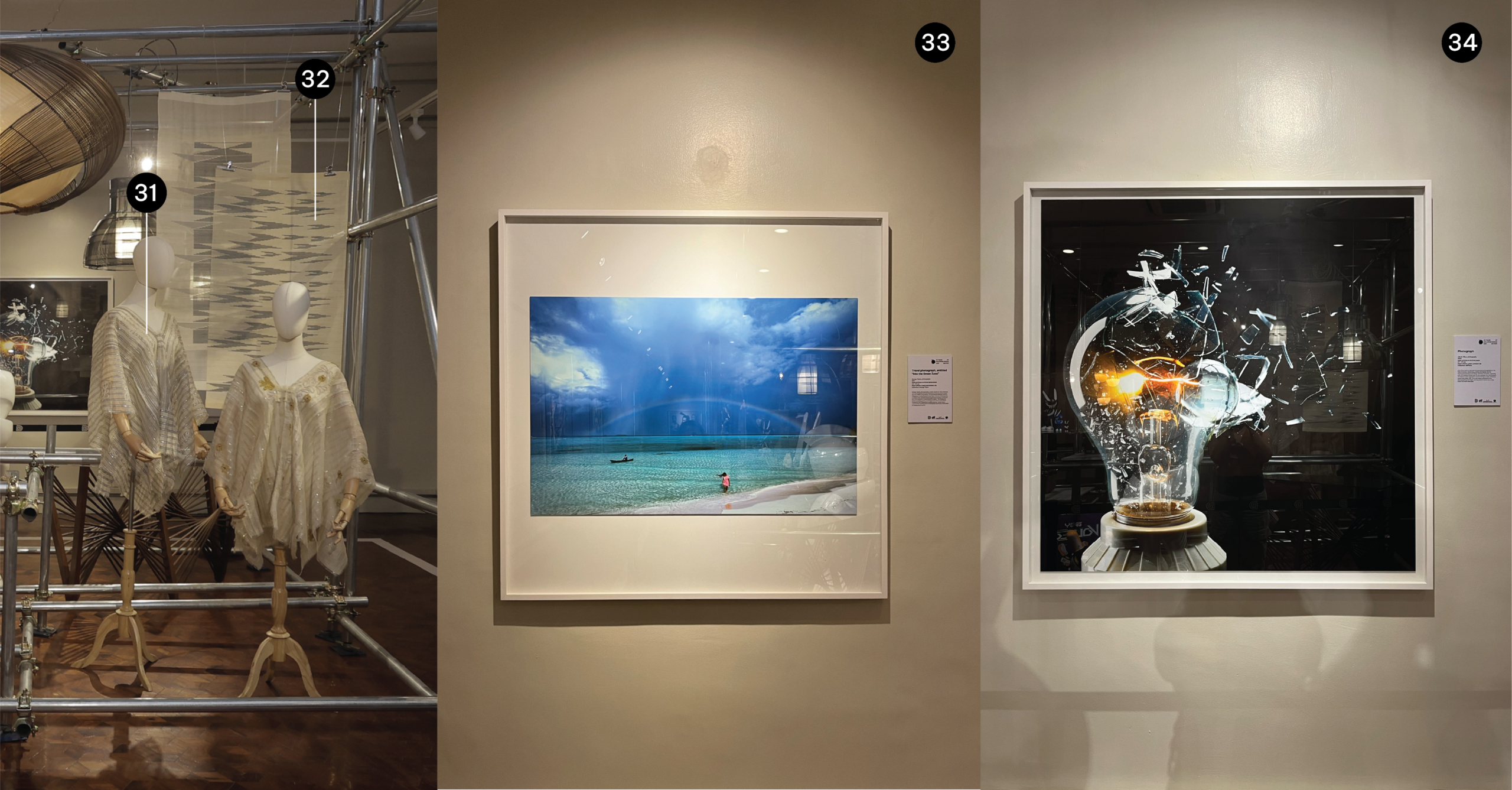
31
Caftans
Lulu Tan-Gan, design
2011
Handweaving on floor loom, embroidery, beadwork
Piña (Ananas cosmosus) fabric, beads, cotton
Collection: Lulu Tan-GanKnitwear pioneer Lulu Tan-Gan reinvented piña clothing from fussy, rather stiff (or overly slack), travel-challenging garments to quietly attractive, travel-easy, and low maintenance apparel. Piña in her hands can be worn, mostly as outerwear, frayed along the cut lines (but firmly woven along the selvages); bias cut to benefit from natural fall on a body; appliquéd, embroidered, and beaded lightly and to gossamer effect, to help with the ergonomic drop as bodice. Tan-Gan liberated piña from attachment to 19th C notions of beauty.
32
Textile, entitled “Tepiña”
c. 2010s
Plain weave with supplementary weft floats (suksúk)
Silk with piña (Ananas cosmosus) fibers
Collection: Rurungan sa Tubod Foundation Inc.Members of the Manila-Baguio Lim family—Adelaida, niece Ramby, and others—commenced pineapple cloth production in Puerto Princesa, Palawan, starting with planting the bromeliad in an island province that did not have a history with the South American plant. Their company, Rurungan sa Tubod, organized local handloom weavers with the express intention of providing consistent income where paucity of this consistency is marked; and to create fabrics in silk and piña blends of great refinement.
33
Travel photograph, entitled “Into the Green Zone”
George Tapan, photography
2011
Inkjet printing on archival grade paper
117 × 117 cm
Paper (Photo Luster) and printer’s ink
Collection: George TapanGeorge Tapan, photographer, is well-known for verily defining travel photography for the Philippines during his entire career from the 1990s to the 2000s. His work hence defines a kind of Philippines for specifically foreign eyes—the act of looking into a country that, however events signal the contrary, in the inner eye of its residents is quite beautiful indeed. The scenes are almost surreally perfect, as though both nature and culture conspire in the Philippines to create dreams. Tapan hence captures the meeting place of foreigners and locals, both intent on seeing dream space.
34
Photograph
John K. Chua, photography
2003
Inkjet printing on archival paper
117 × 117 cm
Paper (Photo Luster), printers’ ink
Collection: AdPhotoJohn Chua was for decades the premiere photographer in the field of product advertising, setting the highest bar for technical proficiency and sharp aesthetic concepts. Shooting with 120 medium format and 25 mm cameras, he, and his team at Adphoto were nonpareil in shoots having to meet ambitious advertising ideas. Still, Chua also spent substantial time photographing the Ifugao, among whom—as he was to say often—his heart belonged.
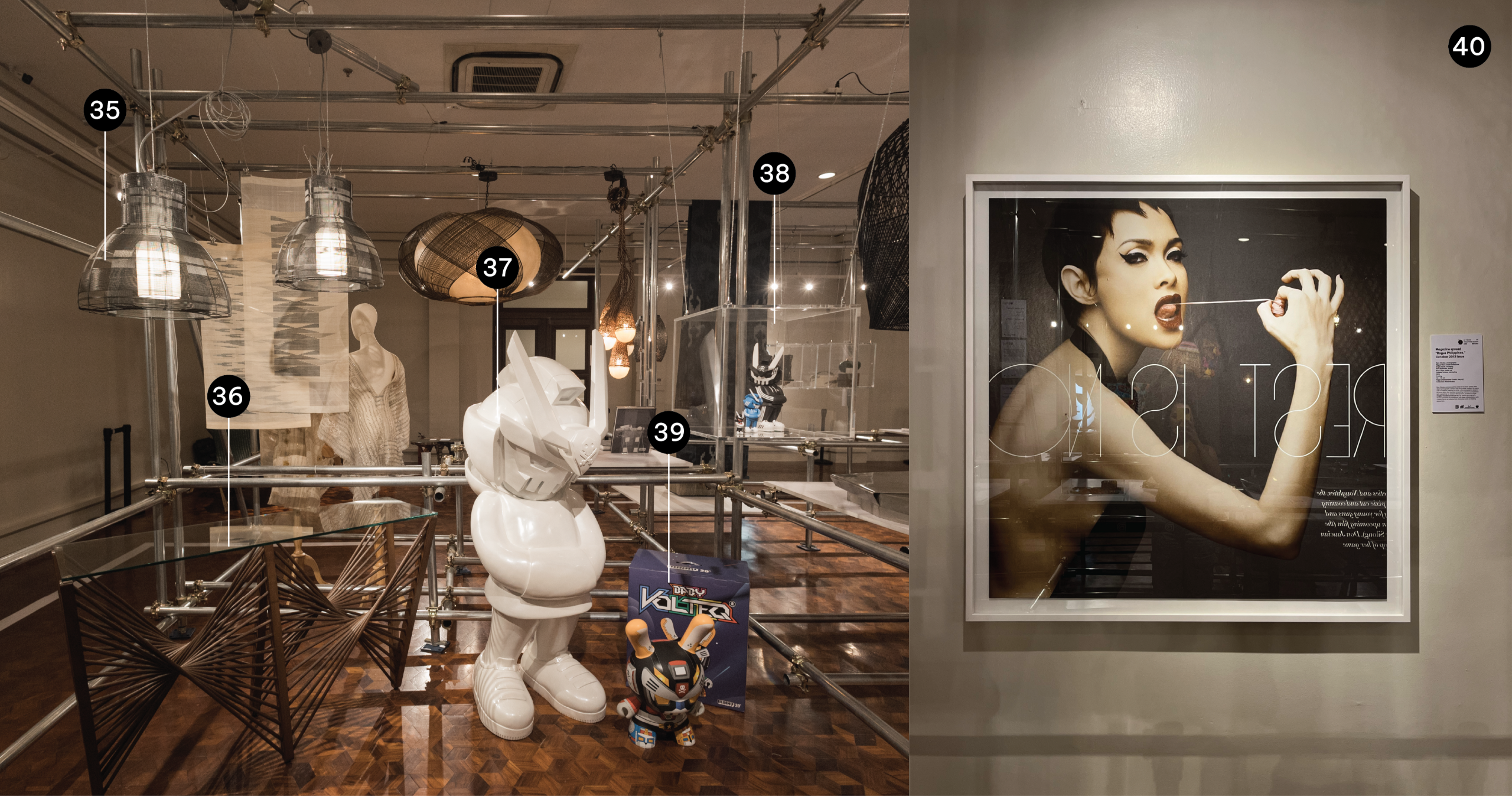
35
Luminaire
Schema
Celia Jiao, design
2012
Wire weaving
47.5 × 46 cm
Wire
Collection: SchemaCelia Jiao and family were doing well exporting Christmas decorations—together with many other companies during the heyday of this market—when the rise of China as a global market player collapsed the preference this and other Philippine products. Needing to shut down operations but unwilling to let go of skilled workers with whom the family had worked for years, Jiao started experimenting with electric wires, a common material, woven to form luminaires. Success in the new market segment arrived in due course.
36
Table, entitled “Geo”
Vito Selma, design
2015
Woodworking, carpentry
132 × 41.5 × 82 cm
Wood
Collection: Design Studio Vito SelmaVito Selma belongs to second- and third-generation Cebu furniture designers and manufacturers, following in the wake of the achievements of their parents and grandparents. In the Philippines in general, Vito’s generation is understood to have done their elders proud. In the case of “Geo,” Selma deploys his fan-like composition of wood lines to convey lightness but also stability. Others of his furniture pieces similarly use wood lines as though these move.
37
“Blank White Ultra TEQ63”
Juanito Maiquez, also known as QUICCS, design
2023
Rotational molding / rotocasting
152.5 cm tall
Plastic (fiberglass)
Collection: QUICCSAs a child, Juanito Maiquez grew up with the Japanese animation series on television, Voltes V; later, with the next generations of similar cartoons until the period of anime. The figures he invents and fabricates in resin under the brand name QUICCS, conjured from his anime-driven imagination, have a global following. Indeed, each of the figures are rolled out of production to waiting fans in many countries. The figures are known clearly to be a Filipino riff on the Japanese-global phenomenon.
38
“Adidas TEQ63”
Juanito Maiquez, also known as QUICCS, design
2020
Injection molding
Various sizes
Plastic (polyvinyl chloride)
Collection: QUICCSAs a child, Juanito Maiquez grew up with the Japanese animation series on television, Voltes V; later, with the next generations of similar cartoons until the period of anime. The figures he invents and fabricates in resin under the brand name QUICCS, conjured from his anime-driven imagination, have a global following. Indeed, each of the figures are rolled out of production to waiting fans in many countries. The figures are known clearly to be a Filipino riff on the Japanese-global phenomenon.
39
“VOLTEQ Dunny”
Juanito Maiquez, also known as QUICCS, design
2022
Injection molding
51 cm tall
Plastic (polyvinyl chloride)
Collection: QUICCSAs a child, Juanito Maiquez grew up with the Japanese animation series on television, Voltes V; later, with the next generations of similar cartoons until the period of anime. The figures he invents and fabricates in resin under the brand name QUICCS, conjured from his anime-driven imagination, have a global following. Indeed, each of the figures are rolled out of production to waiting fans in many countries. The figures are known clearly to be a Filipino riff on the Japanese-global phenomenon.
40
Magazine spread
“Rogue Philippines,” October 2013 issue
Mark Nicdao, photography
Miguel Mari, creative direction
Angel Jacob, modeling
Pam Quiñones, styling
Ricci Chan, make-up
Celeste Tuviera, hairstyling
2013
Printing
112 × 112 cm
Paper (Hahnemühle FineArt Baryta)
Collection: Mark NicdaoMark Nicdao commenced his career in the early 2000s when digital photography came to fore as a viable medium. His was a case of medium meeting the artist, who proceeded to shape a personal idiom that blended compelling technical competence with a proclivity for theater-like narrative, arrested in single images. The idiom proved perfect for fashion photography. Nicdao sustained his momentum with deep collaborations with a select few in an industry that otherwise works on fleeting encounters.
Page 4 of 8
A project of

In partnership with

2001 - 2023
Gallery 26
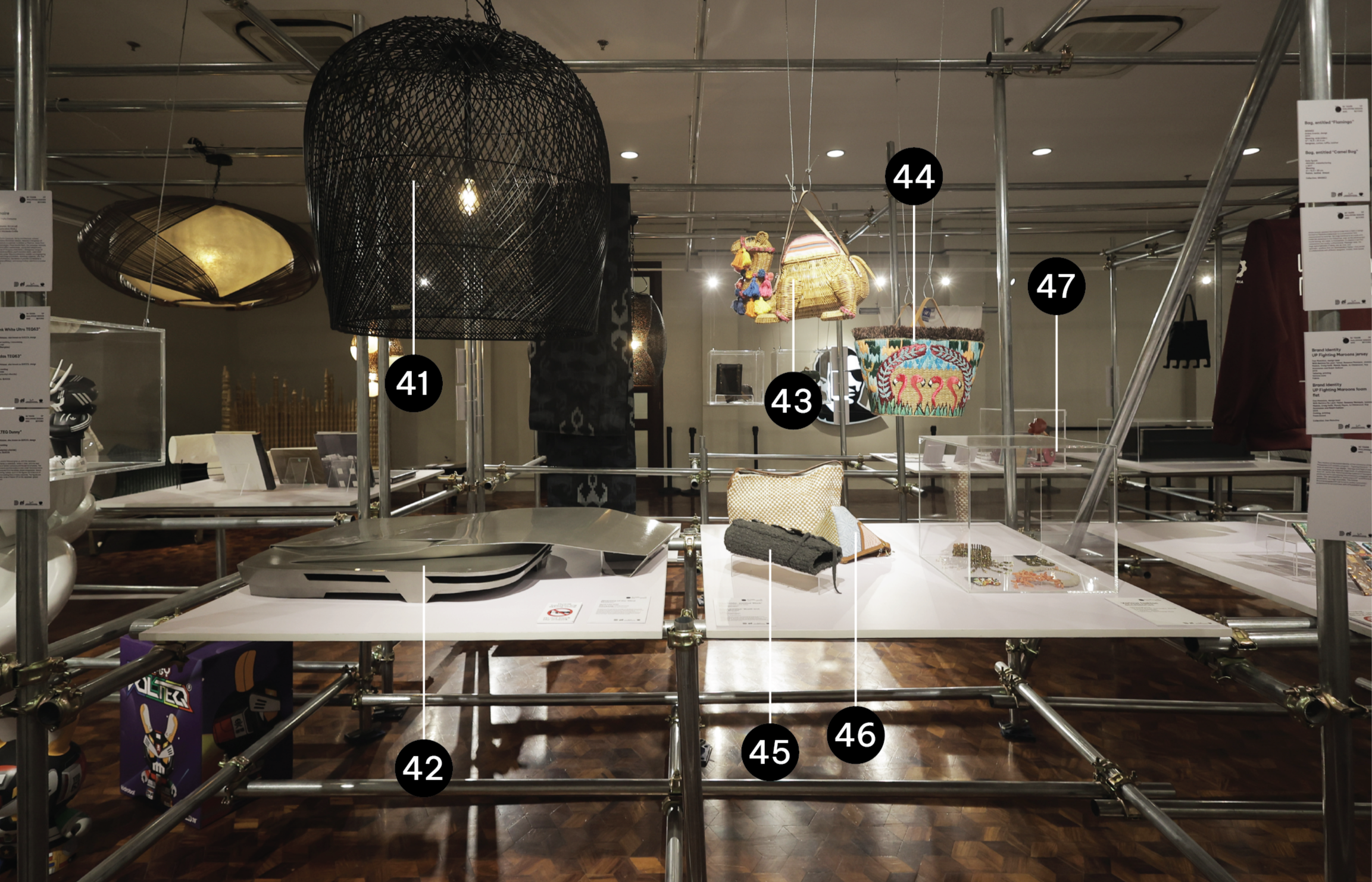
41
Luminaire
Hacienda Crafts Company
2018
Weaving
79 cm, diameter; 92 cm tall
Burî (Corypha elata Roxb.)
Collection: Hacienda CraftsHacienda Crafts Company, led by architecture-trained designer Cristina Borromeo Gaston, reworks a full gamut of organic materials ancestrally available to Filipinos. Aside from the ubiquitous abaká (Musa textilis Neé), the company variously works burî and raffia (respectively, young leaf sheaths and mature leaves of Corypha elata Roxb.), baragubay (twigs of coconut, Cocos nucifera), payâ (coconut shell), capiz shell (windowpane oyster Placuna placenta), sukdáp and kagingkíng (split trunk and twigs of bamboo, Bambusa vulgaris), nito vine (Lygodium circinatum), the leaves of pandán (screwpine or Pandanus amaryllifolius), and arurog (rattan vine from a number of varieties).
42
Maquette of the “Mind Museum”
Lor Calma and Partners
Eduardo Calma, design
2011
Sculpting, folding, cutting (diorama)
Various materials
Collection: Lor Calma and PartnersEd Calma is the one Filipino architect of his generation whose architectural vocabulary is instantly recognizable. Living and working firmly within the ethos of International Style, Calma has remained consistent in expressing—almost entirely in architectural form, and neither in text nor verbal assertion—a version of the Filipino as cosmopolitan. This Filipino is comfortable with the sculptural/visual articulations creating the world today as an adept participant in identity building where the inter- and intra-national are unified.
43
Bag, entitled “Camel Bag”
Kate Spade
ARANÁZ, manufacturing
c 2017
Weaving
21 × 16.5 × 38 cm
Rattan, leather, thread
Collection: ARANÁZAmina Aranáz updated the tropical totes from a field of design hitched to Filipiniana stereotype to a universalized field characterized by surprise. Her bags continue to be made with materials ubiquitous to the Philippines, even as the patterns and motifs belong, as it were, to Everywhere. On display is spirited composition and quality craftsmanship. Message-wise, the bags signal lightness of being, joie de vivre, and optimism—qualities that are demonstrably Filipino—that persist in collaborations with different designers, notably, Kate Spade.
44
Bag, entitled “Flamingo”
ARANÁZ
Amina Aranáz, design
2013
Weaving, embroidery
47 × 16.5 × 25.5 cm
Seagrass, cotton, raffia, leather
Collection: ARANÁZAmina Aranáz updated the tropical totes from a field of design hitched to Filipiniana stereotype to a universalized field characterized by surprise. Her bags continue to be made with materials ubiquitous to the Philippines, even as the patterns and motifs belong, as it were, to Everywhere. On display is spirited composition and quality craftsmanship. Message-wise, the bags signal lightness of being, joie de vivre, and optimism—qualities that are demonstrably Filipino—that persist in collaborations with different designers, notably, Kate Spade.
45
Wine holders, entitled “Mark”
Rags2Riches and Rajo Laurel, design
2007
Weaving (basketweave)
Recycled cotton fabricRags2Riches, formulated as social enterprise by its founder, Reese Fernandez, works with women of urban poor communities to upcycle a range of otherwise castaway cloths and packaging. The popularity of their bags and other accessories—following the success of the pioneering KILUS Foundation—clinched mainstream esteem for social enterprise itself whose time had come.
46
Bags, entitled “Buslô and Pusô Blocks”
Rags2Riches, design
c. 2010s
Weaving (basketweave)
Recycled cotton fabric
Collection: Rags2RichesRags2Riches, formulated as social enterprise by its founder, Reese Fernandez, works with women of urban poor communities to upcycle a range of otherwise castaway cloths and packaging. The popularity of their bags and other accessories—following the success of the pioneering KILUS Foundation—clinched mainstream esteem for social enterprise itself whose time had come.
47
Various fashion accessories
ZAI Design Hive
Gil Zaire “Butch” Carungay, design
Various materials
c. 2000s - 2010s
Collection: ZAI Design HiverThe combined efforts led by fashion components manufacturers in Cebu have catalyzed an industry of fashion accessories design. Gil Zaire “Butch” Carungay is recognized as one of the innovators in this field, known for his intricate and contemporary creations. The emphasis on material manipulation and design innovation has positioned Cebu-made fashion accessories as lucrative export products.
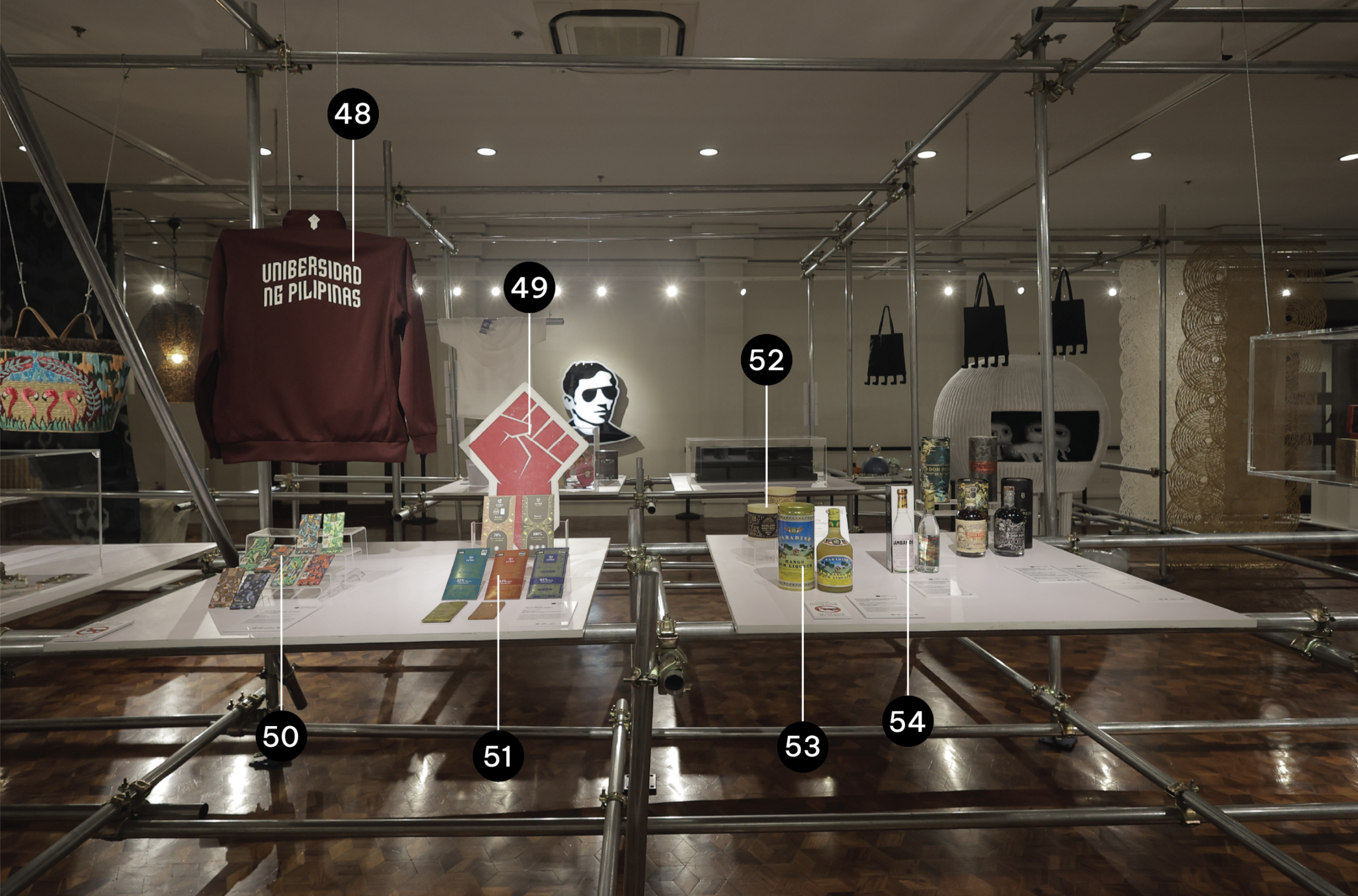
48
Brand Identity
UP Fighting Maroons jersey
Dan Matutina, design lead
With Bernice De Leon-Yumul, Raxenne Maniquiz, Joanna Malinis, Craig Halili, Mandy Reyes, AJ Dimarucot, Kay Aranzanso and Ralph Guibani
2015
Tailoring, printing
Various sizes
Fabric
Collection: Dan MatutinaThe creation of the brand identity of the University of the Philippines (UP) athletic program – Fighting Maroons – is more than an exercise in logo design. The logo and field of maroon was created by an unusually large team of collaborators, all from UP, led by Dan Matutina during a period of resurgence of pride and will to win among the university’s collegiate varsity teams. The clenched fist is “particularly UP” notwithstanding its universality as a sign of protest. The intense #nowheretogobutUP call to win is widely (and wildy) understood as synonymous with UP’s palabán spirit.
49
Brand Identity
UP Fighting Maroons foam fist
Dan Matutina, design lead
With Bernice De Leon-Yumul, Raxenne Maniquiz, Joanna Malinis, Craig Halili, Mandy Reyes, AJ Dimarucot, Kay Aranzanso and Ralph Guibani
2015
Cutting, printing
Foam board
Collection: Dan MatutinaThe creation of the brand identity of the University of the Philippines (UP) athletic program – Fighting Maroons – is more than an exercise in logo design. The logo and field of maroon was created by an unusually large team of collaborators, all from UP, led by Dan Matutina during a period of resurgence of pride and will to win among the university’s collegiate varsity teams. The clenched fist is “particularly UP” notwithstanding its universality as a sign of protest. The intense #nowheretogobutUP call to win is widely (and wildy) understood as synonymous with UP’s palabán spirit.
50
Packaging
“Theo and Philo Artisan Chocolates”
Dan Matutina, Raxenne Maniquiz, Craig Halili, design
2017
Full color offset printing, packaging
Paper, printers’ ink
Collection: Theo and Philo Artisan ChocolatesThe emergence of high-end Philippine artisanal chocolate production—with the recognition, on one hand of special cacao (Theobroma cacao) stock in Mindanao, and on the other, of the pivotal role of technical expertise as chocolatiers—came to wide recognition of pioneers. Theo and Philo is among these very few pioneers. Importantly, the refined tastes the chocolate formulation met by this brand is preceded by sophisticated packaging design. Packaging was also pioneering.
51
Packaging
“Auro Chocolate”
Mark Ocampo, design
2015
Printing, packaging
9.5 x 19 x 0.8 cm
Food-grade foil, compostable metalized paper
From Auro ChocolatePackaging designer Mark Ocampo is also co-founder of Auro Chocolate, with Kelly Go, with whom he shares a history of having been educated in Chicago. Both decided to reincarnate themselves as Philippines-based chocolatiers, building their premium brand on old-growth cacao (Theobroma cacao) and a highly involved tree-to-bar value chain. Auro is institutionally involved in the welfare of the farmers in its single-growth plantation, and to principles of sustainability well beyond lip service. The packaging of Auro Chocolate conveys the owners’ commitment to refinement.
52
Packaging
“Heirloom Unoy Rice”
Lemuel Abron, design
2019
B X W offset printing on board
10 cm, diameter; 10 cm tall
Paper (kraft board), printers’ ink, box
Collection: Design Center of the PhilippinesChong-ak, a rice variety that continues to be grown in Kalinga, a province of the Northern Luzon Cordilleras, is among a range of heirloom varieties being sustained and marketed to ensure their survival. Support is assured by the Department of Agriculture and the International Rice Research Institute. Chong-ak is also called unoy and is marketed under this name by the initiative Ark of Taste. Designer Lemuel Abron incorporated Kalinga imagery in the round box.
53
Bottle label and packaging
“Paradise Mango Rum Liqueur”
Company design by unnamed British designer
Destileria Limtuaco & Company
2002
Glasswork, full color offset printing, paper, adhesive
9.5 diameter × 22 tall
Glass, paper, metal
Collection: Destileria Limtuaco & Co.Paradise Mango Rum Liqueur, produced by the Philippines’ oldest distillery, Destileria Limtuaco, was instrumental to the company’s successful transition to the 21st century. Firstly, mango was chosen to deliberately draw attention to the Philippines as the source of good stuff—during a time that still trailed from centuries of putting down Philippine products. Secondly, a British designer was engaged to distill, so to speak, a foreigner’s appreciative view of the Philippines. The strategy proved remarkably effective.
54
Bottle label and packaging
“Philippine Lambanog (distilled coconut palm spirit)”
Olive Enriquez, design
2002
Full color and b x w offset printing on paper
10 cm, diameter; 23.5 cm, tall
Paper, printers’ ink, adhesive, glass
Collection: Capistrano DistilleryOlive Enriquez built the Packaging Department of Design Center of the Philippines. Her own work and personal aesthetic are exhibited in the highly articulate simplicity of the label on the Philippine Lambanog brand: clean graphics in black and white, and a color artwork to be seen through the bottle of clear liquid, at the back of the label. Lambanóg, the Philippine distilled spirit from coconut sap, is acknowledged as a product of highest quality by virtue of full clarity of liquid. This refined tuba hence obliges the designer to draw attention to this clarity. Enriquez did so, and showed how packaging design is necessarily conceptually driven.
Page 5 of 8
A project of

In partnership with

2001 - 2023
Gallery 26
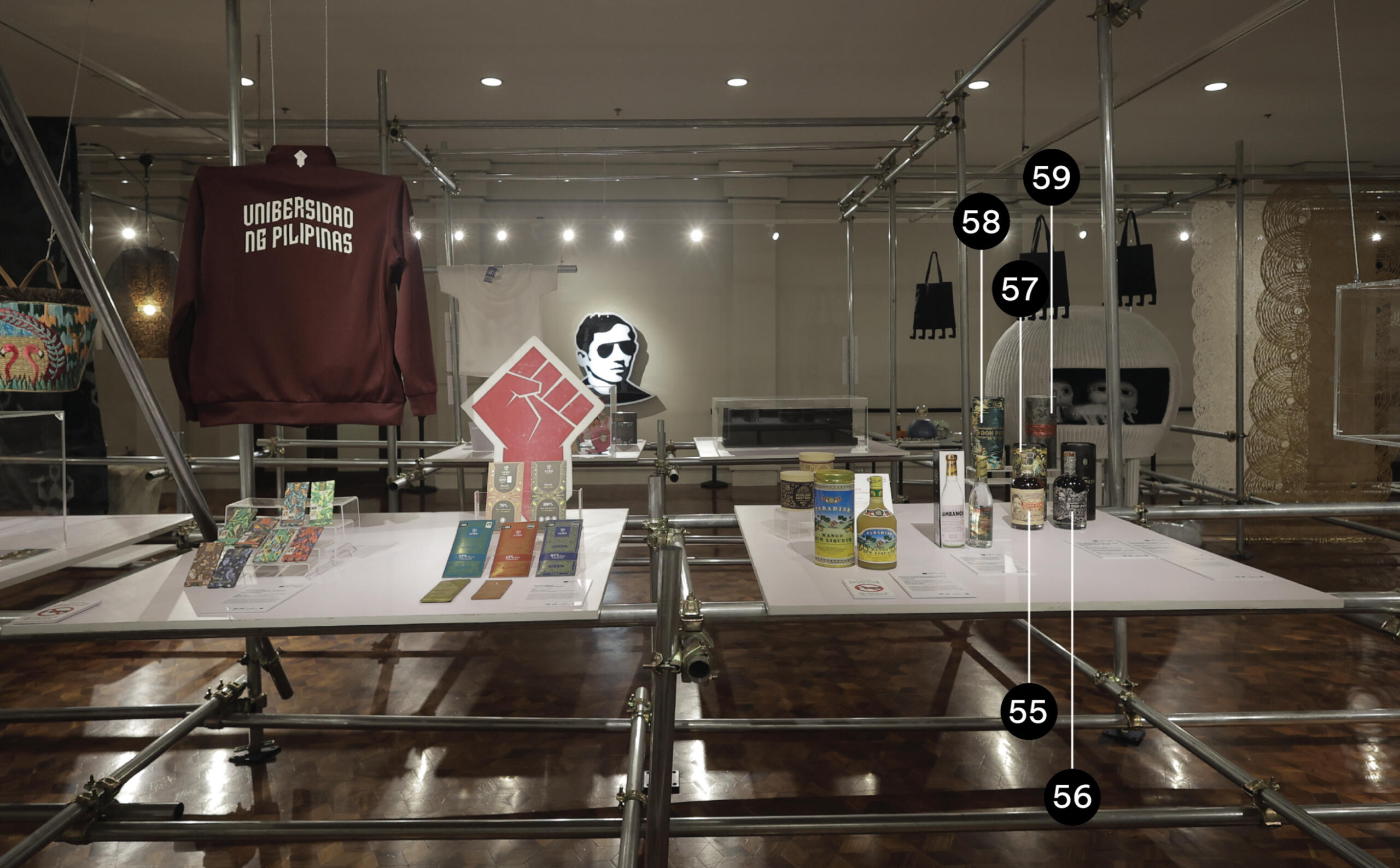
55
Packaging and label
Don Papa Rum
Stranger & Stranger, design
2012
Glasswork, full color offset printing, packaging
10 × 10 × 23.5 cm (canister)
9.4 × 9.4 × 22.5 cm (bottle)
Glass, metal, wood (cork), paper
Collection: Bleeding Heart Rum CompanyDon Papa Rum was named after a millenarian rebel in Negros Island, known to history as Papa Isio, who lived in the turn to the 20th C. This “rebellious” naming was essential to the brand strategy of Diageo Iberia, a Spanish company producing and distributing more than 90 premium liquors and spirits. Moreover, the packaging design for its vintages was a strategic choice, as well, involving competitions staged regularly. The edition of Stranger & Stranger assembles motifs from a foreign imaginary of the tropics. Other designers drew from inside-looking-out concepts.
56
Packaging and label
Don Papa 10YO
Stranger & Stranger, design
2014
Glasswork, full color offset printing, packaging
10 × 10 × 23.5 cm (canister)
9.4 × 9.4 × 22.5 cm (bottle)
Glass, metal, wood (cork), paper, adhesive
Collection: Bleeding Heart Rum CompanyDon Papa Rum was named after a millenarian rebel in Negros Island, known to history as Papa Isio, who lived in the turn to the 20th C. This “rebellious” naming was essential to the brand strategy of Diageo Iberia, a Spanish company producing and distributing more than 90 premium liquors and spirits. Moreover, the packaging design for its vintages was a strategic choice, as well, involving competitions staged regularly. The edition of Stranger & Stranger assembles motifs from a foreign imaginary of the tropics. Other designers drew from inside-looking-out concepts.
57
Packaging and label
Don Papa “Flora Fauna” canister
Joseph M. Ingking, design
2020
Full color offset printing, packaging
10 x 10 x 23.5 cm
Paper, printers’ ink
Collection: Bleeding Heart Rum CompanyDon Papa Rum was named after a millenarian rebel in Negros Island, known to history as Papa Isio, who lived in the turn to the 20th C. This “rebellious” naming was essential to the brand strategy of Diageo Iberia, a Spanish company producing and distributing more than 90 premium liquors and spirits. Moreover, the packaging design for its vintages was a strategic choice, as well, involving competitions staged regularly. The edition of Stranger & Stranger assembles motifs from a foreign imaginary of the tropics. Other designers drew from inside-looking-out concepts.
58
Packaging and Label
Don Papa “Cosmic” canister
2019
Full color offset printing, packaging
10 x 10 x 23.5 cm
Paper, printers’ ink
Collection: Bleeding Heart Rum CompanyDon Papa Rum was named after a millenarian rebel in Negros Island, known to history as Papa Isio, who lived in the turn to the 20th C. This “rebellious” naming was essential to the brand strategy of Diageo Iberia, a Spanish company producing and distributing more than 90 premium liquors and spirits. Moreover, the packaging design for its vintages was a strategic choice, as well, involving competitions staged regularly. The edition of Stranger & Stranger assembles motifs from a foreign imaginary of the tropics. Other designers drew from inside-looking-out concepts.
59
Packaging and label
Don Papa “Botany” canister
Sam Penaso, design
2019
Glasswork, full color offset printing, packaging
10 × 10 × 23.5 cm
Paper and printers’ ink, adhesive
Collection: Bleeding Heart Rum CompanyDon Papa Rum was named after a millenarian rebel in Negros Island, known to history as Papa Isio, who lived in the turn to the 20th C. This “rebellious” naming was essential to the brand strategy of Diageo Iberia, a Spanish company producing and distributing more than 90 premium liquors and spirits. Moreover, the packaging design for its vintages was a strategic choice, as well, involving competitions staged regularly. The edition of Stranger & Stranger assembles motifs from a foreign imaginary of the tropics. Other designers drew from inside-looking-out concepts.
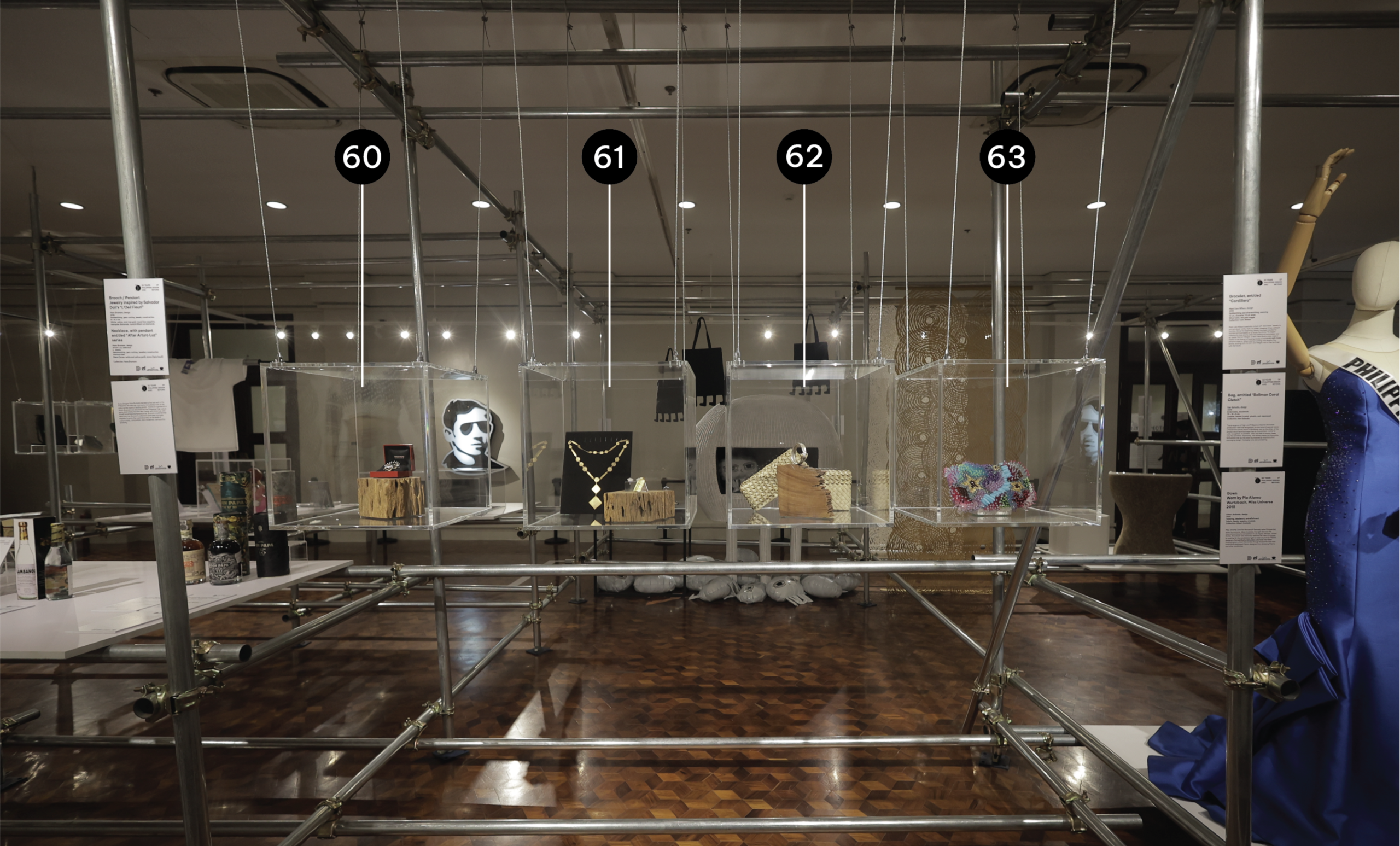
60
Brooch / Pendant
Jewelry inspired by Salvador Dali’s “L’Oeil Fleuri”
Hans Brumann, design
2016
Goldsmithing, gem-cutting, jewelry construction
4 × 4.5 cm
White, yellow, and rose gold; round blue sapphire,
marquise diamonds, round brilliant cut diamonds
Collection: Hans BrumannSwiss designer Hans Brumann decided to live and work in the Philippines decades ago, and nearly immediately took on the status as the country’s leading jeweler. Trained as a goldsmith in Zurich, Brumann was absorbed into the Philippines’ high culture scene, and notably became dear friends with Arturo Luz, who himself would become National Artist. Brumann would develop ideas from Luz. Brumann’s collections have been invariably exquisite (a word often used about him) on the levels of craftsmanship, composition, and a modernist, cosmopolitan sensibility.
61
Necklace with pendant entitled “After Arturo Luz” series
Hans Brumann, design
Arturo Luz, direction
c. 2000s
Metalworking, gem-cutting, jewellery construction
Various sizes
Metal (brass, white and yellow gold), stone (lapis lazuli)
Collection: Hans BrumannSwiss designer Hans Brumann decided to live and work in the Philippines decades ago, and nearly immediately took on the status as the country’s leading jeweler. Trained as a goldsmith in Zurich, Brumann was absorbed into the Philippines’ high culture scene, and notably became dear friends with Arturo Luz, who himself would become National Artist. Brumann would develop ideas from Luz. Brumann’s collections have been invariably exquisite (a word often used about him) on the levels of craftsmanship, composition, and a modernist, cosmopolitan sensibility.
62
Bracelet, entitled “Cordillera”
Mark Caro Wilson, design
2018
Goldsmithing and silversmithing, weaving
10 cm, diameter; 10 cm wide
Silver band, red gold toggle
Collection: Caro WilsonMark Caro Wilson’s aesthetic is best self-described: “Jewelry is not just about vanity, style, or power-dressing. It has a deeper function. Since the beginning, jewelry has been created to express spiritual beliefs or to evoke the divine.” He began creating his lines shortly after the passing of connoisseur and art dealer Ramon Villegas, a dear friend and in many ways a mentor in the fine art of looking closely at extremely well-made personal objects. Wilson started working with Baguio City smiths, evoking both his own and Villegas’ will to fuse heritage with the future.
63
Bag, entitled “Bollman Coral Clutch”
Ken Samudio, design
2015
Embroidery, beadwork
13 × 18 × 5 cm
Leather, beads (crystal, plastic, and Japanese)
Collection: Ken SamudioBiologist Ken Samudio, raised with an abiding fascination of the sea and its denizens, reinvented himself as a designer of bags and accessories that draw from an imagination infused with, precisely, maritime impressions. He works with beadwork in an urchin or anemone like way. His palette evokes the shimmers and arresting color changes of water environments. Samudio hence cites the Philippines in the entirely fresh way of a designer as reflecting surface, given to flow.
Page 6 of 8
A project of

In partnership with

2001 - 2023
Gallery 26
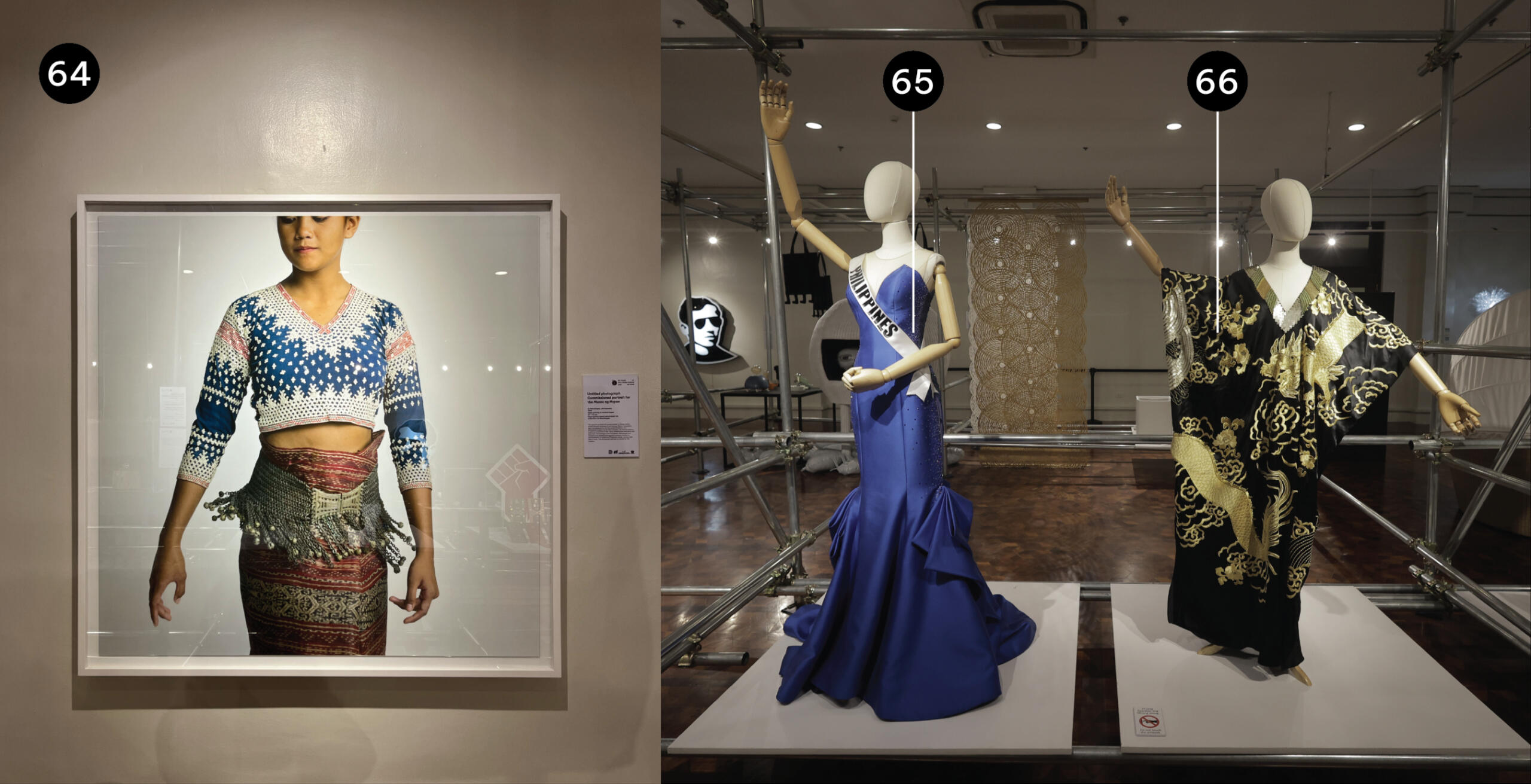
64
Untitled photograph
Commissioned portrait for the Museo ng Nayon
At Maculangan, photography
2014
Inkjet printing on archival paper
117 × 117 cm
Paper (photo luster) and printers’ ink
Collection: At MaculanganThis dynamic portrait of a young woman, a dancer with a troupe formerly attached to the Nayong Pilipino Foundation, was commissioned for the Permanent Exhibition of a refurbished museum at the Clark location. The dancer wears a traditional ensemble of rare, highly refined Blaan beadwork and warp ikat, that belongs to the foundation. Maculangan is a virtuoso of an updated photographic practice trained on representations of traditional Philippine culture, among other lines of work. This photograph belongs to a series for the museum.
65
Gown
Worn by Pia Alonso Wurtzbach, Miss Universe 2015
Albert Andrada, design
2015
Tailoring, beadwork, embellishment
Fabric, beads, sequins, crystals
Collection: Albert AndradaMiss Universe 2015 Pia Wurtzbach famously wore this evening gown by couturier Albert Andrada, the night she won the international beauty competition in Las Vegas, Nevada, United States. Wurtzbach also famously asserted her idea of change by pushing for the candidate’s right to wear couture by Filipino designers. Succeeding by persuasion, she wore the Albert Andrada gown, which then broke through the barrier that had heretofore disallowed Filipino designers from dressing Filipino and other candidates.
66
Caftan, entitled “Couture Embroidered Dragon”
Josie Natori, design
2017
Weaving, embroidery, tailoring
Silk (Bombyx mori)
Collection: Josie NatoriJosie Cruz Natori was a financial analyst working in New York City when she pivoted to design and manufacture of clothing lines under the brand Natori. She focused on lounge wear, staging the skills of Filipino embroiderers. Immediately a globally important brand, Natori’s impact on notions of luxury, based on exquisite detailing on exquisite fabric, was to prove enduring.
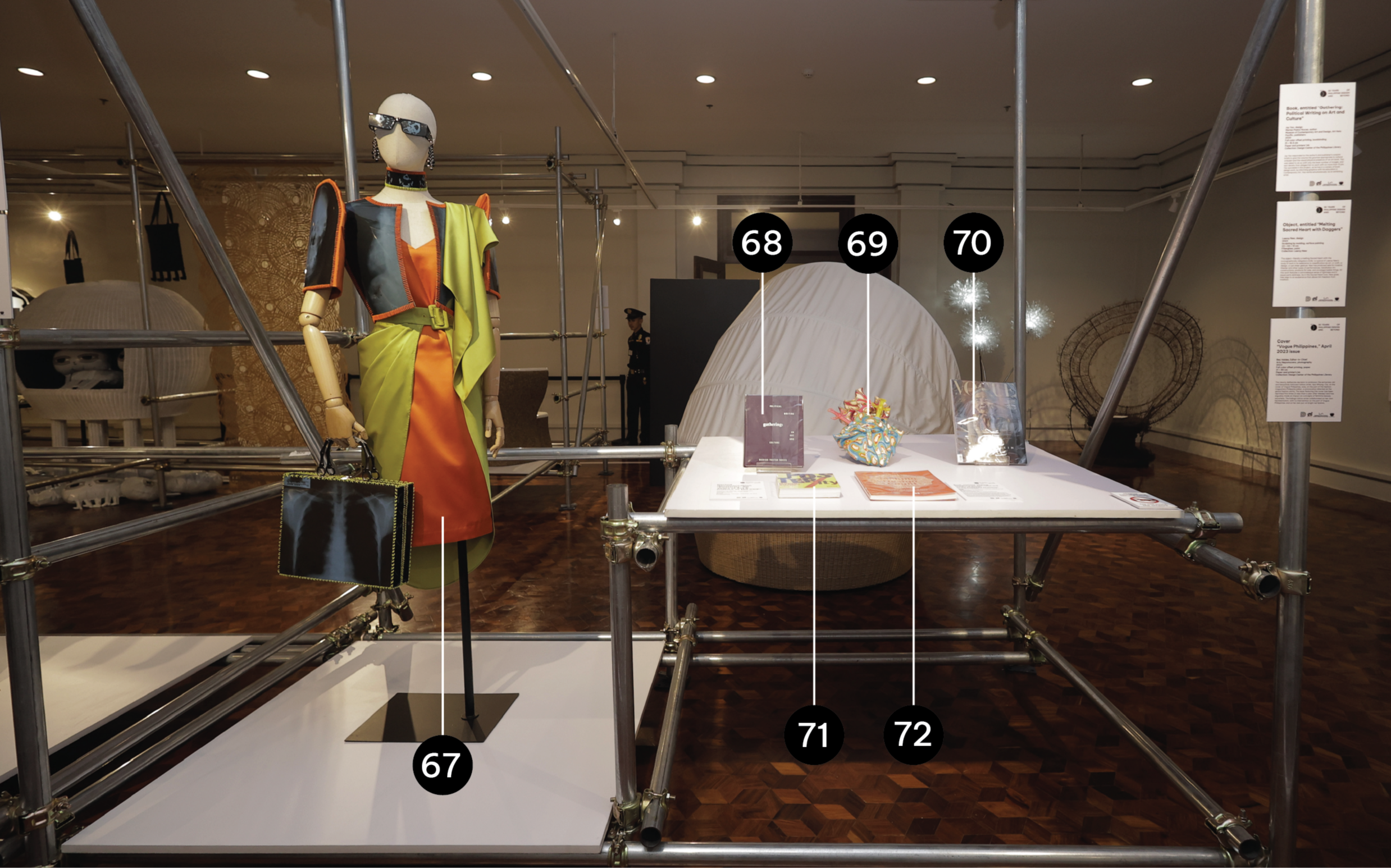
67
Innovation on the Philippine
Terno, Balintawak
Glyn Alley Magtibay, design
Chito Vijandre and Ricky Toledo, mentorship
Presented at TernoCon
2023
Collection: Cultural Center of the PhilippinesIn lieu of the transparent cañamazo textile of the traditional terno, Glyn Alley Magtibay used translucent x-ray sheets to craft the Balintawak’s butterfly sleeves, and other accessories. This innovation on the Philippine terno was presented at the 2023 edition of TernoCon, an event initiated by the Cultural Center of the Philippine and Bench. TernoCon has been providing a platform for emerging designers to demonstrate their talents in creating functional garments inspired by the Filipino traditional wear since 2018.
68
Book, entitled “Gathering: Political Writing on Art and Culture”
Jay Yao, design
Marian Pastor Roces, author
Museum of Contemporary Art and Design, Art Asia Pacific, publishers
2020
Full color offset printing, bookbinding
21 × 16.5 cm
Paper and printers’ ink
Collection: Design Center of the PhilippinesJay Yao responded to the author’s and publisher’s conjoint briefs to give the volume the gravitas appropriate to cultural criticism and the visual/physical presence of an art book. Yao was asked to do so with only the least number of images, and text density that obliged him to work with no more than 10 pts. Yao succeeds in this project, as he has in a variety of book design work, by informing graphics with his education in Contemporary Art. Yao works simultaneously as an exhibiting artist.
69
Object, entitled “Melting Sacred Heart with Daggers”
Leeroy New, design
2023
Sculpting by molding, surface painting
23 × 43 × 10 cm
Fiberglass, paint
Collection: Leeroy NewThe object—literally a melting Sacred Heart with the iconographically obligatory knife—is typical of Leeroy New’s body of work in its resistance to classification as art, or craft, or design, or just sheer gesture. New has produced sets for musical theater and other types of performances, Installation Art constructions, products for sale, and uncategorizable things. All this work features a carnivalesque sense of lightness and in equal parts darkness. As in this Sacred Heart icon, New gives free reign to an exuberance that allows him freedom from tradition.
70
Cover
“Vogue Philippines,” April 2023 issue
Bea Valdes, Editor-in-Chief
Artu Nepomuceno, photography
2023
Full color offset printing, paper
21 × 30 cm
Paper and printer’s ink
Collection: Design Center of the PhilippinesThe clearly deliberate decision to emblazon the extremely old and beautifully tattooed tattoo artist, Apo Whang-Od, on the cover of Vogue Philippines, was, on the part of the fashion magazine’s Philippine editor, a provocation directed at the global fashion world. The issue featuring this cover has been reprinted five times (in less than a year after release) and has arguably made an impact on concepts of feminine beauty anywhere. The Kalinga tattoo artist collaborated on her own representation, with no intervention on the part of Vogue Philippines; and on her own put on bright red lipstick.
71
Period documentation
“Posterity: 50 Years of Art &
Culture at the CCP”
Asuncion “Baby” and Damien “Coco” Anne, design and
art direction
2019
Collection: Design Center of the PhilippinesThe book "Posterity: 50 Years of Art & Culture at the CCP" explores the artistic progression of the Cultural Center of the Philippines spanning five decades. Through a blend of visuals, essays, and narratives, it provides a deep insight into the CCP's role as a hub for creativity and cultural expression in the Philippines. Emphasizing the center's significant influence on the country's cultural landscape, it showcases a diverse array of talents and key events that have contributed to its enduring legacy.
72
Book, entitled “Making Design Count: The value and impact of design
on the Philippine economy”
Policy brief and full report
Design Center of the Philippines, writing, publishing and design
2023
Offset printing, bookbinding
21 × 29.7 cm
Paper and printer’s ink
Collection: Design Center of the Philippines‘Making Design Count’ is the Philippines’ first design economy mapping and design policy formulation study. Led by the Design Center of the Philippines in partnership with the British Council, Nordicity, Bayan Academy, PDR Cardiff Metropolitan University, And A Half Design Studio, and Pushpin Visual Solutions, the report mapped and analyzed the strategic use of design in the Philippines to inform targeted policy actions that will strategically enhance the Philippine design landscape. It ultimately laid the groundwork for the development of the Philippines’ first National Design Policy, as mandated by the Philippine Design Competitiveness Act of 2013.
Page 7 of 8
A project of

In partnership with

2001 - 2023
Gallery 26
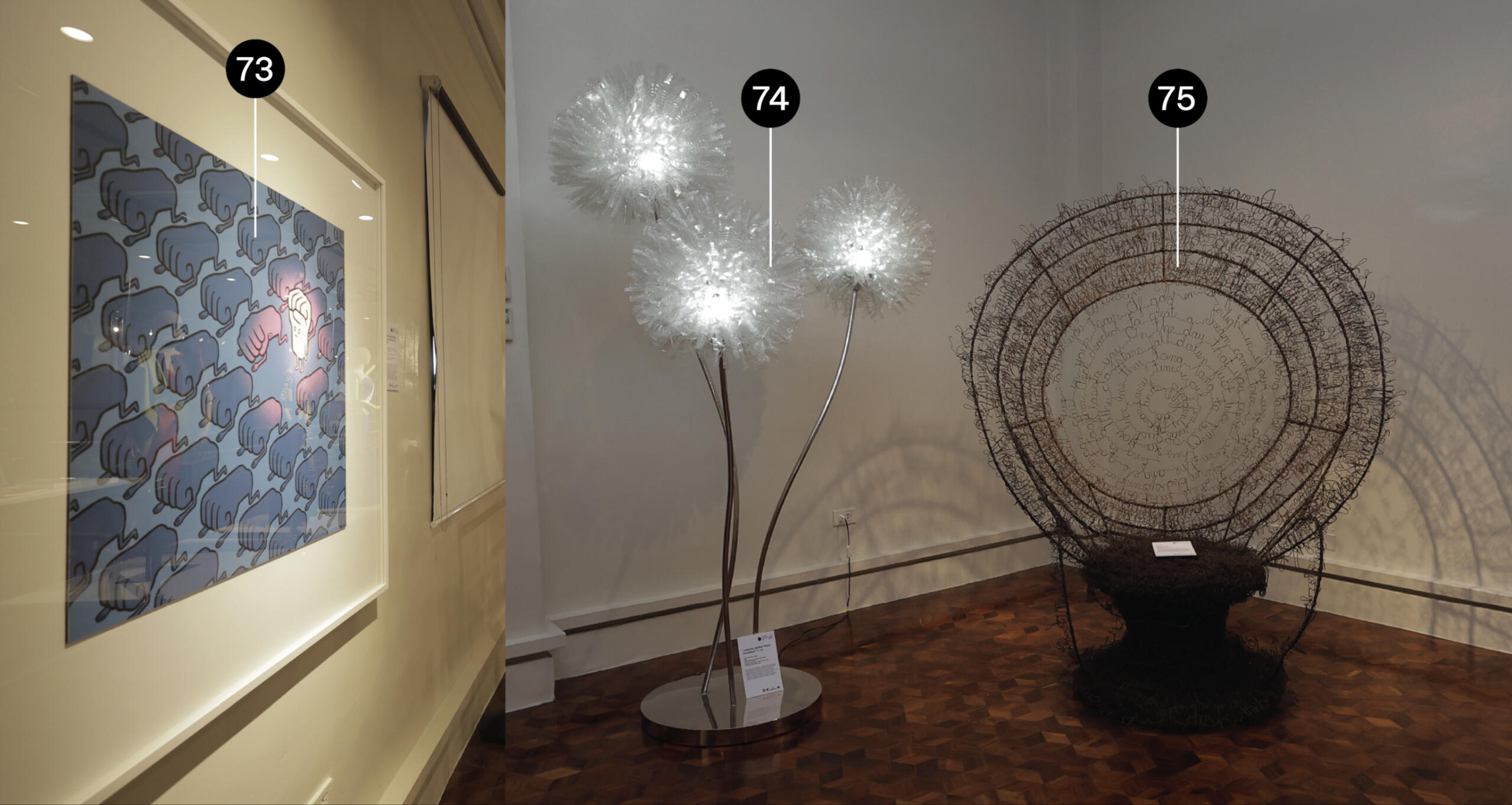
73
Printed poster-like sheet, entitled and named after “Tumindíg”
Featuring the character Tumindíg in context
Kevin Eric Raymundo, also known as Tarantadong Kalbo, invention and illustration
2021
Illustration, inkjet printing on archival paper
117 × 117 cm
Paper (Photo Rag Bright White) and printer’s ink
Collection: Tarantadong KalboKevin Eric Raymundo, cartoonist, based a frustrated Filipino character on himself, during the unhappy political season. His alter-ego, Tarántadong Kalbó (Badass Bald One) is a contrary but vulnerable cartoon figure published by Komiket. Tarantadong Kalbo uploaded a post, on July 17, 2021, with a graphic showing people as clenched fists bowing to an unseen power, except for one white figure standing. The graphic is entitled “Tumindíg!” (Stand!) It promptly became viral, connecting with widespread disaffection. The social critique-as-graphic was recognized with a Good Design Award for the Philippines and conferred the G Mark, a widely-recognized seal of design excellence in Japan.
74
Luminaire, entitled “Giant Dandelions” V. 2.0
Olivia d’Aboville, design
2023
Metal welding and plastic manipulation
100 × 100 × 220 cm
Stainless steel, plastic water bottles, LEDs
Collection: Olivia d’AbovilleGrowing up in a French-Filipino family residing on the island of Mindoro, Olivia d’Aboville developed an imagination suffused with impressions of the sea. Her attraction to qualities of transparency and flow draws from her childhood. After art education in the Philippines and France, focused on textiles, she got into the groove of upcycling throw-away materials; particularly, plastics. Her “Giant Dandelions” summarize a life, thus far, possessed of a spirit of re-naturing the unnatural.
75
Chair
Tony Gonzales, design
2016
Metal manipulation
150 × 150 × 180 cm
Metal wire
Collection: Tony GonzalesThe “peacock chair”—the stool-like furniture piece that elaborates the backrest into an overlarge circular, and indeed, crown form made entirely of metal wire—is rendered by Movement 8’s Tony Gonzales as a tongue-in-cheek nostalgia piece. He literally inscribes nostalgia into the peacock chair form, specifically with the Burt Bacharach and Hal David song “Close to You.” The ballad made famous by The Carpenters of 1970s fame references the mid-20th C, during which the prewar chair form returned to Western imagination through such “sightings” as in a Black Panther Huey Newton portrait.
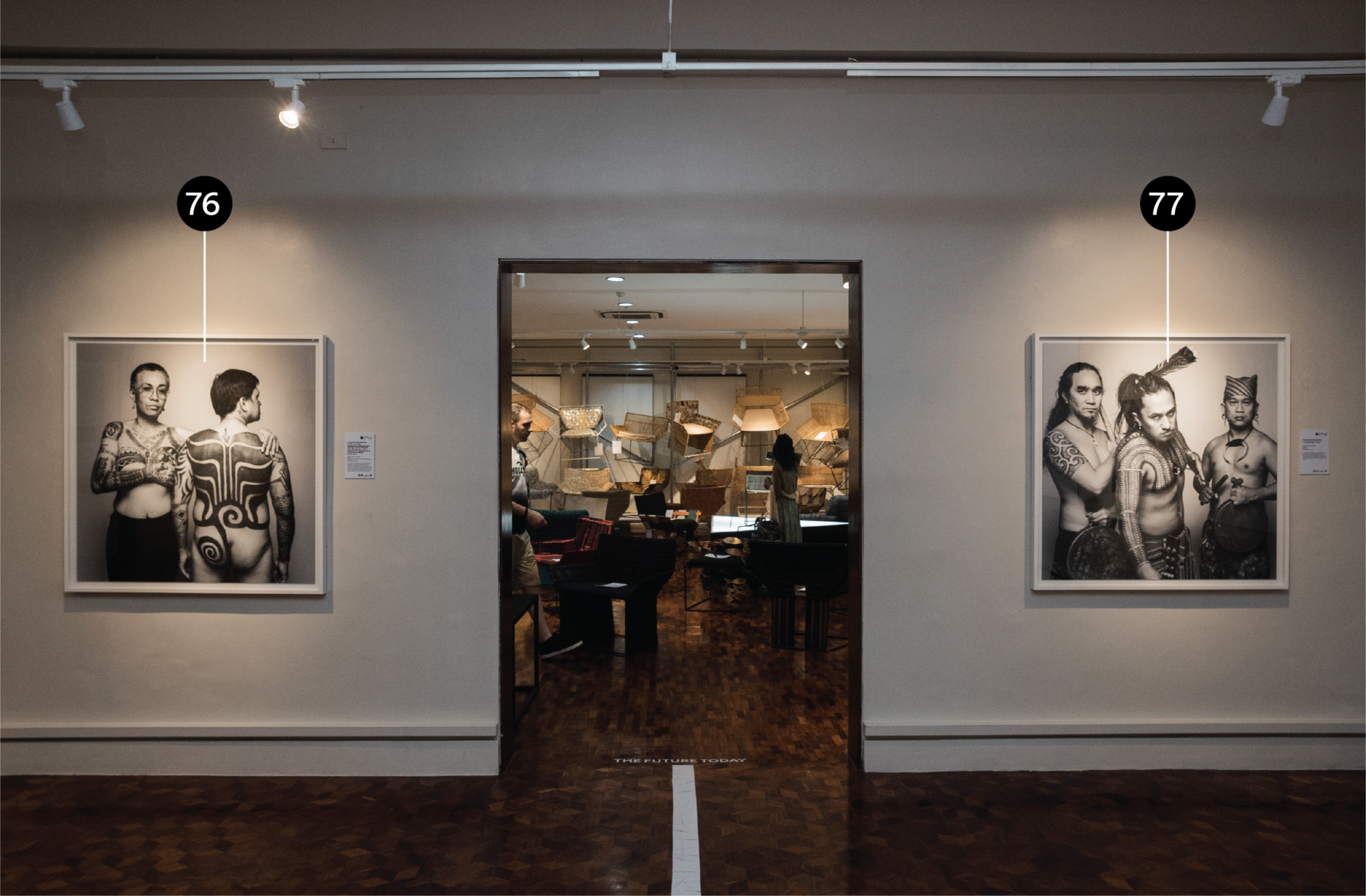
76
Tattooed embodiment
Dr. Ma. Lourdes Veneracion-Rallonza and Michael Albert Rallonza
Apo Whang-Od, tattoo artist for Dr. Veneracion and Mr. Rallonza, in traditional Kalinga patterning
With various artists
At Maculangan, photography
2023
Tattooing by Apo Whang-Od, executed decades ago
117 × 117 cm
Organic pigment on skin
Collection: Design Center of the PhilippinesThe 50 years of design explorations that sought entrée into global circuits while repetitively citing sources in traditional Philippine art, may be seen to culminate in the literal embodiment of both aspirational streams. Tattooing became mainstream in the Philippines, and the upwardly mobile middle class took it up with gusto. Political scientist. Dr. Maria Lourdes Veneracion Rallonza and her husband, bank officer, Michael Albert Rallonza began their married life decades ago by having themselves remade as contemporary markado or tatuhán.
77
Tattooed embodiment
The Kadangyan Band
Various artists
At Maculangan, photographer
2023
Tattooing
117 × 117 cm
Organic pigment on skin
Collection: Design Center of the PhilippinesThe rock band Kadangyán metamorphoses traditional sound patterns from Philippine indigenous musical instruments into rock. They similarly metamorphose traditional tattoo patterning (Cordillera in this case) into skin-level identity markers, projected into the future. The shift from past to future is, in their case, executed as acts of design.
Page 8 of 8
A project of

In partnership with

THE FUTURE TODAY
The end of 2023 offers a clear view of the immediate future for design by Filipinos. High profile designers are strategizing and realizing the construction of zero-waste systems; shaping their operations within circular economies that they themselves are helping build; and wholly abiding by sustainable development goals. Nearly all the leading designers lead efforts at community empowerment projects, producing both commodities and well-being for various collectives. In all these efforts that are already in place in 2023, Philippine Design emerges as something beyond particular shapes, palettes, techniques—but, rather, as the process and outcome of enhanced collectivities. Philippine Design (is that which) takes
a village.The collection of 2023 innovations on the 1982 chair designed by National Artist Arturo Luz, founding director of the Design Center, presented as notations on the future, display the sheer joy of designing within the Philippine context. It is an environment that seeds creativity with the energy of familial and community networks. It is, furthermore, a national context that has cultivated community organizers and civil society avatars who have worked with designers over the decades to seek to alleviate poverty and transform the social landscape. Indeed, Filipino designers are almost always involved in social transformation initiatives, and it is highly probable that this direction will be maintained well into the future.
The future of Philippine design, from the perspective of today, will from all indications be sustained by this conception of the creative act—to form things and systems for global circulation—as a involved in living circulations that regenerate creativity and life itself.
A project of

In partnership with

The Future Today
Gallery 25
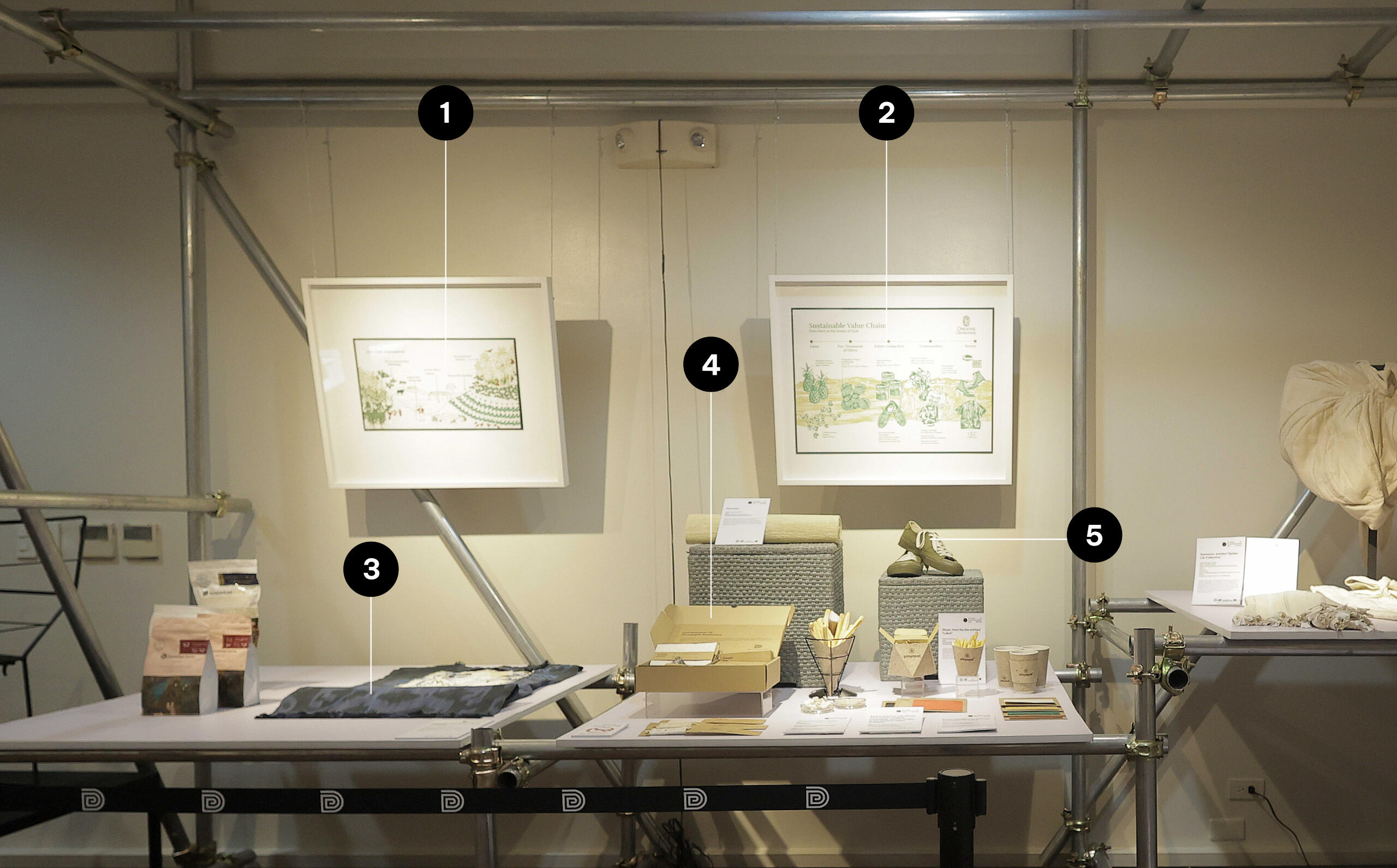
1
Sketch schematic render of system design, Hineleban Coffee within a designed system of relations
John and Renee Perrine with Talaandig and Higaunon traditional communities, system designHineleban Coffee, the product, is only the most visible of a complex system created by John and Renee Perrine and their collaborators among the indigenous communities living near their farm at the foothills of Mt. Kitanglad, Bukidnon and Pantaron Mountain Ranges. The coffee trees are in the care of these Talaandig and Higaunon communities, which therefore also allows for the constant care of the watershed—that in turn assures the water supply of the communities and farmers on the lower slopes and planes below. Sales of the coffee assist these communities—that in turn allows for massive reforestation of the mountain ranges.
2
Sketch schematic render of system design, Creative Definitions
"Lakat" and "Aire," products of Creative Definitions, are the outcomes of a successful sustainable ecosystem involving farmers, weavers, and government agencies. The tropical textiles used for these products are made from locally sourced pineapple leaf fibers and cotton cultivated in Negros. Manufacturing of the raw materials is then carried out by communities from Iloilo, Kabankalan, Bukidnon, and Metro Manila.
3
Handloom Piña Ikat Caftan
Lulu Tan Gan and TADECO, design
2022
Various processes
Pineapple (Ananas comosus) leaf fiber, cotton
Collection: Design Center of the PhilippinesAnother application for fashion use of the material pinyapel®, by Lulu Tan Gan, demonstrates the multi-use, multi-directional possibilities inherent in a newly developed material. The caftan quotes Philippine crafts traditions that used now exhausted fibers and mulches. The sense of optimism in these products is woven in with the sustainability dimension that is fully worked out.
4
Pinyapel® swatch boxes
Design Center of the Philippines, design
2018
Various processes
Various sizes
Various materials
5
Shoes, from the line entitled “Lakat”
Creative Definitions
2022
Various processes
Pineapple (Ananas comosus) leaf fiber, natural rubberAnother application for home use of the new material pinyapél, by Creative Definitions, demonstrates the multi-use, multi-directional possibilities inherent in a newly developed material. The shoes (with natural rubber soles) quote Philippine crafts traditions that used now exhausted fibers and mulches. The sense of optimism in these products is woven in with the sustainability dimension that is fully worked out.
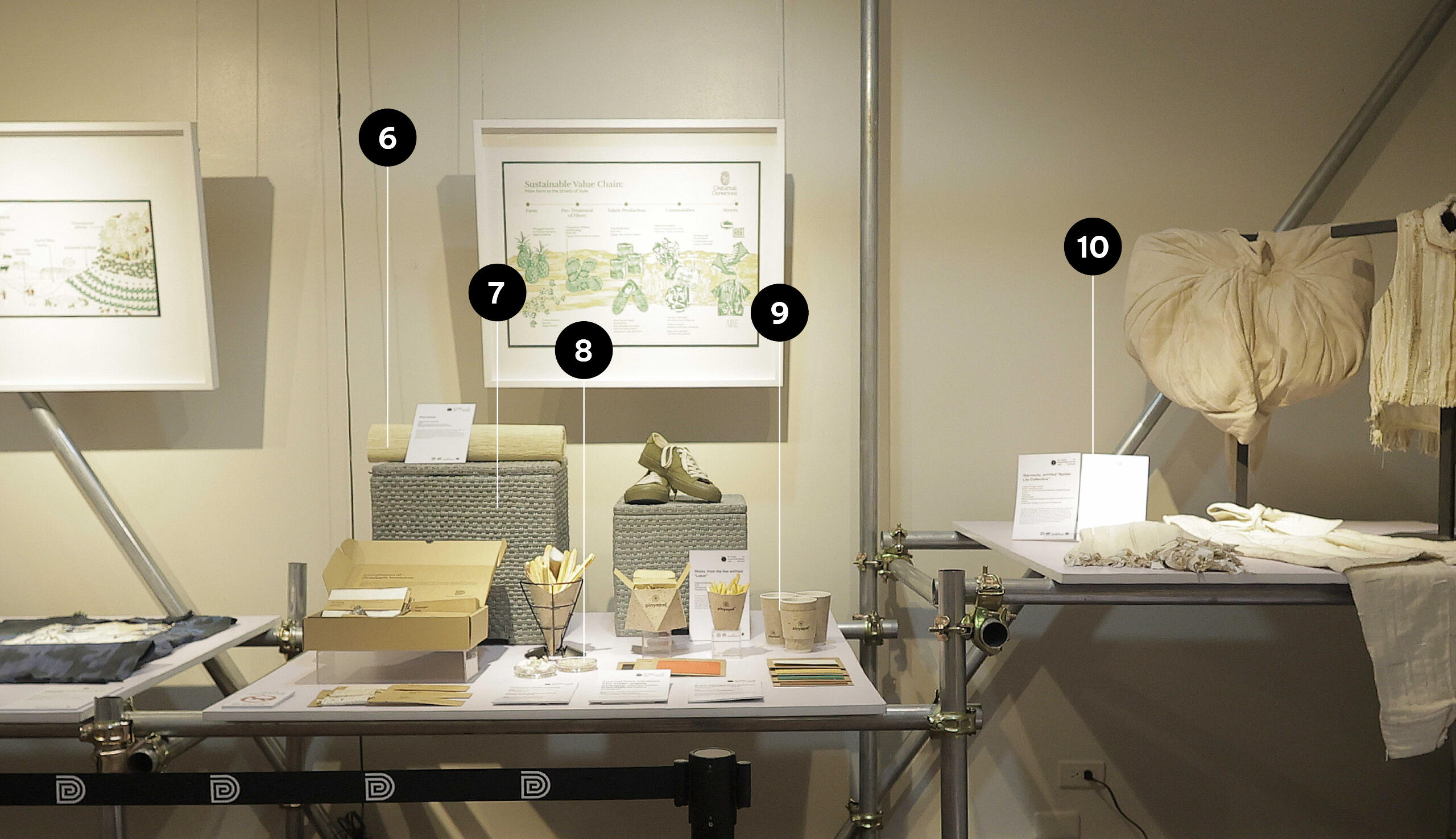
6
"Placemat”
GSG by Flora Creatives
2022
Paper making and paper weaving
Pineapple (Ananas comosus) leaf fiberAnother application for home use of the new material pinyapel®, by GSG by Flora Creatives, demonstrates the multi-use, multi-directional possibilities inherent in a newly developed material. The placemat quotes Philippine crafts traditions that used now exhausted fibers and mulches. The sense of optimism in these products is woven in with the sustainability dimension that is fully worked out.
7
Boxes (designed as nesting), in the material called pinyapel®
TADECO Home, design and manufacturing
2022
Paper making and paper weaving
Pineapple (Ananas comosus) leaves
Collection: Design Center of the PhilippinesAnother application for home use of the material pinyapel® by TADECO Home, demonstrates the multi-use, multi-directional possibilities inherent in a newly developed material. The nested boxes quote Philippine crafts traditions that used now exhausted fibers and mulches. The sense of optimism in these products is woven in with the sustainability dimension that is fully worked out.
8
Pinyapel® pellets [Clear glass, props]
Design Center of the Philippines, design
2018
Compounding, extrusion, pelletizing
Pineapple (Ananas comosus) leaves
9
Assorted items: cup sleeve, fries’ holder, origami packaging, churros holder, in the material called pinyapél®
Ideatechs Packaging Corporation, manufacturing
2022
Paper making and paper molding
Pineapple (Ananas comosus) leaves
Collection: Design Center of the PhilippinesIdeatechs Packaging Corporation demonstrates in this line of products the clear possibility of replacing all plastics used for the most common (and most wasteful) containers. Paper made of pineapple leaves of the variety of pineapples that are eaten (these are not the pineapples whose longer leaves are woven into the gossamer piná textiles) represents a breakthrough that is ready for mass production. The expected contribution to sustainable development goals is of considerable magnitude.
10
Textiles from Zero-Waste Project
The BAYO Foundation, manufacturing
(Year)
Hand weaving
Bakong fibers [Hanguana malayana (Jack) Merr.] and cottonAnna Lagon and her husband Leo have, as of 2024, succeeded in their #JourneytoZero campaign to eliminate all waste in their entire chain of activities to produce and market the BAYO clothing line. Commenced in 2017, the couple examined and attended to both major and minor changes in processes from planting cotton, to processing, to community organization for weaving, to clothes manufacture, to retailing. They have even succeeded in creating tiles from textile waste, for their showroom interior design.
Page 1 of 3
A project of

In partnership with

The Future Today
Gallery 25
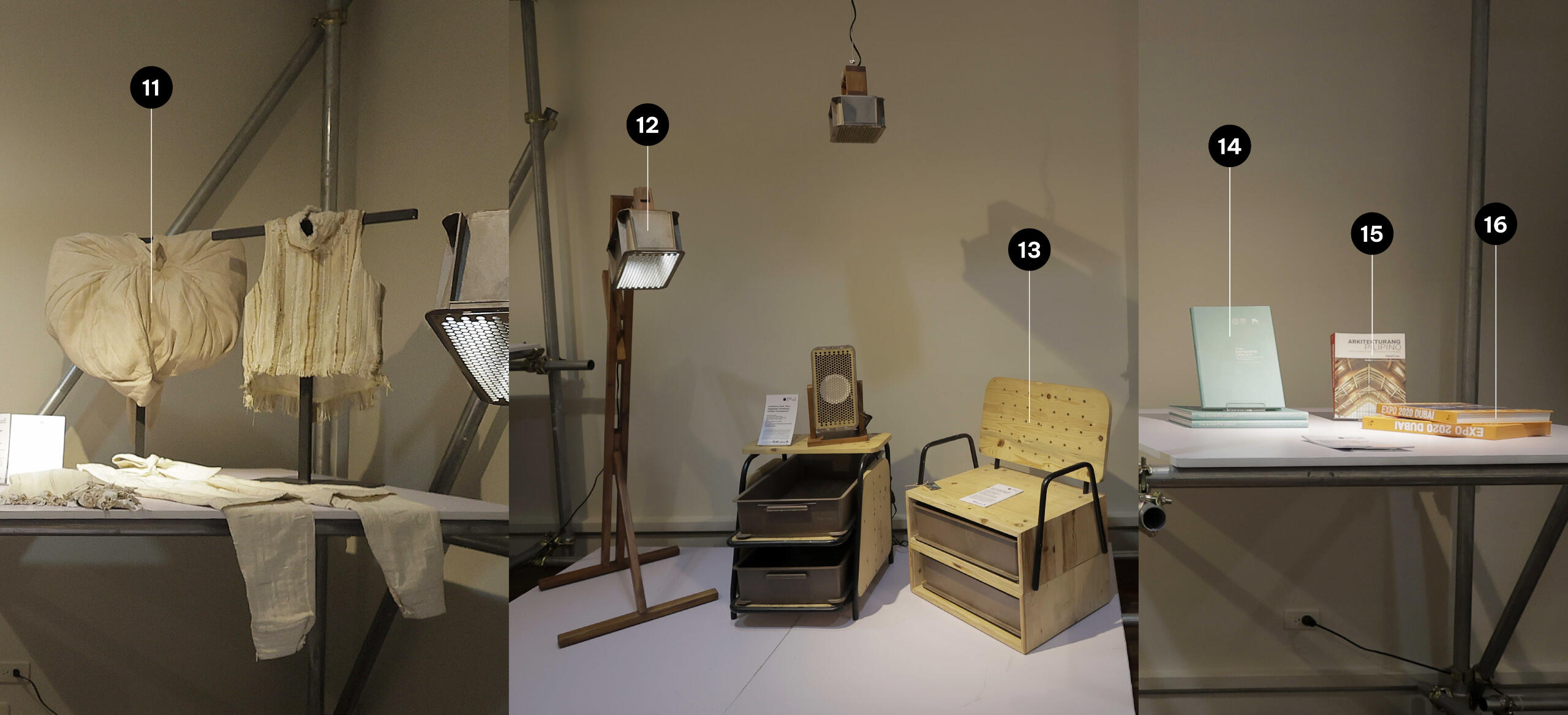
11
Garments, entitled “Spider Lily Collective”
Valdes Designs, design
The BAYO Foundation, manufacturing
Philippine Textile Research Institute, manufacturing
2022
Tailoring
Various sizes
Blend of bakong [Hanguana malayana (Jack) Merr.] and cottonThe fiber extracted from the perennial plant bakong [Hanguana malayana (Jack) Merr.] as material for clothing represents a major accomplishment for the Design Center. Combining with leftover fabrics from their workshop, Bea Valdes in partnership with BAYO transformed the bakong/cotton blended fabric into multifunctional pieces, which indicates the myriad possibilities in clothing for this new plant fiber source. The expected contribution to sustainable development goals is of considerable magnitude.
12
Luminaires (desk, floor, suspension variations), entitled “Contrapunto”
Stanley Ruiz, design
Contemporaneo, manufacturing
D&L Polymers & Colours, manufacturing
Sentinel Plastics, manufacturing
2022
Injection molding, wood working
Various sizes
Bio-composite (bins) of bakong [Hanguana malayana (Jack) Merr.], woodThe possibly industrial-scale use of the perennial plant bakong [Hanguana malayana (Jack) Merr.] as a material for injection molded containers represents a major accomplishment for the Design Center. The resulting bio-composite elements were designed into a lighting collection by Stanley Ruiz, in partnership with Contemporaneo, to demonstrate a single set of variations among myriad possibilities for this plant-based alternative to exhausted materials. The expected contribution to sustainable development goals is of considerable magnitude.
13
Chair and side table with drawers, entitled “BaCo”
Fortunato de la Peña Jr., design
BalaiKamay, manufacturing
D&L Polymers & Colours, manufacturing
Sentinel Plastics, manufacturing
2022
Injection molding, wood working
Various sizes
Bio-composite (crates) of bakong [Hanguana malayana (Jack) Merr.], wood, metal (frame)The possibly industrial-scale use of the perennial plant bakong [Hanguana malayana (Jack) Merr.] as a material for injection molded containers represents a major accomplishment for the Design Center. The resulting bio-composite elements were designed into a lighting collection by Stanley Ruiz, in partnership with Contemporaneo, to demonstrate a single set of variations among myriad possibilities for this plant-based alternative to exhausted materials. The expected contribution to sustainable development goals is of considerable magnitude.
14
Period documentation
“The Bangkota Legacy: The Republic of the Philippines at Expo 2020 Dubai”
2022
Full color offset printing, bookbinding
Paper and printers’ ink
Collection: Royal Pineda + Architecture and DesignThe Philippines Pavilion for the Dubai World Expo 2020 was the winning design out of a national competition for architecture and art direction, conducted by the Department of Trade and Industry for the country participation in this global platform. The proposal of Architect Pineda found merit with the jury for its argument of redefining authenticity for the Philippines. The pavilion, whose signature material was cyclone fencing, saw this ubiquitous fencing as authentically part of the experience of everyday Filipinos.
15
Period documentation
“Arkitekturang Pilipino: A History of Architecture and the Built Environment in the Philippines”
Volume 2 Post-colonial to Contemporary Era
Gerard Lico, Author
2021
Printing, bookbinding
25 × 6 × 18 cm
Paper and printers’ ink
Collection: Royal Pineda + Architecture and Design
16
Period documentation
“EXPO 2020 DUBAI”
2022
Full color offset printing, bookbinding
Paper and printers’ ink
Collection: Royal Pineda + Architecture and DesignThe Philippines Pavilion for the Dubai World Expo 2020 was the winning design out of a national competition for architecture and art direction, conducted by the Department of Trade and Industry for the country participation in this global platform. The proposal of Architect Pineda found merit with the jury for its argument of redefining authenticity for the Philippines. The pavilion, whose signature material was cyclone fencing, saw this ubiquitous fencing as authentically part of the experience of everyday Filipinos.
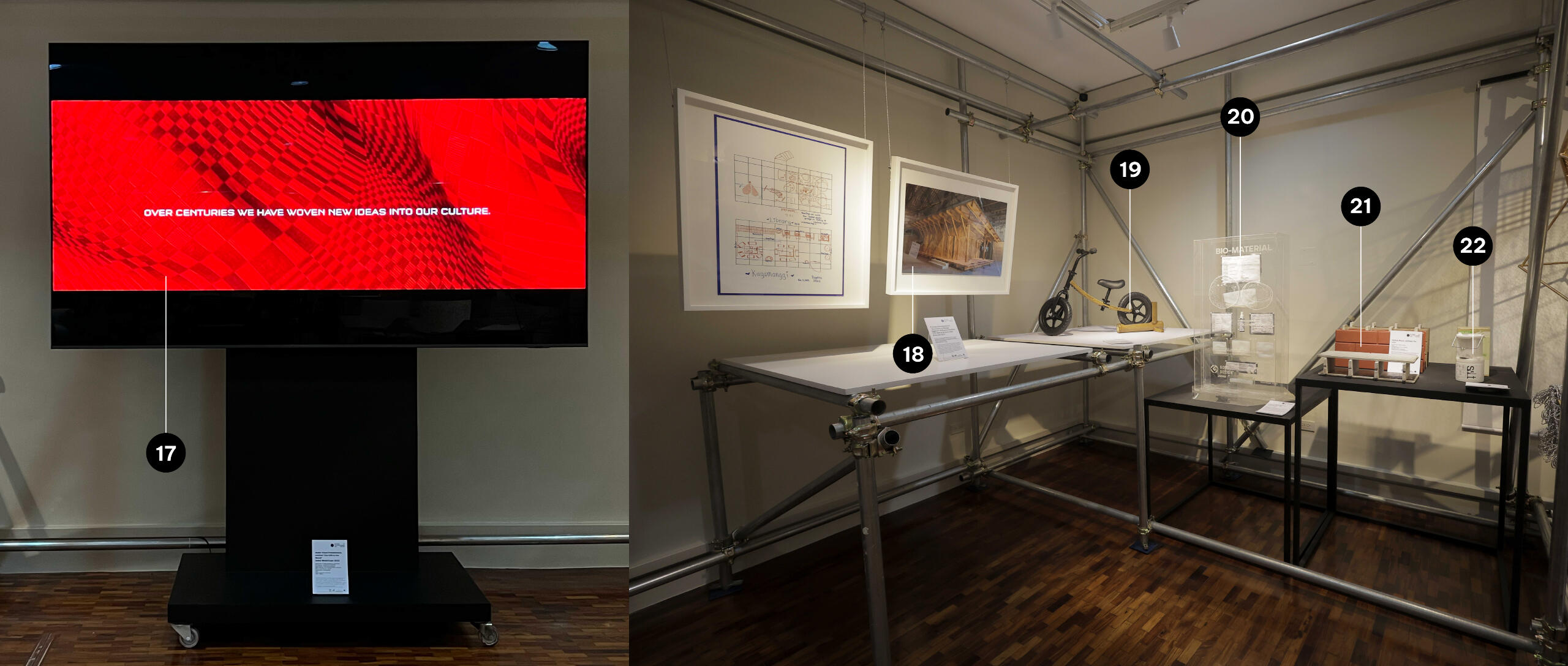
17
Audio Visual Presentation, entitled “Our Gift to the World”
Dubai World Expo 2020
Department of Trade and Industry, production
Rosvi Gaetos, administrative direction
Royal Pineda, art direction guidelines
BBDO Guerrero, line production and art direction
Marian Pastor Roces, curation
Denisa Reyes, choreography
2021
Video production, animation
1920 × 1080 px“Our Gift to the World” is an AVP produced and designed for an enormous project surface 2 stories high and more than 20 meters across. The gently curving surface added complications to the creative process, but all such challenges proved stimulating to the collaborators. The AVP endeavored to convey a totally refreshed narrative of Filipino emergence from deep time, based on sound science but through state-of-the-art choreographic and animation techniques.
18
Mock-up and project process documentation
“Structures of Mutual Support”
Philippine Pavilion, 17th Venice Architecture Biennale 2021
Architects Sudarshan Khadka and Eriksson Furunes, system/process design, in collaboration with the Bulacan Gawad Kalinga Enchanted Farm Community, to build a community library
Popsicle stick models and framed community outputThe architectural practice of Sudarshan Khadka and Eriksson Furunes approached a project to create a library for the Gawad Kalinga community by involving the community in the design process. The process of co-creation went well beyond stakeholder consultation. The future of architecture, shifting from the auteur tradition of Modernism, is being shaped by systems thinkers such as Khadka and Eriksson. This project was awarded by the Biennale for being an “exemplary community project that creates a rich archive and experience of collaborative construction practices.”
19
Mini-Bicycle, entitled “Bambino Bolt”
Bambike
2019
Woodworking, metalworking
89 × 40 × 64 cm
Wood, bamboo (Bambusa vulgaris), metal, rubber
Collection: BambikeOnce the idea of using the giant grass bamboo for unexpected design directions gained popularity, the application for bicycle design was one logical direction. The toddler’s bike furthers the logic, which sustains the simplicity of the underlying wisdom: an eminently renewal resource, bamboo, deserves to be regarded as the ideal material for as many applications as possible. The expected contribution to sustainable development goals is of considerable magnitude.
20
Coco cellulose wound dressing, entitled “CocoPatch”
Denver Chicano, inventor
2022
Proprietary process (production of bio-based cellulose
for medical and skincare application)
Various sizes
Plant material (bacterial cellulose in coconut media)
Collection: Patchmed Cosmetic TradingAwarded in 2023, CocoPatch uses coconut meat material for wound dressing. It will be possible to replace synthetic wound dressing in due course. This design direction has serious possibilities in a new ergonomics in health care. The expected contribution to sustainable development goals is of considerable magnitude.
21
Hollow Block, entitled “Po Lite”
Dr. Ria Liza C. Canlas, design
2019
Proprietary processes of making
20 × 40 × 10 cm
Proprietary mix of materials
Collection: Po Lite Technology Inc.New materials for building construction have been the object of intense research interest. The results have been promising, although, as in the case of Po Lite, the technological processes are normally kept as industrial secrets. The expected contribution to sustainable development goals is of considerable magnitude.
22
Lamp, entitled “SALt”
Sustainable Alternative Lighting Corp.
Aisa Mijeno-Labastilla, design
2015
Various processes of making
10 × 20.5 cm
Various materialsSALt’s lamp is built on metal-air battery technology. It uses salt water to generate electricity, enough to light the lamp. The design is addressed at such users as fishermen, who remain underserved by design efforts in the Philippines. SALt’s lamp is already replacing kerosene lamps, candles, and battery-powered lamps in poor communities, and among workers in civil society and those who work in corporate CSR projects.
Page 2 of 3
A project of

In partnership with

Reimagined Chairs
Gallery 25
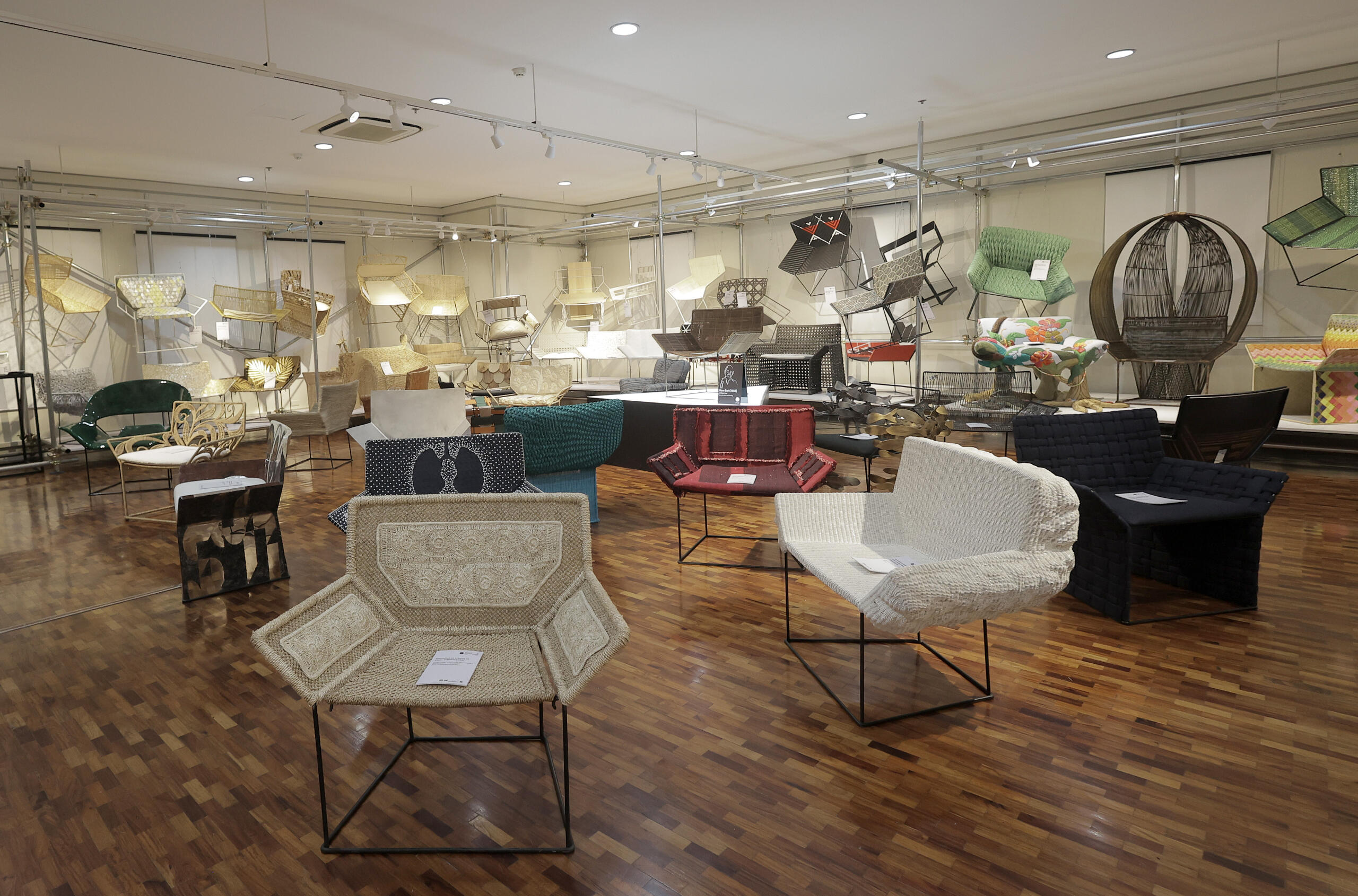
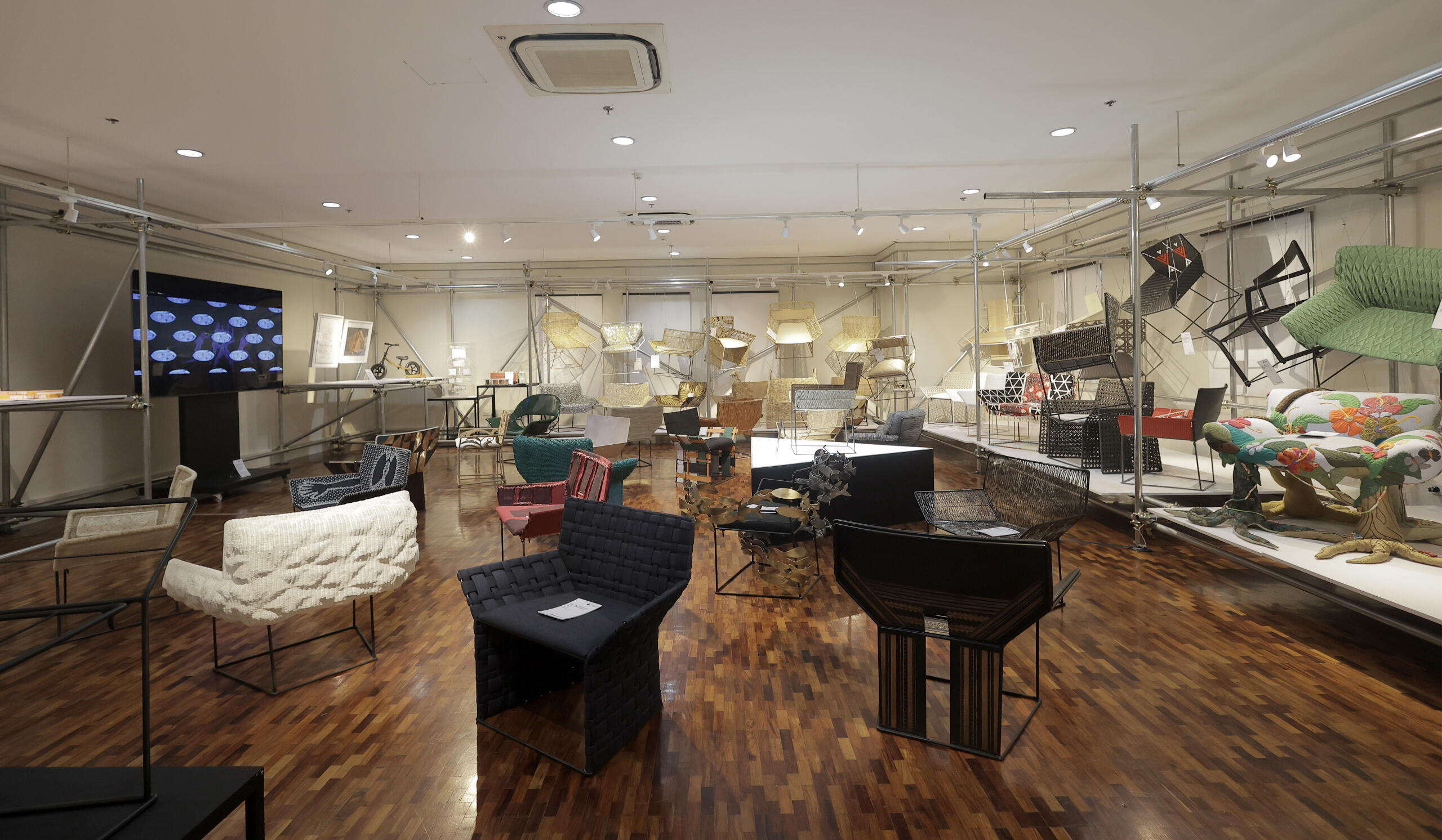
1
Chair, entitled “New Buri Chair”
Arturo Luz, design
c. 1980s
Woven burî (Corypha elata Roxb.) rattan (unknown variety), metal
Collection: Mary Josephine Cruz
2
Innovation on Arturo Luz Chair, entitled “Saro Lounge”
A. Garcia Crafts
2023
Woven polyolefin Italian rope
3
Innovation on Arturo Luz Chair, entitled “Cosmic Flora”
Aranáz
2023
Hand-embroidered panels of abaká (Musa textilis Neé) with raffia, straw, wood beads, and seashells shaped into floral motifs
4
Innovation on Arturo Luz Chair, entitled “Sampaguita Chair”
Betis Crafts, carving/manufacturing
JB Woodcrafts, design
2023
Solihiya (loose woven cane) and hand-carved wood
5
Innovation on Arturo Luz Chair, entitled “One Sun One Moon”
Bon Ace Fashion Tools Inc., manufacturing
Luisa Robinson, design
2023
Shell inlay
6
Innovation on Arturo Luz Chair, entitled “Etnik”
Calfurn
2023
Woven flat oval rattan core
7
Innovation on Arturo Luz Chair, entitled “De Nimes Homage”
Cebu Interlace
Francis Dravigny, direction
John Rey Sanchez, weaving
2023
Woven upcycled jeans, cotton, leather and abaká (Musa textilis Neé)
8
Innovation on Arturo Luz Chair, entitled “The Black Performance”
Coast Pacific Manufacturing Corporation
2023
Woven synthetic plastic
9
Innovation on Arturo Luz Chair, entitled “Tribu”
Contempo
2023
Scrap arurog with sika binding
10
Innovation on Arturo Luz Chair, entitled “Mohican”
Contemporaneo
2023
Wood mosaic
11
Innovation on Arturo Luz Chair, entitled “The Piña Chair”
Creative Definitions, textile manufacturing
Olivia d' Aboville, design
2023
Upholstered diamond pattern and hand painted piña fabric
12
Innovation on Arturo Luz Chair, entitled “Luz de Basey”
Delza's Native Products, manufacturing
Stanley Ruiz, design
2023
Woven tikog (Sagittaria sagittifolia Linn.), metal
13
Untitled innovation on Arturo Luz Chair
Finali
2023
14
Untitled innovation on Arturo Luz Chair
Gilded Expressions
2023
Woven metal
15
Innovation on Arturo Luz Chair, entitled “Pinya Silya”
GSG Group
2023
Woven pineapple (Ananas comosus) leaf fiber and rope
16
Innovation on Arturo Luz Chair, entitled “Arado (Rows in the Fields)”
Hacienda Crafts
2023
Woven lontók with bakbák binding
17
Innovation on Arturo Luz Chair, entitled “Maybellace (Maybe Lace)”
HoliCOWPH
2023
Weave-on-weave rattan-on-rattan
18
Innovation on Arturo Luz Chair, entitled “Piñacha”
Indigenous.ph, design and manufacturing
Stanley Ruiz, design
2023
Pinyapél paper twine and leatherized pinyapél fabric cushion
19
Innovation on Arturo Luz Chair, entitled “Felipe Chair”
Industria Edition
2023
Woven hammered metal strips and leather
20
Innovation on Arturo Luz Chair, entitled “Model LB-19261982”
Jinggoy Buensuceso
2023
Welded and sanded aluminum
21
Innovation on Arturo Luz Chair, entitled “Ang Syudad”
Junk Not
2023
Twined plastic waste
22
Innovation on Arturo Luz Chair, entitled “Sustainability meets Art… Uro”
Kanya Concept
2023
Fabric handwoven bagasse and cotton
23
Innovation on Arturo Luz Chair, entitled “Frequency Chair”
Ken Samudio
2023
Deadstock denim from Japan embellished with vintage and faux pearls
24
Innovation on Arturo Luz Chair, entitled “Heartbeat”
Larone Artisan
2023
Woven rope, abaká (Musa textilis Neé), bangkuáng [Pachyrhizus erosus (L.) Urb.], and crocheted raffia
25
Innovation on Arturo Luz Chair, entitled “C-418”
LIJA by That One Piece, design and manufacturing
Clark Mendoza, design
2023
Paper twine in pearlescent finish
26
Innovation on Arturo Luz Chair, entitled “Paperclip Chair”
Locsin International
2023
Laminated rattan on metal with woven polyethylene seat
27
Untitled Innovation on Arturo Luz Chair
MASAECO
2023
28
Innovation on Arturo Luz Chair, entitled “Alambrerang Bangkô”
MCCA / Vulcan Resources Inc.
2023
Textured metal woven with plastic from discarded PET bottles
29
Innovation on Arturo Luz Chair, entitled “Natalna”
More than a Chair
2023
Woven lampakanay and upholstery
30
Innovation on Arturo Luz Chair, entitled “Queen”
Nature’s Legacy, manufacturing
Lorenz Jose Patalinghug, design
2023
Molded Marmorcast
31
Innovation on Arturo Luz Chair, entitled “Oceania de Arturo Chair”
Neil Felipp
2023
Steel CNC, manual bending, soldering, and hand-painting
32
Innovation on Arturo Luz Chair, entitled “Palacio”
Obra Cebuana
2023
Woven rattan
33
Innovation on Arturo Luz Chair, entitled “Fatima Chair”
OMO Furniture
2023
Cross weaving in denim
34
Innovation on Arturo Luz Chair, entitled “Pulp and Paper Chair”
Tony Gonzales
2023
Pinyapél pulp
35
Innovation on Arturo Luz Chair, entitled “Scallops and Margarita Chair”
South Sea Veneer
2023
Wood
36
Innovation on Arturo Luz Chair, entitled “The Queen”
Patis Tesoro
2023
Handsewn retaso appliqués and tassels
37
Innovation on Arturo Luz Chair, entitled “Ang Paborito kong Upuan”
Prado Filipino Artisans, manufacturing
Tina Bonoan, design
2023
Woven metal wire
38
Innovation on Arturo Luz Chair, entitled “Central Chair”
Prizmic and Brill
2023
Camel leather and beige canvas with nickel hardware
39
Innovation on Arturo Luz Chair, entitled “inteRwoven”
Rags2Riches, manufacturing
Carla Mae Leonor, design
2023
Textile (cotton, vegan dyed leather), paracord
40
Innovation on Arturo Luz Chair, entitled “Peacock”
SC Vizcarra
2023
Woven wicker
41
Innovation on Arturo Luz Chair, entitled “Luz by Schema”
Schema
2023
Woven metal wire
42
Innovation on Arturo Luz Chair, entitled “LUZ Chair”
Shell Arts, design and manufacturing
Rachelle Dagñalan, design consultant
2023
Capiz lamination on steel
43
Innovation on Arturo Luz Chair, entitled “Lubid”
Shelmed Cottage Treasures, design and manufacturing
Rachelle Dagñalan, design consultant
2023
Crocheted abaká (Musa textilis Neé) rope
44
Innovation on Arturo Luz Chair, entitled “AR2RO CHAIR”
Vito Selma
2023
Wood and leather scraps
45
Innovation on Arturo Luz Chair, entitled “T’nalak Chair”
TADECO Home
2023
Abaká (Musa textilis Neé)
46
Innovation on Arturo Luz Chair, entitled “Araceli”
TN Philippines
2023
Capiz mosaic and polyresin
47
Innovation on Arturo Luz Chair, entitled “Paradise, WTF are you?”
Touch of Craft
2023
Recycled textiles
48
Innovation on Arturo Luz Chair, entitled “Gawan Accent Chair”
Triboa Bay
2023
Hand-carved reclaimed wood
49
Innovation on Arturo Luz Chair, entitled “Le Palm Chair”
Venzon Lighting, design and manufacturing
Josef Crisanto, design consultant
2023
Recycled steel from Le Palm chandelier in two tone finish
50
Innovation on Arturo Luz Chair, entitled “Monolith Cloud after AL”
Zacarias 1925 × Nazareno / Lichauco
2023
Woven rattan
51
Innovation on Arturo Luz Chair, entitled “Please Make One”
Locsin International
Tony Gonzales, design
2023
Outdoor polypropylene material
Page 3 of 3
A project of

In partnership with

Reimagined Chairs
Gallery 25
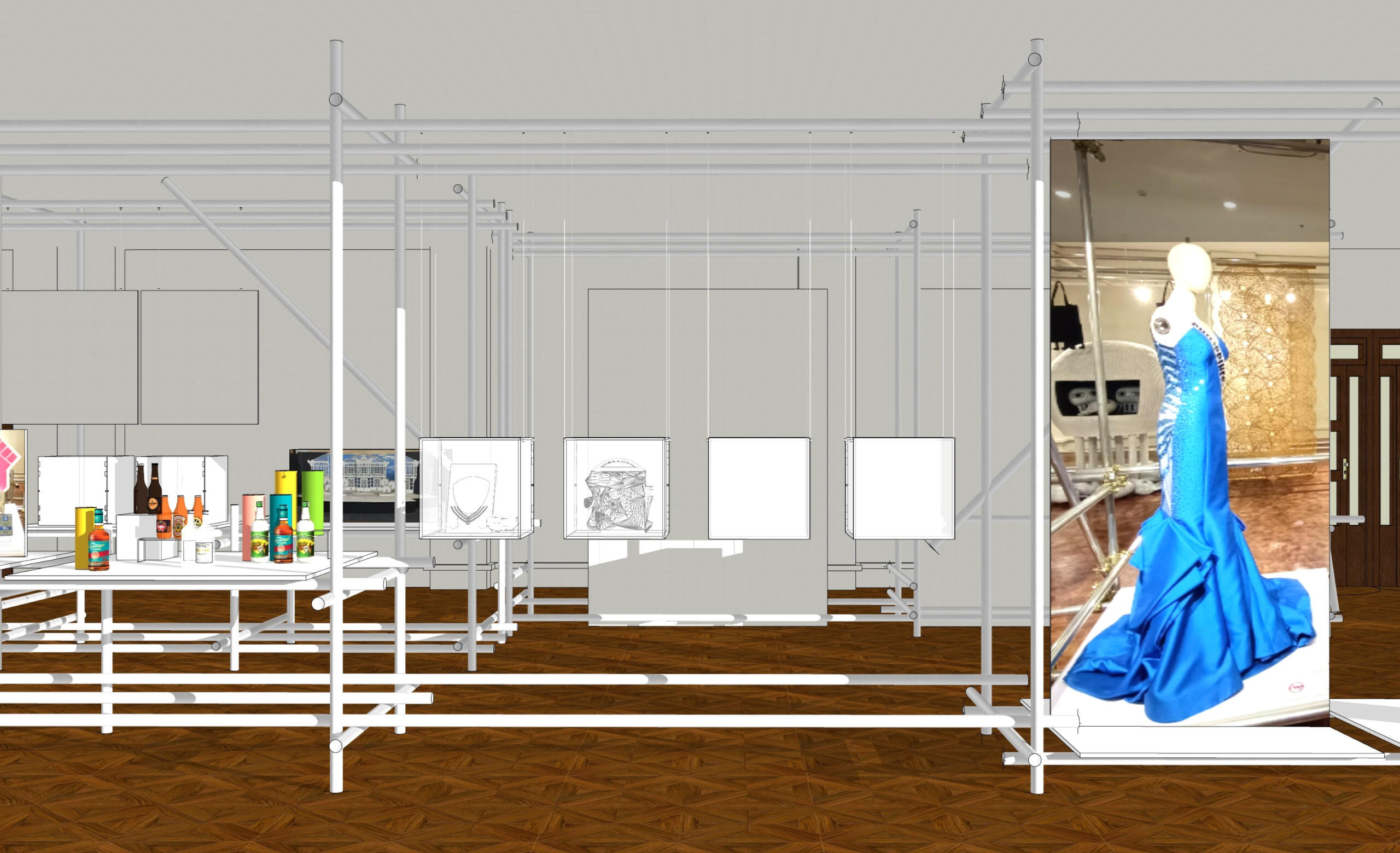
11
Innovation on Arturo Luz Chair, entitled “The Piña Chair”
Creative Definitions, textile manufacturing
Olivia d' Aboville, design
2023
Upholstered diamond pattern and hand painted piña fabric
12
Innovation on Arturo Luz Chair, entitled “Luz de Basey”
Delza's Native Products, manufacturing
Stanley Ruiz, design
2023
Woven tikog (Sagittaria sagittifolia Linn.), metal
13
Untitled innovation on Arturo Luz Chair
Finali
2023
14
Untitled innovation on Arturo Luz Chair
Gilded Expressions
2023
Woven metal
15
Innovation on Arturo Luz Chair, entitled “Pinya Silya”
GSG Group
2023
Woven pineapple (Ananas comosus) leaf fiber and rope
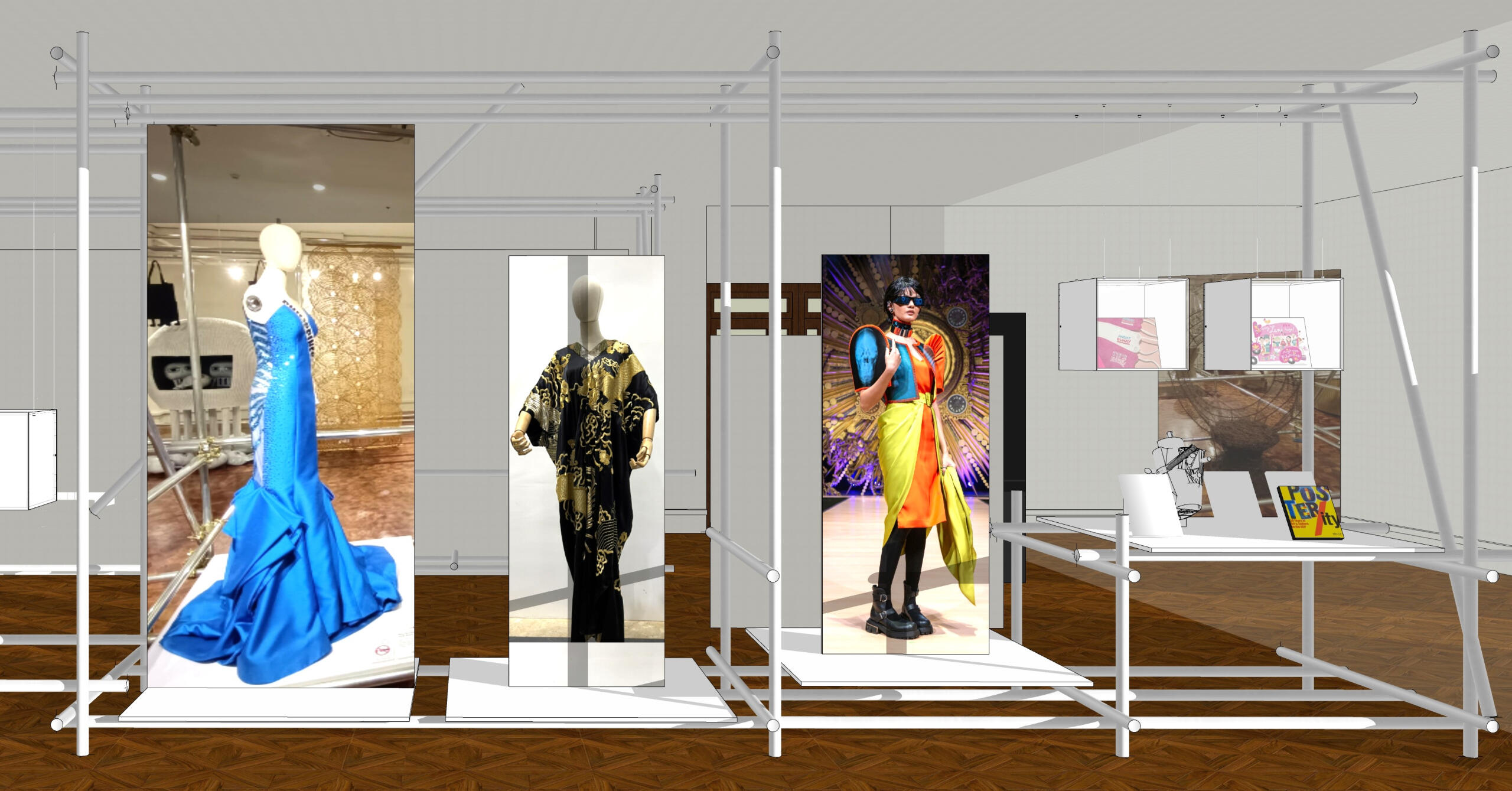
16
Innovation on Arturo Luz Chair, entitled “Arado (Rows in the Fields)”
Hacienda Crafts
2023
Woven lontók with bakbák binding
17
Innovation on Arturo Luz Chair, entitled “Maybellace (Maybe Lace)”
HoliCOWPH
2023
Weave-on-weave rattan-on-rattan
18
Innovation on Arturo Luz Chair, entitled “Piñacha”
Indigenous.ph, design and manufacturing
Stanley Ruiz, design
2023
Pinyapél paper twine and leatherized pinyapél fabric cushion
19
Innovation on Arturo Luz Chair, entitled “Felipe Chair”
Industria Edition
2023
Woven hammered metal strips and leather
20
Innovation on Arturo Luz Chair, entitled “Model LB-19261982”
Jinggoy Buensuceso
2023
Welded and sanded aluminum
Page 4 of 7
A project of

In partnership with

Reimagined Chairs
Gallery 25
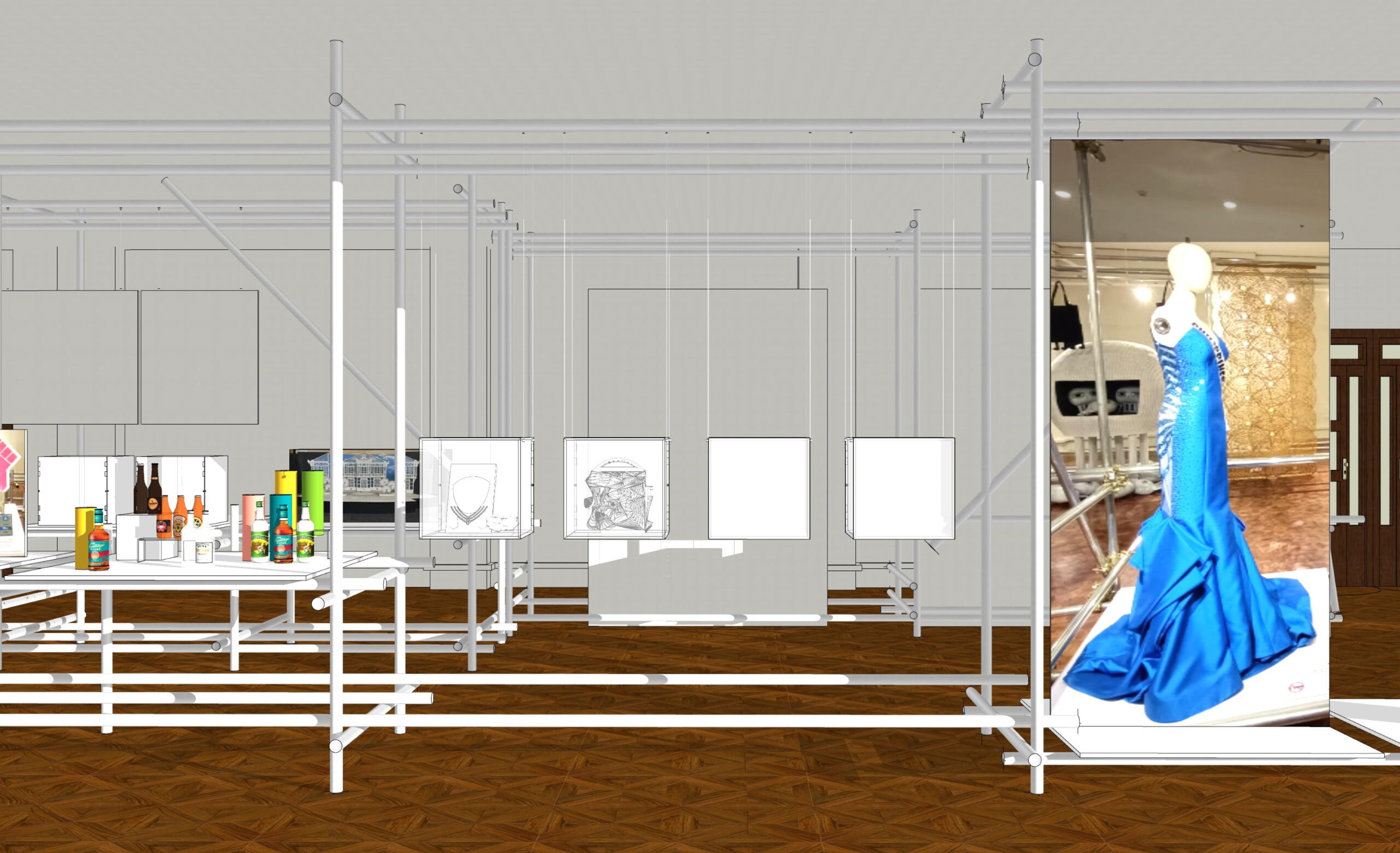
21
Innovation on Arturo Luz Chair, entitled “Ang Syudad”
Junk Not
2023
Twined plastic waste
22
Innovation on Arturo Luz Chair, entitled “Sustainability meets Art… Uro”
Kanya Concept
2023
Fabric handwoven bagasse and cotton
23
Innovation on Arturo Luz Chair, entitled “Frequency Chair”
Ken Samudio
2023
Deadstock denim from Japan embellished with vintage and faux pearls
24
Innovation on Arturo Luz Chair, entitled “Heartbeat”
Larone Artisan
2023
Woven rope, abaká (Musa textilis Neé), bangkuáng [Pachyrhizus erosus (L.) Urb.], and crocheted raffia
25
Innovation on Arturo Luz Chair, entitled “C-418”
LIJA by That One Piece, design and manufacturing
Clark Mendoza, design
2023
Paper twine in pearlescent finish
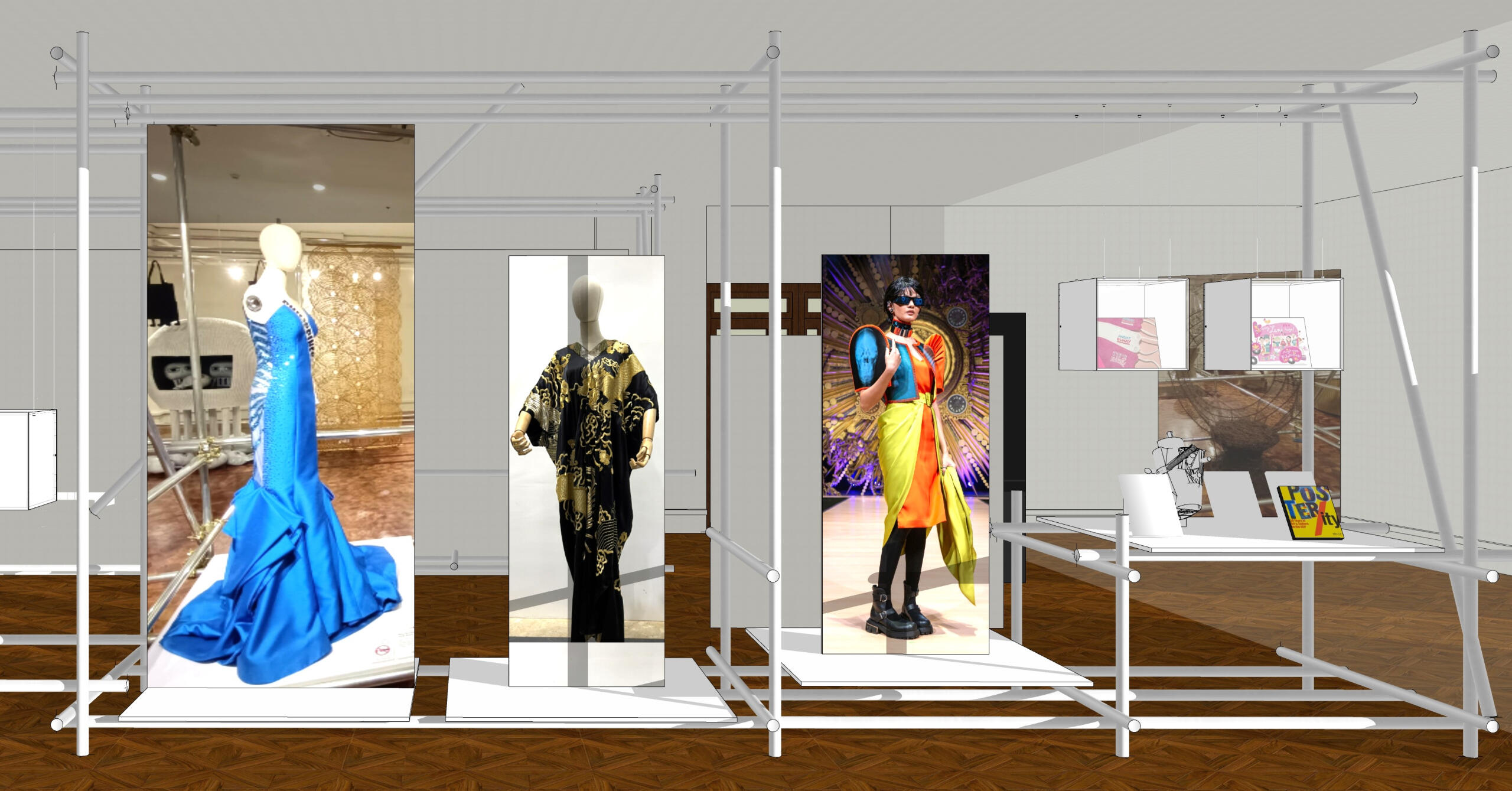
26
Innovation on Arturo Luz Chair, entitled “Paperclip Chair”
Locsin International
2023
Laminated rattan on metal with woven polyethylene seat
27
Untitled Innovation on Arturo Luz Chair
MASAECO
2023
28
Innovation on Arturo Luz Chair, entitled “Alambrerang Bangkô”
MCCA / Vulcan Resources Inc.
2023
Textured metal woven with plastic from discarded PET bottles
29
Innovation on Arturo Luz Chair, entitled “Natalna”
More than a Chair
2023
Woven lampakanay and upholstery
30
Innovation on Arturo Luz Chair, entitled “Queen”
Nature’s Legacy, manufacturing
Lorenz Jose Patalinghug, design
2023
Molded Marmorcast
Page 5 of 7
A project of

In partnership with

Reimagined Chairs
Gallery 25
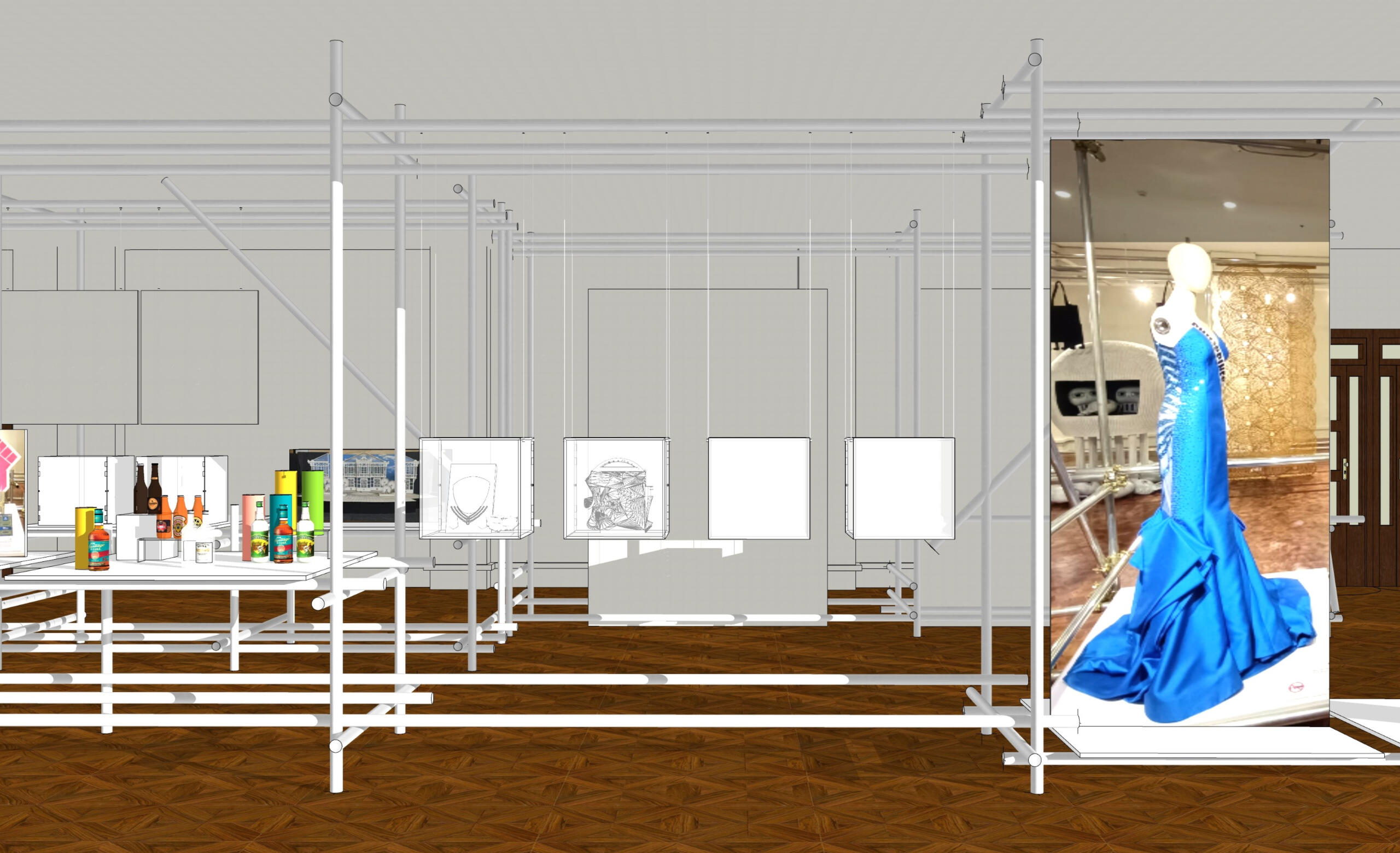
31
Innovation on Arturo Luz Chair, entitled “Oceania de Arturo Chair”
Neil Felipp
2023
Steel CNC, manual bending, soldering, and hand-painting
32
Innovation on Arturo Luz Chair, entitled “Palacio”
Obra Cebuana
2023
Woven rattan
33
Innovation on Arturo Luz Chair, entitled “Fatima Chair”
OMO Furniture
2023
Cross weaving in denim
34
Innovation on Arturo Luz Chair, entitled “Pulp and Paper Chair”
Tony Gonzales
2023
Pinyapél pulp
35
Innovation on Arturo Luz Chair, entitled “Scallops and Margarita Chair”
South Sea Veneer
2023
Wood
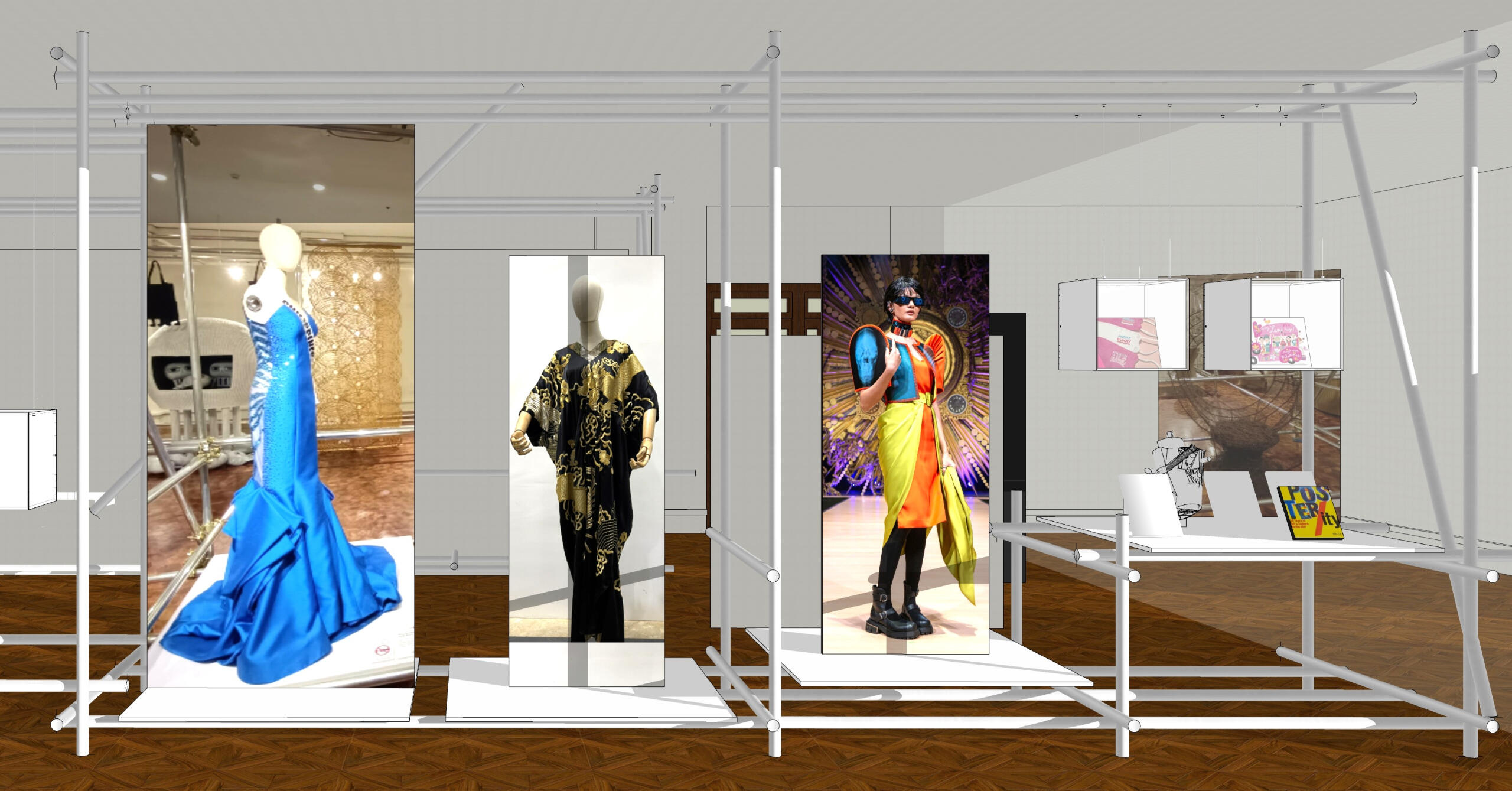
36
Innovation on Arturo Luz Chair, entitled “The Queen”
Patis Tesoro
2023
Handsewn retaso appliqués and tassels
37
Innovation on Arturo Luz Chair, entitled “Ang Paborito kong Upuan”
Prado Filipino Artisans, manufacturing
Tina Bonoan, design
2023
Woven metal wire
38
Innovation on Arturo Luz Chair, entitled “Central Chair”
Prizmic and Brill
2023
Camel leather and beige canvas with nickel hardware
39
Innovation on Arturo Luz Chair, entitled “inteRwoven”
Rags2Riches, manufacturing
Carla Mae Leonor, design
2023
Textile (cotton, vegan dyed leather), paracord
40
Innovation on Arturo Luz Chair, entitled “Peacock”
SC Vizcarra
2023
Woven wicker
Page 6 of 7
A project of

In partnership with

Reimagined Chairs
Gallery 25
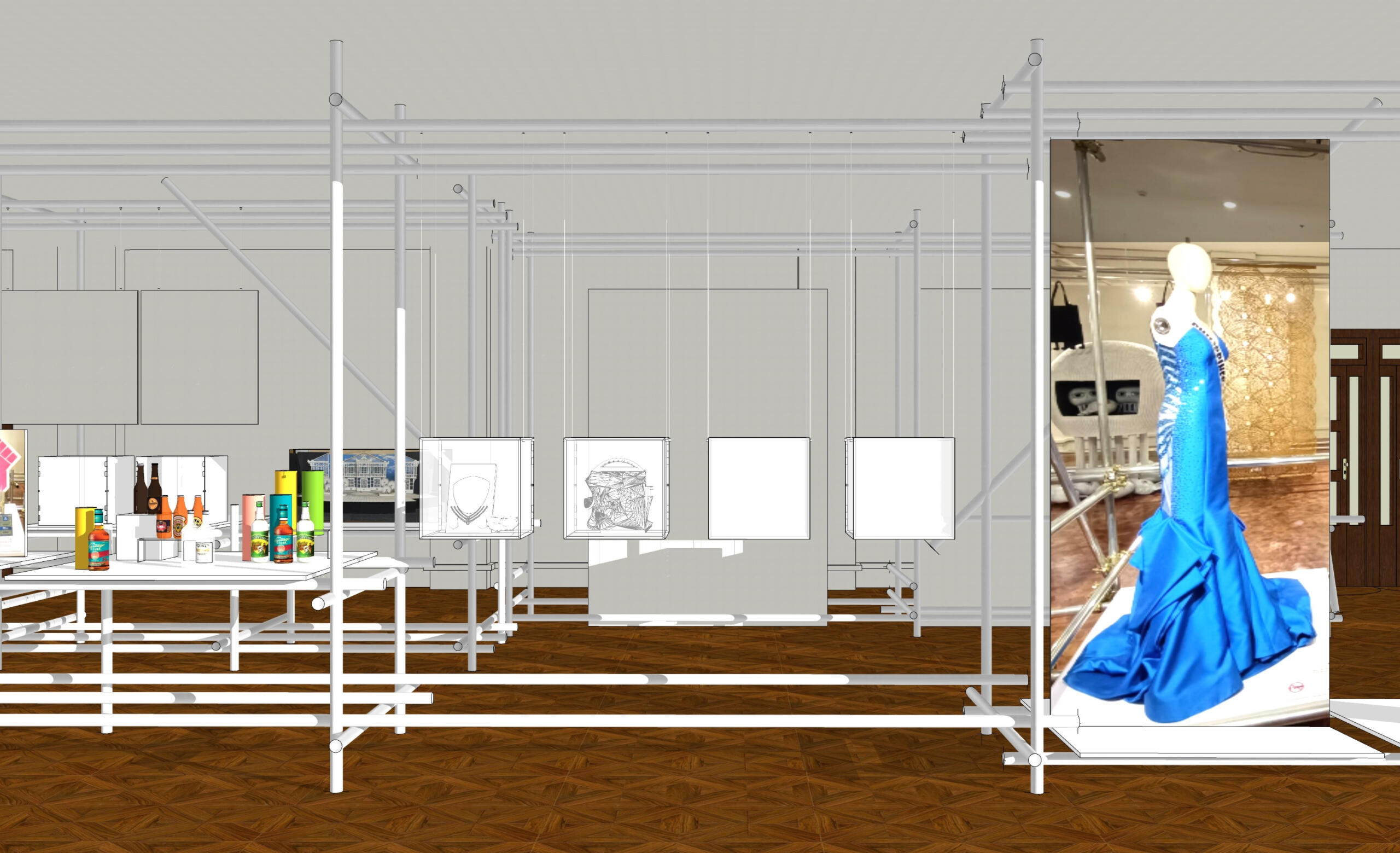
41
Innovation on Arturo Luz Chair, entitled “Luz by Schema”
Schema
2023
Woven metal wire
42
Innovation on Arturo Luz Chair, entitled “LUZ Chair”
Shell Arts, design and manufacturing
Rachelle Dagñalan, design consultant
2023
Capiz lamination on steel
43
Innovation on Arturo Luz Chair, entitled “Lubid”
Shelmed Cottage Treasures, design and manufacturing
Rachelle Dagñalan, design consultant
2023
Crocheted abaká (Musa textilis Neé) rope
44
Innovation on Arturo Luz Chair, entitled “AR2RO CHAIR”
Vito Selma
2023
Wood and leather scraps
45
Innovation on Arturo Luz Chair, entitled “T’nalak Chair”
TADECO Home
2023
Abaká (Musa textilis Neé)
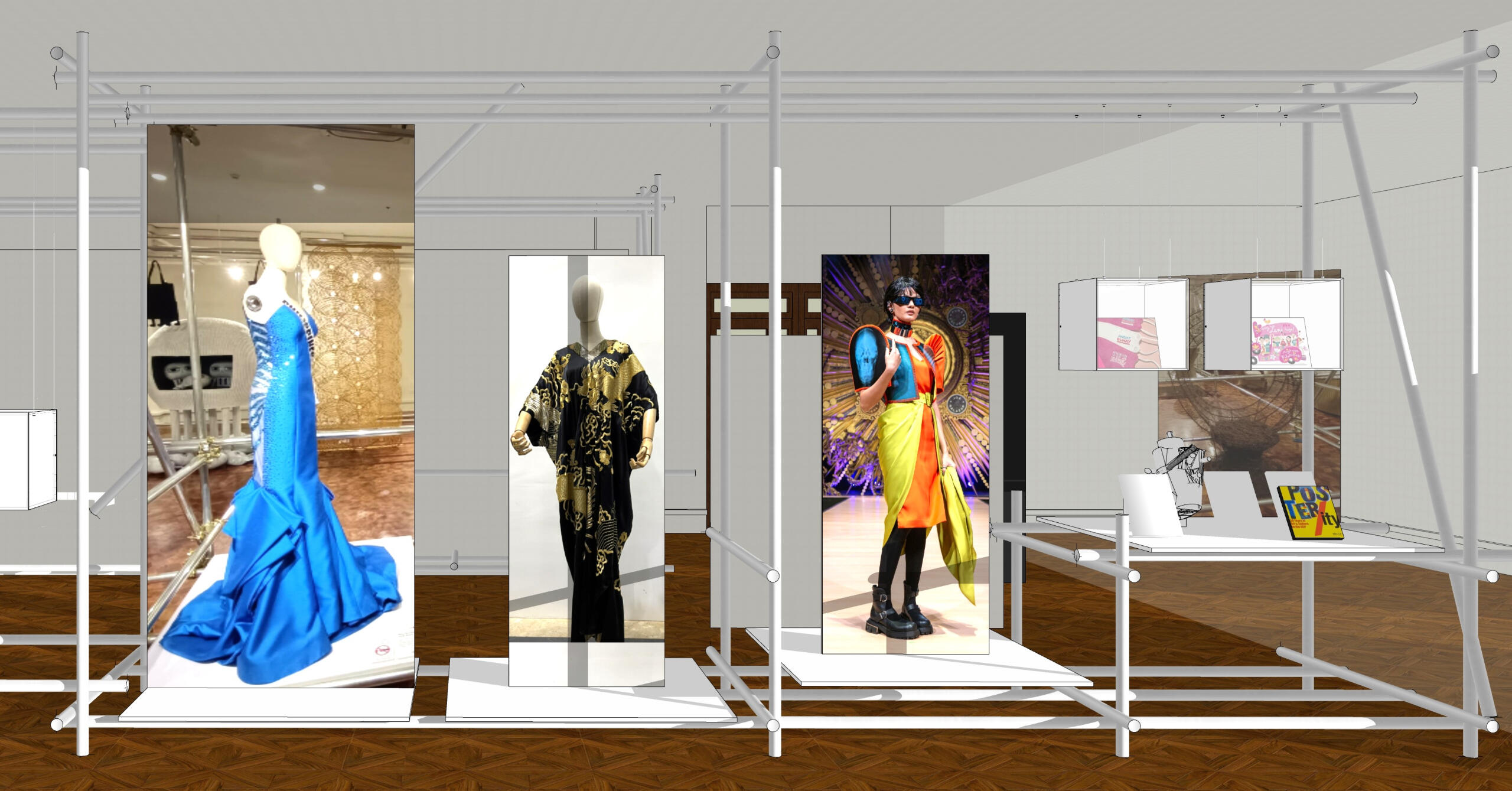
46
Innovation on Arturo Luz Chair, entitled “Araceli”
TN Philippines
2023
Capiz mosaic and polyresin
47
Innovation on Arturo Luz Chair, entitled “Paradise, WTF are you?”
Touch of Craft
2023
Recycled textiles
48
Innovation on Arturo Luz Chair, entitled “Gawan Accent Chair”
Triboa Bay
2023
Hand-carved reclaimed wood
49
Innovation on Arturo Luz Chair, entitled “Le Palm Chair”
Venzon Lighting, design and manufacturing
Josef Crisanto, design consultant
2023
Recycled steel from Le Palm chandelier in two tone finish
50
Innovation on Arturo Luz Chair, entitled “Monolith Cloud after AL”
Zacarias 1925 × Nazareno / Lichauco
2023
Woven rattan
51
Innovation on Arturo Luz Chair, entitled “Please Make One”
Locsin International
Tony Gonzales, design
2023
Outdoor polypropylene material
Page 7 of 7
A project of

In partnership with

National Artists
Hallway of Galleries 25 and 26
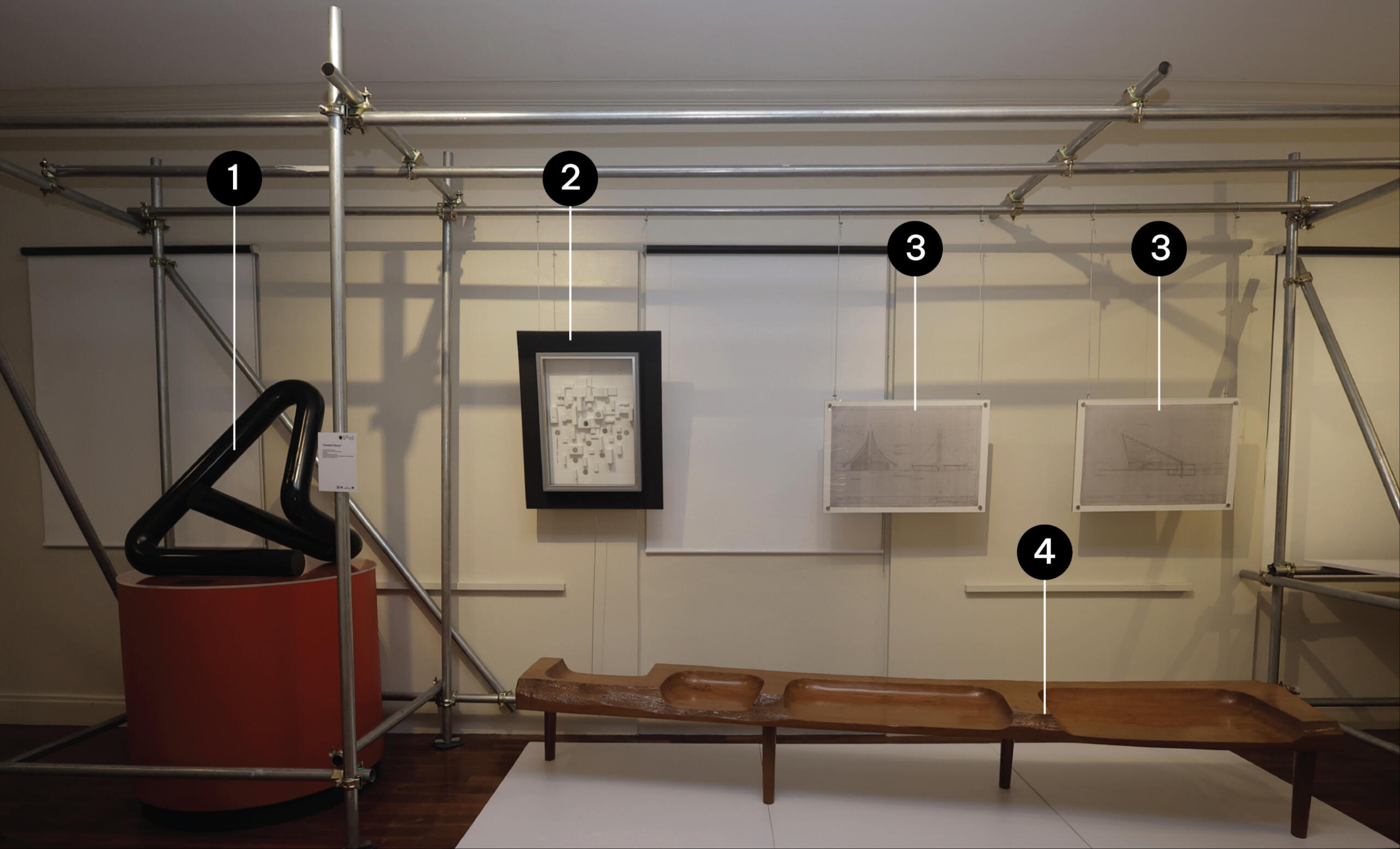
1
Untitled work from the “paperclip” series
Arturo Luz, design
Laureate, Order of National Artist
c. 1970s
Metalworking
19 × 25 × 17 cm
Metal (steel) tube in black paint surface finish
Collection: Design Center of the PhilippinesArturo Luz was already widely regarded as a remarkable painter, sculptor, and assemblage artist when he was tapped to be the founding Executive Director of the Design Center of the Philippines. He was also an aesthete whose commitment to Modernism found expression in elegant linearity and a consistent economy of means. His work for Design Center might be summarized by his series nicknamed the “paperclip” sculptures, for his design restraint and formal integrity.
2
“Circular Echoes”
Jerry Elizalde Navarro
Laureate, Order of National Artist
Undated
Assemblage/mixed media
Collection: National Fine Arts Collection of the National Museum of the Philippines
3
Blueprints of Philippine Pavilion EXPO 70, Osaka, Japan”
Leandro V. Locsin and Partners, design
Leandro V. Locsin
Laureate, Order of National Artist
1970
Collection: Leandro V. Locsin and PartnersAmong his other prestigious achievements, Architect Leandro V. Locsin was the designer of the Philippine Pavilion at the World Expo 1970 Osaka, Japan. The pavilion was recognized to be among the 10 most popular pavilions in this expo. The sweeping silhouette stood out amongst the country pavilions and by sheer design excellence projected a cultural coming-of-age for the Philippines in during the world’s late Modernism.
4
Bench
Sculpted wood
Napoleon Abueva, design
Laureate, Order of National Artist
Narra (Pterocarpus indicus)
2006
Collection: University of the Philippines College of Fine ArtsNapoleon "Billy" Abueva was the highly trained sculptor whose Modernist ambition was consistently made buoyant by humor and lightness of touch. His narra benches -- with multiple iterations of the same shallow indentation where seating is encouraged -- are regarded as masterpieces of Minimalism. However, more than embodying an internationally recognizable idiom, these benches simultaneously evoke a Filipino deadpan wit. Abueva strode in and out of the boundaries that separated the Fine Arts from design. He sculpted chairs and furnishings as often as he created the monumental sculptures that dot the Philippine urban landscape. The boundaries did not seem to exist for him, especially in that his personal aesthetics are palpable in everything he did.
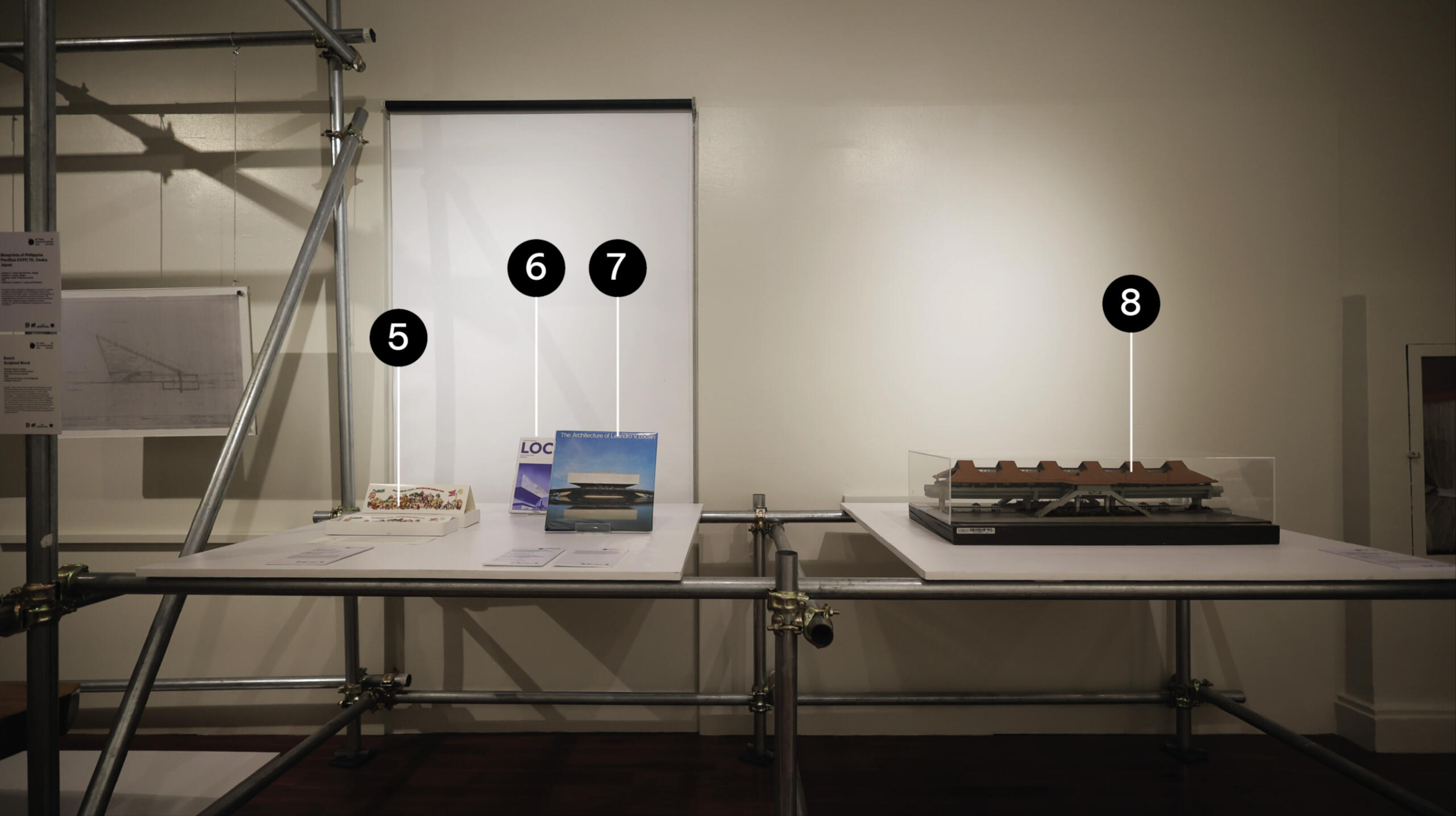
5
“Slice of Life” cartoons as Christmas card set
Lauro “Larry” Zarate Alcala, illustration
Laureate, Order of National Artist
c. 1980s
Illustration (cartooning)
Full color offset printing
Paper and printers’ ink
Collection: Nicole Carmel ObongLauro "Larry" Alcala, cartoonist and an art educator, was ubiquitous in Philippine life for his comic strips “Islaw Palitaw” and “Kalabog en Bosyo,” and his weekly cartoon series “Slice of Life,” originally published in the Weekend Magazine and The Sunday Times in newsprint. The cartoons made light of “the daily lives of Filipinos in a manner both critical of society while also lighthearted.” He was posthumously conferred the title of National Artist for Visual Arts in 2018.
6
Period documentation
“Leandro Valencia Locsin: Filipino Architect”
By Jean-Claude Girard
2021
Full color offset print, hardbound
28 × 22 × 3 cm
Paper, board, and printers’ ink
Collection: Leandro V. Locsin PartnersArchitect Leandro Locsin was the Philippines’ design superstar in the 1970s and 1980s. He set the International Style aesthetic that unified the buildings along Ayala Avenue, the city that was built from the ground up in the Makati grasslands by the Zobel de Ayala family. He gave Metropolitan Manila its iconic building in the Cultural Center of the Philippines. The singular Brutalist structure is distinguished by massive flange perimeter walls of a concrete aggregate that mixed in the sand and shells of the dredged reclamation site on which it stands.
7
Period documentation
“The Architecture of Leandro V. Locsin”
By Nicholas Polites
Akio Kawasumi, photographer
1977
Full color offset printing, hardbound
31 × 31 × 3 cm
Paper, board, and printers’ ink
Collection: Leandro V. Locsin PartnersArchitect Leandro Locsin was the Philippines’ design superstar in the 1970s and 1980s. He set the International Style aesthetic that unified the buildings along Ayala Avenue, the city that was built from the ground up in the Makati grasslands by the Zobel de Ayala family. He gave Metropolitan Manila its iconic building in the Cultural Center of the Philippines. The singular Brutalist structure is distinguished by massive flange perimeter walls of a concrete aggregate that mixed in the sand and shells of the dredged reclamation site on which it stands.
8
Maquette of the architectural design, Light Rail Transit station
Francisco Mañosa & Partners
Francisco Mañosa, design
Laureate, Order of National Artist
c. 1980s
Sculpted diorama representing built structure along LRT line
49 × 85 × 23 cm
Collection: Tukod Foundation, Inc.Throughout the entire arc of his career in architecture, Francisco Mañosa has successfully cited Filipino vernacular form. In his design for the Light Rail Transit stations, both the profile and the expanded proportion of the building—used as repeating form—are an iteration of peaked roof huts. Mañosa reworked the logic of such antique local architectural ideas into Modern translations, eventually in his “Coconut Palace” and other landmarks.
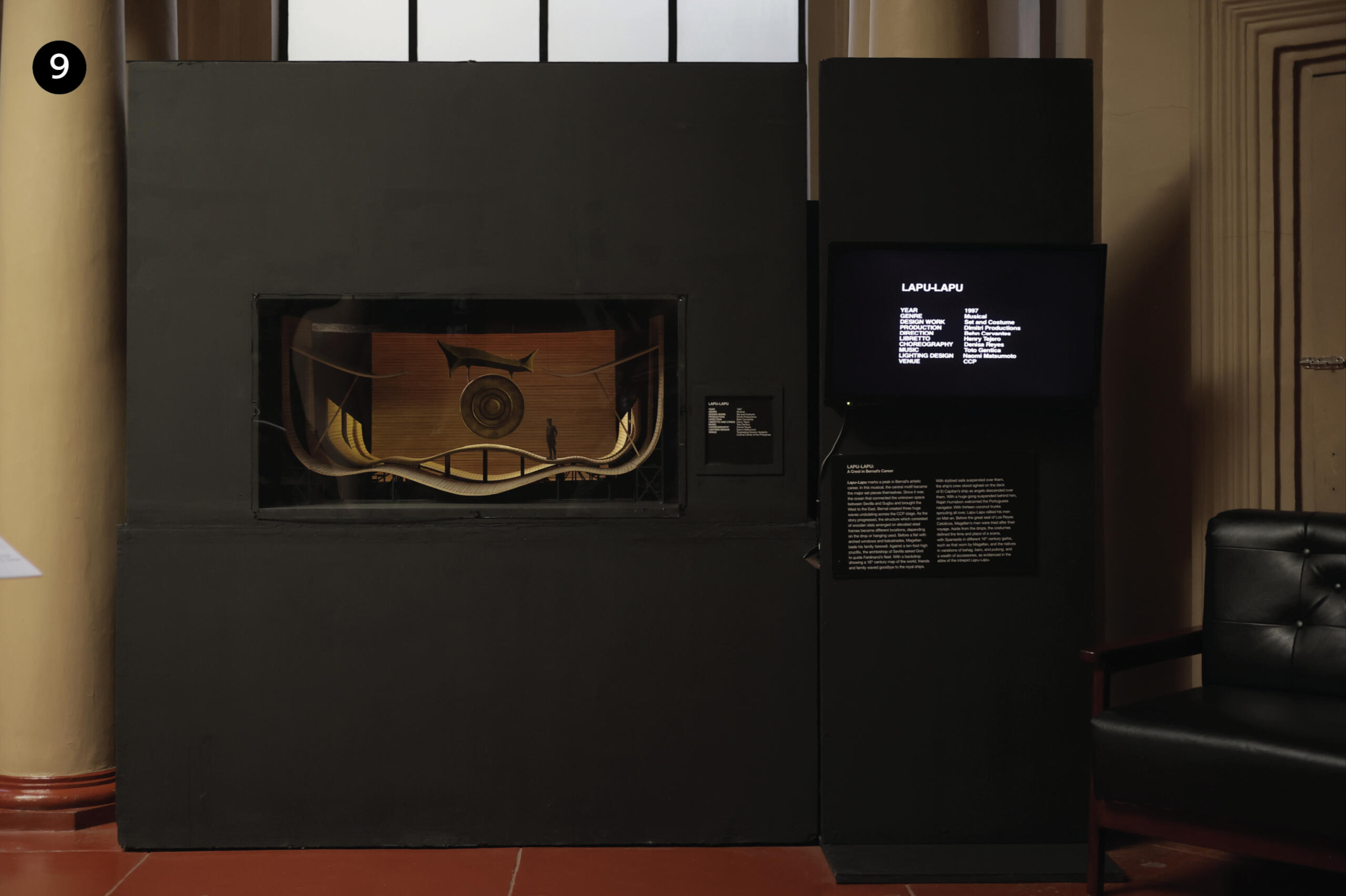
9
Production design maquette for the “Lapu-Lapu” musical
Salvador Bernal, design
Laureate, Order of National Artist
1997
Various processes of making
Various materials
Collection: Cultural Center of the Philippines,
Production Design and Technical Services DivisionSalvador Bernal had in his lifetime created an entire gamut of set designs for Philippines’ theater explorations. Known for his work with choreography (with dance companies) and theater (with several of the leading groups), Bernal was always polished, reliably forward-looking, and meticulous. His imagination was Modern: nothing traditional was seen in his theaterscapes. Nothing stereotypical, and, with great inventiveness, he staged Filipino narratives without drawing on precedent. Bernal is regarded as the artist who defined his field of practice.
Page 1 of 1
A project of

In partnership with

Peers of Arturo Luz
Hallway of Galleries 25 and 26
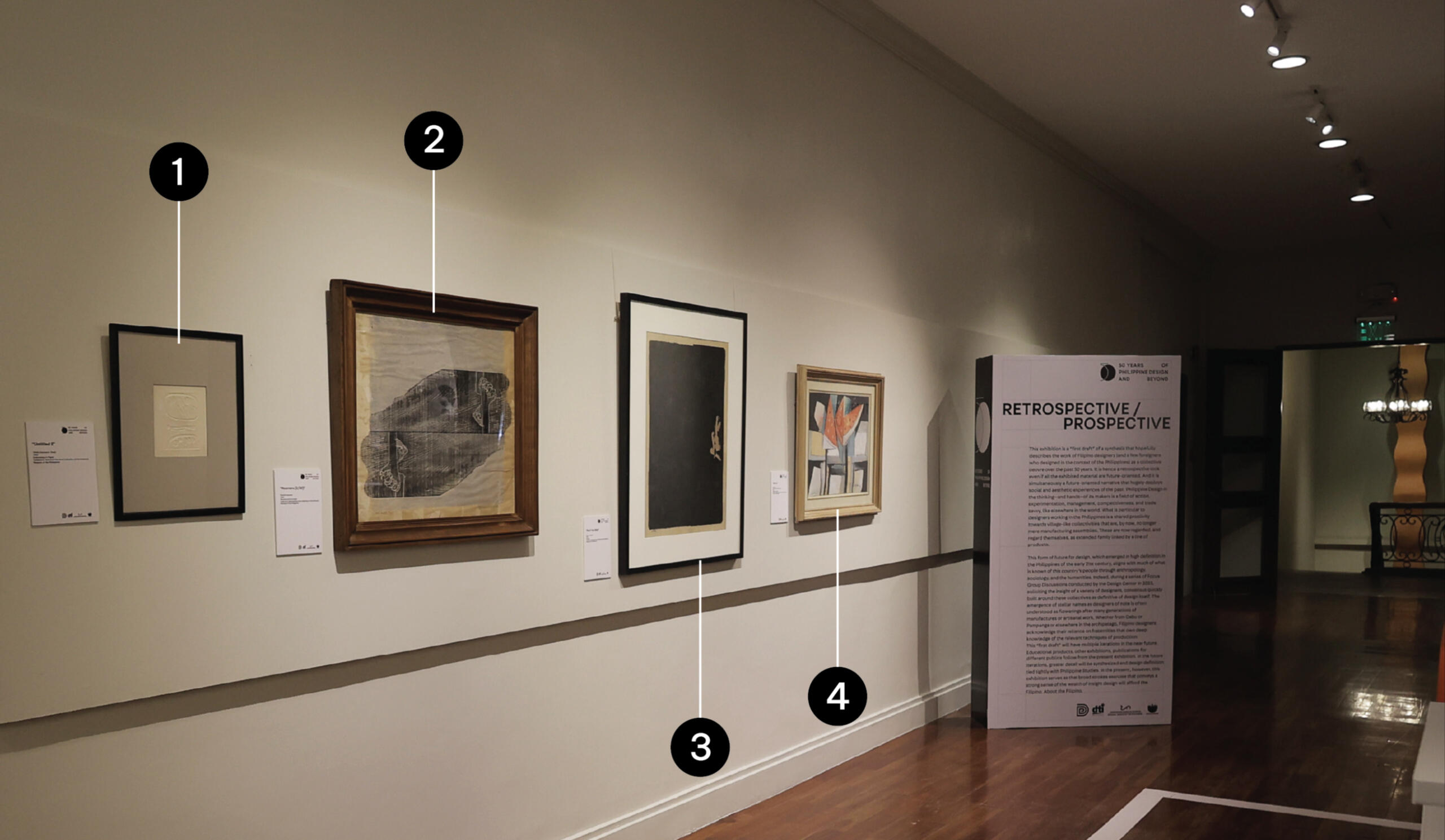
1
“Untitled II”
Ofelia Gelvezon-Tequi
1969
Embossing on paper
Collection: National Fine Arts Collection of the National Museum of the Philippines
2
“Mourners (2/30)”
Rodolfo Samonte
1968
Woodcut print on paper
Collection: National Fine Arts Collection of the National Museum of the Philippines
3
“Don’t You Wish”
Roberto Chabet
1964
Collage
Collection: National Fine Arts Collection of the National Museum of the Philippines
4
Still Life
Ang Kiukok
Laureate, Order of National Artist
1974
Watercolor on paper
Collection: National Fine Arts Collection of the National Museum of the Philippines
Page 1 of 1
A project of

In partnership with

Contributors
| NATIONAL ARTISTS |
| Designers | Exhibition Contributors | Item |
|---|---|---|
| Arturo Luz ✝ | Design Center of the Philippines | Sculpture |
| J. Elizalde Navarro ✝ | National Museum of Fine Arts | Painting |
| Napoleon Abueva ✝ | University of the Philippines College of Fine Arts | Bench |
| Leandro V. Locsin ✝ | Leandro V. Locsin Partners | Books Drawings |
| Lauro Alcala ✝ | Nicole Carmel Obong | Illustrations |
| Francisco Mañosa ✝ | Tukod Foundation Inc. | Toys Scale Model |
| Ang Kiukok ✝ | National Museum of the Philippines | Painting |
| Salvador Bernal ✝ | Cultural Center of the Philippines | Scale Model |
| Salvacion Lim Higgins ✝ | Slim’s Fashion and Art School Mark Higgins | Dress |
| SENATE SESSION HALL MEZZANINE (1973 - 2000) |
| Designers | Exhibition Contributors | Item |
|---|---|---|
| Eduardo de los Santos Castrillo ✝ | Marie Jeannie E. Javelosa | Jewelry |
| Azabache | Helena Carratala Katya Guerrero | Sketches |
| Jean Paul Gaultier Giovanni Sanna | Katya Guerrero | Contact Prints |
| Alfonso de Lange ✝ | Designs Ligna | Armchair |
| Arthur Edwards ✝ | Mehitabel Inc. | Chair |
| Kay de Lange | Design Center of the Philippines and the family of Alfonso and Kay de Lange | Vessels |
| Nelfa Querubin Jon and Tessy Pettyjohn Lorenzo Sarmiento Robert Galad Ronald Maceda | Design Center of the Philippines | Vessels |
| Ray Albano ✝ | Reinna Kris Calo and Jazmine Tena | Poster for Exhibition |
| Chiye Oshima ✝ | Paul Formaran | Jewelry |
| Steve Daplas | Design Center of the Philippines | Luminaire |
| National Museum of the Philippines In-house Artists | Design Center of the Philippines | Sketches |
| Cesar Hernando ✝ | Archivo 1984 Gallery | Poster for Movie |
| Lorenzo Larry Cruz ✝ | LJC Restaurant Group | Photograph Book |
| Sofronio H. Pasola Jr. ✝ | Design Center of the Philippines | Game |
| Robert “Boy” Yñiguez Alfred “Krip” Yuson Alfonso “Boy” Yuchengco | Joseph Lee Alviar | Ermita |
| Maria Cafra Band Vinyl Cover | Joseph Lee Alviar | Vinyl Record |
| Pacific Traders and Manufacturing Inc. | Pacific Traders and Manufacturing Inc. | Chair |
| Barge Ramos | Barge Ramos | Barong |
| Barge Ramos | Lulu Tan Gan | Barong Caftan |
| Innovation on the Maranao malong | Cultural Center of the Philippines | Malong |
| Bon Ace Fashion Tools Inc. | Bon Ace Fashion Tools Inc. | Buttons |
| Pedro Sepulveda, Jr. | Pedro Sepulveda, Jr. | Fashion Components |
| Val Padilla | Susan Abrera | Chair |
| Narda Capuyan ✝ | Narda’s Handwoven Arts & Crafts | Textile |
| Beatriz “Patis” Tesoro | Patis Tesoro Boutique | Textile |
| Antonio “Budji” Layug | Design Center of the Philippines | Armchair |
| Lor Calma | Hon. Anna Dominique M. L. Coseteng | Chair |
| Mark Mallari Lino Santiago | Design Center of the Philippines | Scale Model |
| Cesar Hernando ✝ Antipas Delotavo | Archivo 1984 Gallery | Poster for Movie |
| Reynaldo and Loreta Rafisura | Salay Handmade Products Inc. | Paper Products |
| Philippine Educational Theater Association | Cultural Center of the Philippines | Scale Model |
| Wig Tysmans | Wig and Carole Tysmans | Photograph |
| Betty Cobonpue | Design Center of the Philippines | Chair |
| Anaware Ceramics Jose Joya ✝ | Anaware Ceramics International Inc. | Plate |
| Vic Delotavo | Archivo 1984 Gallery | Poster for Movie |
| Lanelle Abueva-Fernando | Lanelle Abueva-Fernando Pottery | Vessels |
| Augusto Bigyan | Ugu Pottery | Vessels |
| Cesar Hernando ✝ Antipas Delotavo | Archivo 1984 | Poster for Movie |
| Nonoy Marcelo ✝ | Beda Requejo | Comic Book |
| Apolonio “Pol” Medina | Design Center of the Philippines | Comic Book |
| Gilda Cordaro Fernando ✝ Nik Ricio ✝ | Design Center of the Philippines | Coffee Table Books |
| Asin Vinyl Cover | Joseph Lee Alviar | Vinyl Record |
| Mask from the MassKara Festival | Raymond Alunan | MassKara Mask |
| Mercedes “Ched” Berenguer Topacio ✝ | Berenguer Topacio NOW | Folding Chair |
| Paulo Alcazaren | Paulo Alcazaren | Sketches |
| Yola Johnson | SouMak Collections | Rug |
| JB Woodcraft | JB Woodcraft | Armchair |
| Dom Martin Hizon Gomez, OSB | Filipino Vestments Collection of Transfiguration Abbey, Bukidnon | Chasubles |
| Michael Salientes and FINO Leatherwear | FINO Leatherware | Bags |
| The Women of KILUS Foundation | KILUS Foundation | Bags |
| Department 56 and Aranaz Family | Aranaz Family | Holiday Decors |
| Elisa Reyes | SouMak Collections | Weaving |
| Justino Arboleda, Ph. D | Juboken Enterprises Inc. | Coir Geotextile |
| Benji Reyes | Benji Reyes | Chair |
| Joel Enriquez | Joel Enriquez | Vessel |
| Gualberto “Rachy” Cuna | Gualberto “Rachy” Cuna | Book |
| Eduardo Yrezábal | Yrezábal & Co., Inc. | Chair |
| Neal Oshima | Neal Oshima | Photogram |
| Tony Gonzales | Locsin International | Chair |
| Ann Pamintuan | Center for International Trade and Expositions | Chair |
| Luisa Robinson | Luisa Robinson | Covered Vessel |
| Carlo Cordaro | Atelier A | Chair |
| Milo Naval | OMO Furniture | Daybed |
| Tes Pasola ✝ | Tony Gonzales | Floor Lamp |
| Tes Pasola ✝ and Paola Navone | Gervasione | Stools |
| Kenneth Cobonpue | Interior Crafts of the Islands Inc. | Chair |
| ARTURO'S PEERS |
| Designers | Exhibition Contributors | Item |
|---|---|---|
| Roberto Chabet ✝ Rodolfo Samonte Ofelia Gelvezon-Tequi | National Museum of the Philippines | Paintings |
| GALLERY 26 (2001 - 2023) |
| Designers | Exhibition Contributors | Item |
|---|---|---|
| Richard Frinier | DEDON Manufacturing, Incorporated | Chair |
| Pedro Delantar Jr. | Nature’s Legacy | Chair and Stool |
| Al Caronan | TN Philippines | Material Swatches |
| Wataru Sakuma | MASAECO | Paper Panels |
| Dex Fernandez and Bumi and Ashe | Bumi and Ashe | Vessels |
| Dex Fernandez and Rita Nazareno | Zacarias 1925 | Study Table |
| Dex Fernandez | Dex Fernandez | Bags Balloons |
| Gino Gonzales | Gino Gonzales | Scale Model |
| John Chua ✝ | AdPhoto Inc. | Photograph |
| Carlo Vergara | Carlo Vergara | Merch |
| Budjette Tan and Kajo Baldisimo | Kajo Baldisimo and Avenida Books | Comic Books |
| Rajo Laurel Rags2Riches | Rags2Riches | Bags |
| Team Manila | Team Manila | Apparel Lightbox |
| Neil Felipp San Pedro | Neil Felipp | Bags |
| Bea Valdes | Valdes Designs | Bags Jewelry |
| Miguel Carlos Aguas | Vulcan Resources / MCCA | Luminaire |
| Annaliza Angcoy Maricris Floirenda-Brias | TADECO Home | Textile Stool |
| Christina Borromeo-Gaston | Hacienda Crafts | Luminaire |
| Felix Mago Miguel Jr. | Felix Mago Miguel Jr. | Books |
| B+C Design | Design Center of the Philippines | Book |
| Karl Castro | Design Center of the Philippines | Book |
| Stanley Ruiz | MASAECO | Audio Speaker |
| Lulu Tan Gan | Lulu Tan Gan | Caftan |
| Rurungan sa Tubod Foundation Inc. | Rurungan sa Tubod Foundation Inc. | Textile |
| Ito Kish | Ito Kish | Chair |
| Jude Tiotuico | Industria Edition | Chair |
| Bon Ace Fashion Tools Inc. | Bon Ace Fashion Tools Inc. | Table |
| George Tapan | George Tapan | Photograph |
| Vito Selma | Design Studio Vito Selma | Table |
| Celia Jiao | Schema | Luminaire |
| Juanito ‘QUICCS’ Maiquez | QUICCS | Toys |
| Mark Nicdao | Mark Nicdao | Photograph |
| Eduardo Calma | Lor Calma and Partners | Scale Model |
| Kate Spade Amina Aranaz | ARANÁZ | Bags |
| Gil Zaire “Butch” Carungay | ZAI Design Hive | Jewelry |
| Dan Matutina Bernice De Leon-Yumul Raxenne Maniquiz Joanna Malinis Craig Halili Mandy Reyes AJ Dimarucot Kay Aranzanso Ralph Guibani | Dan Matutina | Apparel Merch |
| Dan Matutina Raxenne Maniquiz Craig Halili | Theo and Philo Artisan Chocolates | Packaging |
| Mark Ocampo | Auro Chocolate | Packaging |
| Lemuel Abron | Lemuel Abron | Packaging |
| Olive Enriquez | Capistrano Distillery | Packaging |
| Destileria Limtuaco & Co. | Destileria Limtuaco & Co. | Packaging |
| Stranger & Stranger Sam Penaso Joseph M. Ingking | Bleeding Heart Rum Company | Packaging |
| Hans Brumann | Hans Brumann | Jewelries |
| Mark Wilson | Caro Wilson | Jewelry |
| Ken Samudio | Ken Samudio | Bag |
| At Maculangan | At Maculangan | Photograph |
| Josie Natori | Natori | Lounge Wear |
| Glyn Alley Magtibay | Cultural Center of the Philippines | Terno |
| Albert Andrada | Albert Andrada | Gown |
| Olivia d’Aboville | Olivia d’Aboville | Luminaire |
| Leeroy New | Leeroy New | Vessel |
| Tarantadong Kalbo | Tarantadong Kalbo | Illustration |
| Kadangyan Band Dr. Ma. Lourdes Veneracion and Michael Albert Rallonza | Design Center of the Philippines | Photograph |
| GALLERY 25 (REIMAGINED DESIGN FUTURES) |
| Designers | Exhibition Contributors | Item |
|---|---|---|
| Hineleban Foundation | Hineleban Foundation Inc. | System Design |
| Creative Definitions | Creative Definitions Reginald James Sanchez | Graphics Treatment |
| BAYO | BAYO | Textile |
| Bakong | ||
| Fortunato de la Pena Jr. and BalaiKamay | Design Center of the Philippines | Furniture |
| D&L Polymers & Colours | Design Center of the Philippines | Bio-composite Crates and Bins |
| Sentinel Plastics | Design Center of the Philippines | Bio-composite Crates and Bins |
| Valdes Designs and BAYO and Philippine Textile Research Institute | Design Center of the Philippines | Clothing |
| Stanley Ruiz and Contemporaneo | Stanley Ruiz | Luminaire |
| Pinyapel | ||
| Ideatechs Packaging Corp. | Design Center of the Philippines | Packaging |
| TADECO Home | Design Center of the Philippines | Nesting Boxes |
| GSG by Flora Creatives | Design Center of the Philippines | Placemat |
| Creative Definitions | Design Center of the Philippines | Sneakers |
| Lulu Tan-Gan and TADECO Home | Design Center of the Philippines | Caftan |
| Stanley Ruiz | Stanley Ruiz | Lamps |
| Royal Pineda + Architecture and Design | Royal Pineda + Architecture and Design | Books |
| Bambike | Bambike | Mini-Bicycle |
| SALt Lamp | Sustainable Alternative Lighting Corp. | Lamp |
| Po Lite Technology Inc. | Po Lite Technology Inc. | Hollow Block |
| Denver Chicano | Patchmed Cosmetic Trading | Wound Dressing |
| Sudarshan Khadka Eriksson Furunes | Sudarshan Khadka Eriksson Furunes | Sketches |
| BBDO Guerrero | Department of Trade and Industry | AVP |
| GALLERY 25 (THE FUTURE TODAY) |
| Arturo Luz ✝ | Mary Josephine Cruz | Chair |
| A. Garcia Crafts Aranáz Bon Ace Fashion Tools Inc. and Luisa Robinson Calfurn Cebu Interlace and Francis Dravigny and John Rey Sanchez Coast Pacific Manufacturing Corp. Contempo Contemporaneo and Stanley Ruiz Creative Definitions and Olvia D’ Aboville Grgic Delza’s Native Products and Stanley Ruiz Finali Gilded Expressions GSG Group Hacienda Crafts HoliCOW Indigenous PH and Stanley Ruiz Industria Edition JB Woodcraft Inc. and Betis Crafts Jinggoy Buensuceso Junk Not Kanya Concept Ken Samudio Larone Artisans Lija by That One Piece and Clark Mendoza Locsin International MASAECO MCCA / Vulcan Resources More Than a Chair Nature’s Legacy x Lorenz Jose Patalinghug Neil Felipp Obra Cebuana OMO Furniture One of T Beatriz "Patis" Tesoro Prado Filipino Artisans and Tina Bonoan Prizmic and Brill Rags2Riches and Carla Mae Leonor SC Vizcarra Schema Shell Arts and Rachelle Dagñalan Shelmed Cottage Treasures and Rachelle Dagñalan South Sea Veneer Vito Selma TADECO Home TN Philippines Tony Gonzales Touch of Craft Triboa Bay Venzon Lighting & Objects and Josef Crisanto Zacarias 1925 x Nazareno / Lichauco |
| SPECIAL THANKS TO |
| Director - General Jeremy Barns Deputy Director - General Jorell Legaspi Caroline Marie Duque Renielle Soriano - Rogel Danelyn Sumaylo Laarni Montemayor | National Museum of the Philippines |
| Marian Pastor - Roces | Curator |
| Ar. Royal Pineda Ar. Onet Coronel Ar. Ryan Ray Salvador IDr. Martin Javellana Ar. David Radones Sabina Gonzales | Exhibition Designers Royal Pineda + |
| Jo Malinis | Logo Design |
| Team Manila Design Studio | Visual Communications Design |
| Paul Formaran Marion Descallar | Researchers |
| Mark Higgins Li-J Eleazar | Slim’s Fashion and Art School |
| Ricardo Eric Cruz Nestor Noviza Renee Manay | Cultural Center of the Philippines - Production and Design Division |
| Dean Marc San Valentin Lisa Ito - Tapang | University of the Philippines College of Fine Arts |
| Amihan Abueva Isabel Diwata Abueva | Abueva Family |
| Dr. Marti Magsanoc | Archivo 1984 Gallery |
| Agnes Amarra Gabriel Francisco Amarra | Frame of Mind |
| Ronnie De Guia | Albert Andrada |
| Nicolaas de Lange Miguel de Lange | Designs Ligna |
| Lucia Capuyan-Catanes Ma Andrea Mangusan | Narda’s Handwoven Arts & Crafts |
| Editha Santiago Elsa Barroca | KILUS Foundation |
| Pamela Bosques Roisin Fitzgerald | Josie Natori |
| Nina Tesoro | Patis Tesoro Boutique |
| Kenneth Cobonpue | KENNETH COBONPUE |
| Milo Naval | OMO Furniture |
| Anthony Carl Gonzales | One of a T |
| Angel Guerrero | Adobo Magazine |
| Lino Buñag | Former Division Chief Design Center of the Philippines |
| Nenita Dulay | Former Promotions Chief Design Center of the Philippines |
| Joel Enriquez | Former Design Division Chief Design Center of the Philippines |
| Fe Gonzales | Former Research Division Chief Design Center of the Philippines |
| Mary Josephine Cruz | Former Policy and Planning Unit and Resource Center Focal Person Design Center of the Philippines |
| Maria Rita O. Matute | Office of the Executive Director Design Center of the Philippines |
| Lucky Lopez | Office of the Deputy Executive Director Design Center of the Philippines |
| Lourdes Mendoza | Finance Division Design Center of the Philippines |
| Analiza Perez | Administrative Services Division Design Center of the Philippines |
| Larry James Francisco | Graphics and Exhibition Division Design Center of the Philippines |
| Gilda Dela Cruz | Promotions Division Design Center of the Philippines |
| Nikko Delos Reyes | Research Division Design Center of the Philippines |
| Carla Mae Leonor | Design Services Division Design Center of the Philippines |
A project of

In partnership with































